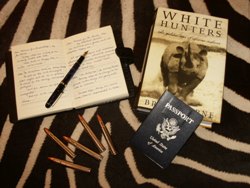

 The Accurate Reloading Forums
The Accurate Reloading Forums  THE ACCURATE RELOADING.COM FORUMS
THE ACCURATE RELOADING.COM FORUMS  Hunting
Hunting  Hunting Reports - Africa
Hunting Reports - Africa  BVC Father/Son PG Hunt + Lion Research Project
BVC Father/Son PG Hunt + Lion Research ProjectGo  | New  | Find  | Notify  | Tools  | Reply  |  |
| one of us |
DATE OF HUNT May-June 2013 HUNTERS Bill (father) & Brett (son) Email: bcamp@comcast.net GAME HUNTED Plainsgame (Eland, Kudu, Zebra, Wildebeest, Impala, Warthog, Bushpig) LOCATION Bubye Valley Conservancy (BVC), Zimbabwe Chamalaya & Ngali Camps HUNTING TEAM Professional Hunter: Ade Langley (adehunts@gmail.com) Lead Tracker: Richard Ncube BVC Game Scout: Lovemore TRAVEL AGENT Steve Turner & Susan Hill: www.travelwithguns.com Email: steve@travelwithguns.com SOUTH AFRICA ACCOMIDATIONS Africa Sky Guest House: http://www.africasky.co.za ZIMBABWE TRANSFER SERVICE Frank Reynolds: frinstall@yoafrica.com RIFLES & AMMUNITION Light Rifle: Winchester .300 Magnum + Swarovski 3-10x42 Ammunition: 200gr TBBC (Federal factory load) Heavy Rifle: Ruger Mark II .458 Lott (open sights) Ammunition: 350gr Barnes TSX (hand-loaded w/H335 (84grns) ~2550fps KEY EQUIPMENT SUMMARY Footwear: Lowa Zephyr GTX + Smartwool Light Hikers Camera: Panasonic DMC-FZ200 (Leica lens) w/SanDisk Extreme Pro Memory Card Satellite Phone: Iridium 9555 (rented from Outfitter Satellite) HUNT SELECTION & OBJECTIVES For those who have read my previous hunt reports, you know that I have been fortunate to have hunted mostly hunted dangerous game in some of Africa’s premier hunting grounds. All have been special, providing amazing adventures, challenges and thrills. Few hunting experiences can compare to playing hide-and-seek with a herd of cow elephant in the early season jesse, or following the spoor of an elephant bull or group of dagga boy buffalo for hours over mixed terrain in extreme heat, or the mundaneness of leopard hunting shattered by the moment when the tom jumps in the tree. Any one of these hunts could be the climax of ones hunting career, and I do not take lightly my good fortune in having been able to spend several weeks a year in pursuit of dangerous game. However, time marches on and circumstances change, and I always knew that one day I would need to close the book on DG hunting. I’m okay with this, I think, but I am not ready to walk away from Africa altogether. My overwhelming desire to return, to be in the bush again, I honestly do not understand. I wish that the memories were enough to satiate, but they are not. For this hunt, I wanted to try to recapture the magic of my first safari by hunting in a game-rich environment, replicating what Africa must have been like in the old days. Brett has mostly been an observer since our trip to South Africa in 2001, accompanying me but not actually hunting himself. While lucky, I am sure that bouncing around in the back of the truck and tracking elephant for days on end without the anticipation of pulling the trigger was a bit of a challenge at times. On this trip we would both be hunting, with the focus on the quality of the experience and not the trophies (which in fact I planned to leave in Africa). With medical school starting in July, and marriage the following May, who knows when, or if, we will ever have this opportunity again. My original desire was to setup a trip where Brett and I could hunt, at least in part, without the direct supervision of a professional hunter. There were multiple reasons for this, including the challenge and intent to not make this hunt a “shoot”. I recognize that it is difficult for PH’s to refrain from taking control of a hunt and that most times it is necessary, and that when there is a hunter in the field and animals in the bush, it is hard to not sell. Andrew Baldy (“Fairgame”) and I worked out what seemed to be the perfect adventure for my desires and expectations, but unfortunately Zambia closed hunting and on somewhat short notice I was forced to look for another destination. The timeframe was limited to May-June, and working within my strict budget, it was surprisingly difficult to come up with a plan-B. For years, I have read the articles, reports and talked with PH’s about the Lemco Conservancy (now the Bubye Valley Conservancy, or BVC for short), and how it was the Garden of Eden in terms of game densities and diversity. The ability to hunt plainsgame in a dangerous game environment is rare in today’s Africa, and it had been years since I heard lions at night. There are several excellent PH’s who hunt the BVC, including Shaun Buffee who I spent 10-days with while he was filming for Buzz Charlton, on what I recall being his first client hunt. However, scheduling was going to be difficult on such short notice. Another consideration was that having been on ~15 African safaris, I was not going to be the average client looking to bag a head a day for the wall. In many ways, this was going to be a difficult hunt for the PH, and certainly not the routine 7-10 day buffalo hunt. If the PH is not enjoying himself, it can make for a long safari, and most PH’s who routinely hunt elephant, leopard and buffalo are not going to be happy walking after plainsgame for 10-+ days. Fortunately, I hooked up with Ade Langley, who has posted plainsgame (and buffalo) hunt offers on AR in the past. We exchanged many emails discussing the type of experience that my son and I were looking for, and he worked hard with the management of the BVC to develop a game plan that included some non-typical requests, including visiting multiple camps and areas, spending a night in the bush, and shadowing the lion researcher working in the conservancy. We booked a 2x1 hunt for plainsgame at the rate of $475/day each to include as primary targets eland and kudu each, in addition to those of opportunity while on foot including impala and warthog. Due to the trophy fee costs and perceived ease of hunting, I had no intentions of shooting a wildebeest or zebra. Despite a very healthy population which needs to be controlled, for personal reasons including the strong feelings of our significant others, giraffe was off the menu. The one animal that I might have shipped to the States for full-mounting was a bushpig, which has eluded me thus far. Although not trophy hunting per se, night shooting is good fun and we planned to work this into the schedule. The decision to shoot a serval or caracal would be made in the field depending on what other game was shot, as I did not want to shoot either of these without mounting them. PRE-HUNT ADMIN Whether in Zimbabwe or Uganda, Ade was excellent with communications. I prefer dealing with the person who I will be hunting with when it comes to setting up the hunt, as in my experience there are fewer misunderstandings. Once we came to an agreement, Ade stayed in the loop but appropriately handed me off to the US-based agent (Tracy Safari Adventures) for Mazunga Safaris, which is the BVC. My bank struggles with foreign transfers, and the ability to send a check to a representative in the States is much preferred. Final details were handled by Sarah at the BVC. All went smoothly. Steve Turner was once again exceptional in helping me evaluate the various flight options and costs, juggle dates as Ade and I struggled to finalize our plan, and select seats as far forward as was available. Steve sends out a comprehensive booklet prior to the hunt that includes useful information and forms with completion instructions. The only minor headache from a organizational standpoint was the process required to obtain pre-authorization for the South African Police Services (SAPS) temporary firearms importat, as my desired itinerary had us spending a night in South Africa before our flight to Bulawayo. While pre-authorization is not necessary, I like having my ducks in a row and it is comforting to know that after the long flight across the pond there will be somebody waiting to assist. As I would be spending the night at the Africa Sky Guest House, it made sense to have them handle the paperwork. The process was easy, but requires a number of steps. I scanned all documents, including the required notarized paperwork, and emailed them as a PDF to ASGH. Apparently SAPS only approves the permit a few days before necessary, which had I known ahead of time, could have saved me some emailing the week prior to departure. FIREARMS & LOAD SELECTION I unnecessarily tormented myself in regards to riles and loads, I suppose in order to help occupy the long winter months leading up to the hunt. I desperately wanted to justify taking my Ruger Lott. It has served me well and based on prior experience with an elephant cow and hippo charge, I have confidence in my ability to handle any danger as may be presented. I enjoy carrying it, and it just feels right over my shoulder when walking in the African bush. However, it arguably made more sense to take my Interarms .375 (Leopold 2.5-8x36 scope) as the big gun, as this could be used for anything from impala to eland and as a stopper in a pinch, although this could also be the light rifle noting this is what my son carried in the Omay. I never really took to this gun, including the 2-position safety. I had wanted to purchase a .404 Jeffery from Ed at American Hunting Rifles, but I couldn’t quite swing the ~$6K for the Safari 550 DGR. My trusted plainsgame rifle is a .300 Winchester Magnum, topped with a Swarovski scope. While nothing fancy, this “black rifle” has served us well in Africa, Canada and Alaska, and was in fact one of the two rifles that Brett and I took to South Africa on our first hunt. Brett has a lot of confidence in this rig, which was important as his range time was limited given that he would not be graduating college until a few weeks before the hunt and was busy studying for the upcoming Medical College Admission Test (MCAT). In the end, we opted for the .300WM and the Lott. The .300 got finicky with age it seems, and didn’t like some of the factory ammo that I fed it. I finally got consistent grouping (~1” at 100 yards) with 200gr Federal TBBC’s, which shot the same as Barnes 180gr TSX loads. I had not previously hunted with the “new” TBBC bullet, but found the old 200gr Swift’s to be spectacular. In particular, in addition to a nice mushroom, they seemed to have a greater impact on the animal as compared to the Barnes-X style bullets, which did the job but often with no initial apparent reaction especially on side heart/lung shots. More than once an animal ran off with the PH shrieking “you missed him” only to find it dead a 50-100 yards away. I took both, with the default being the .200’s for plainsgame, and the 180’s for night shooting or plinking. For the Lott, I have a Burris Signature Series 1.5-6x40 scope with a “posi-lock” locking reticle that once sighted-in, allows the reticle to be locked into place preventing drift caused by the sharpness of the Lott's recoil. I have not had good experiences with other scopes on the Lott, but this one has held-up. The downside is that in addition to being ugly, this scope is heavy and puts the overall rig at a clumsy 13+ pounds. I scoped it in about 1in high at 100 yards. 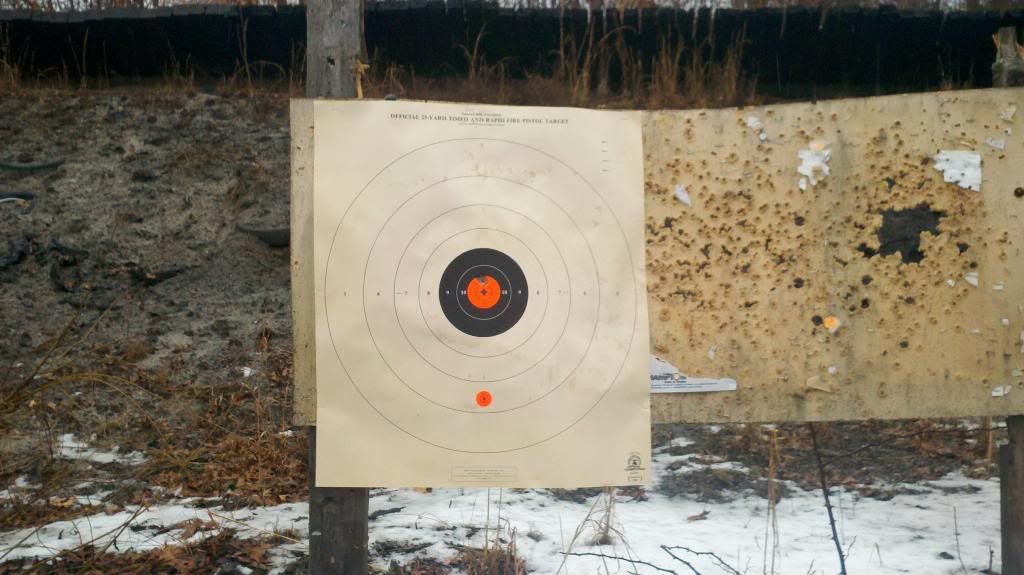 Unable to obtain Reloader 7 powder due to shortages of all reloading supplies, I worked up a load using Hodgdon H335 which proved to be very consistent and pleasant to shoot in the heavy Lott, at least compared to my .450 and .500gr loads. [Of note is that after carrying the Lott with the scope over the shoulder for a few days, the scope ended up staying in camp!] I brought along some .450gr Barnes flat-point solids just in case. We spent ample time at the range shooting paper, however, this just does not prepare one for typical field conditions. To address this, given where I live, I have found the best solution to be a scoped pellet gun. I am able to setup “targets” (Easter eggs are great fun!) in the brush in the back yard and shoot daily from a variety of positions including off the shoulder, on the sticks, kneeling and sitting. I believe it helps tremendously in allowing me to quickly acquire the target (moving from visual sight to scoped-sight), settle the crosshairs, and squeeze the trigger. It is cheap shooting, and does not cause one to develop a flinch. Once the hunting rifles are scoped in and the loads worked up, this is how we prepare and build confidence leading up to the hunt. PHYSICAL PREPARATION Unlike other recent hunts, which were made challenging by either hot/humid weather (early season) or high temperatures (late season), the expected temperatures and conditions were going to be just about ideal. As such, hydration was not as much of a concern, although I did take along a good supply of NUUN tablets for the water bottles and we were diligent in drinking water prior to the first walk of the day and in the evenings. If you have read any of my other hunt reports, you know that physical preparation is an important aspect of the hunt preparation for me. You also know that I have had a limitation due to a bad right hip. For this hunt, I continued my usual program of hiking a few times a week including hill climbing with a moderately weighted backpack and upper body weight lifting 5-6 times a week. Training outside during the winter in PA is not much fun, but it does help to keep me in shape and an upcoming hunt provides the necessary motivation. 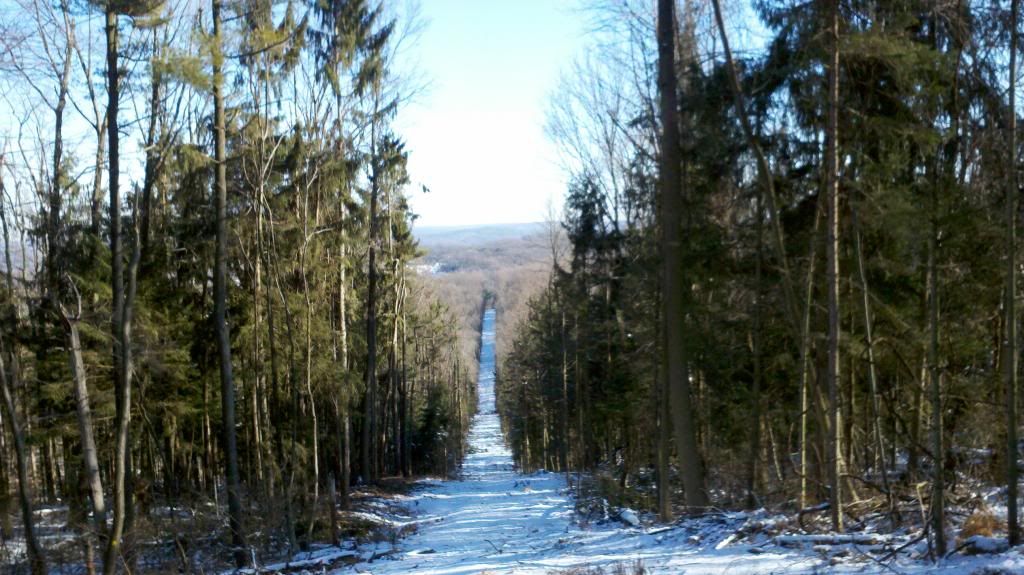 I would like to mention that three months AFTER this hunt I had my right hip replaced. The results have been nothing short of amazing. I was up and moving as soon as the local anesthesia wore off, and spent only one night in the Physicians Hospital. I was walking unassisted three days afterwards, strolled the neighborhood day-4, hit tennis day-5, and was back in the woods hiking ~5 miles exactly one week to the hour after the surgery. I had very little pain, and certainly much less discomfort than prior to the operation. I did not require any formal physical therapy. The surgery was done by Dr. Peter Sharkey of the Rothman Institute located in the Philadelphia area, using the anterior approach. I make a lousy patient, but have to say they were truly amazing. I believe my rapid recovery was possible due to the skills of the surgeon and my physical condition going into the operation. I was getting to the point that in addition to hip pain, I was having issues with my left knee, ankle, and lower back - all of which resolved themselves almost immediately following the surgery. The impact on my quality of life and overall wellbeing has been tremendous. I have full range of motion, am down to my college weight, can hike hills all day long, and move around the tennis court with relative ease (I still suck, but have a good time). In hindsight, I waited too long, but it took a change in my career path to provide the window of opportunity. If anybody has any questions, please feel free to PM/email me. TRAVEL TO ZIMBABWE Check-in at the South African Airlines desk at Dulles (Washington DC) was simple, as was the baggage check via TSA. The agents were friendly and as usual were curious about where we were going and what we were hunting. The Airbus 320 was full, and included a number of other hunters, most easily identifiable by their camo clothing and enthusiastic conversation with each other and those around them. One guy was headed to Namibia for what he said would be his fifth leopard, and another group of bow hunters from Oregon were to be hunting South Africa. I was glad to see other hunters, as early/late season it seemed as though I was the only one on the plane. We stopped in Dakar for fuel and to exchange passengers before the second 8.5hr leg to Johannesburg. There is no cabin search on the way to Africa, but the cabin is sprayed with the World Health approved disinfection spray which plays havoc with my soft contact lens. Unfortunately, Brett’s entertainment system screen was cracked and made watching movies impossible. We switched seats when one wanted to sleep, but this is the sort of thing that needs to be taken in stride. The plane taxied directly to the gate, which is always nice as compared to taking the busses. We were not required to complete a SA Customs form, which if I recall correctly one had to do previously even if just transiting through. Both pieces of luggage made the journey, and as we were departing the carousel area, a gentleman approached us with the rifle case. He walked us to the office labeled “Secretary Desk” which is very easy to miss if not looking for it, where we signed to log book. He led us through a back hall to the SAPS desk, which thanks to the pre-authorization we cleared in 5 minutes. The other hunters from the plane were in various states of confusion, noting most missed signing the log book which must happen all the time but apparently throws everything into a tailspin. After a short 10 minutes ride, we arrived at the Africa Sky Guest House, where check-in was lighting fast. 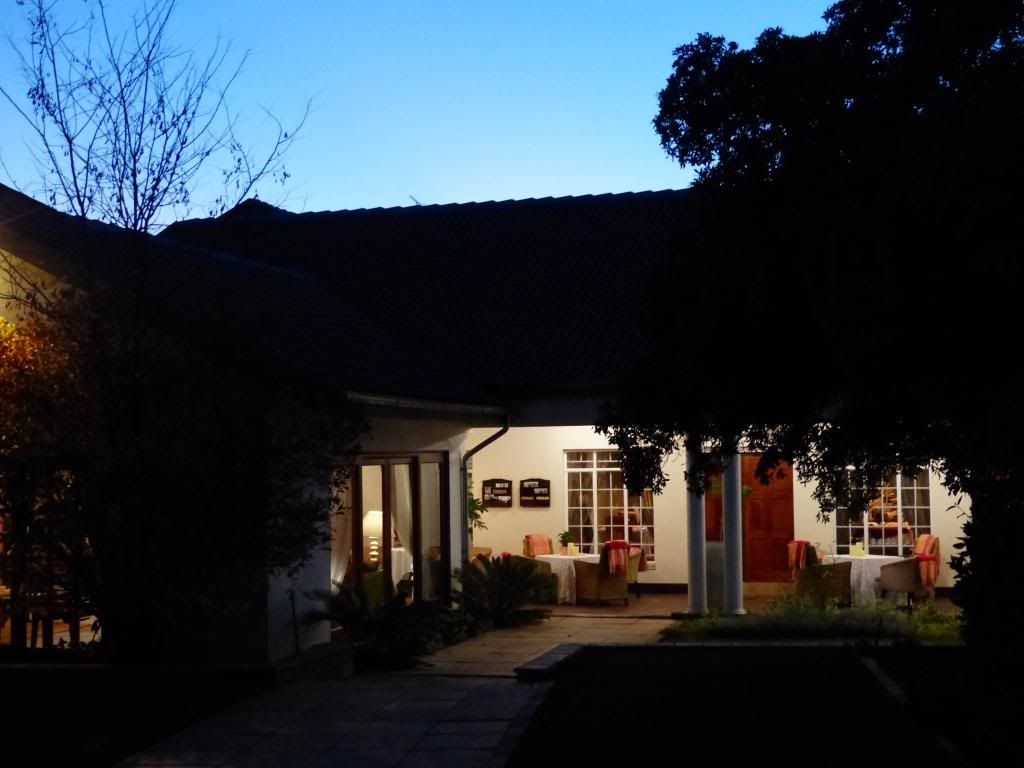 After a shower, we explored the grounds, meeting up with another father-son team from AR, Carl (sevenmagltd) and his son Carson. They too were hunting the BVC with PH Brent Hein, the focus being a big old tom leopard for Carson. Click Here for Carson's Hunt Report 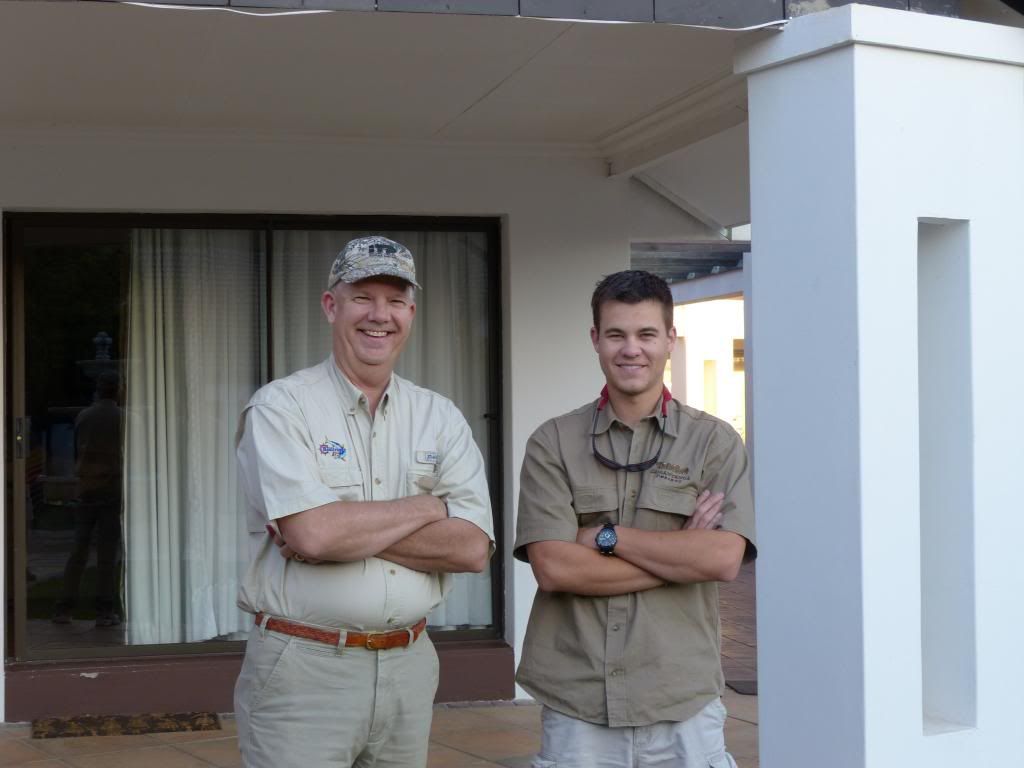 I enjoy meeting people along the journey to and from Africa, as most have interesting stories. For example, our driver Ray was an accountant in Zimbabwe but was unable to find work there. He came to South Africa but as he is not from the country he is having difficulty securing a job in his profession. His family remains in Harare, including a son who is attending University there. I have to say, with some reluctance, that the total experience at ASGH was far superior to my last stay in SA which was at the Afton Guest House. The mood at the ASGH was upbeat, the staff friendly, the accommodations comfortable, the food excellent, and the transfers efficient. 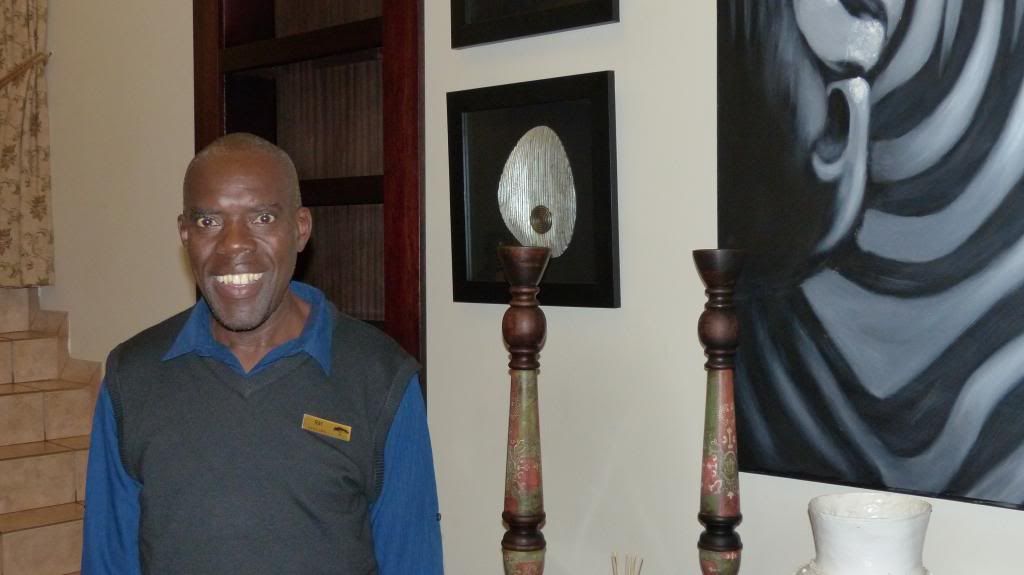 Like dinner the previous night, breakfast was excellent with plenty of food and cheerful efficient service. We had some time to explore the grounds in the daylight before needing to depart for the airport. 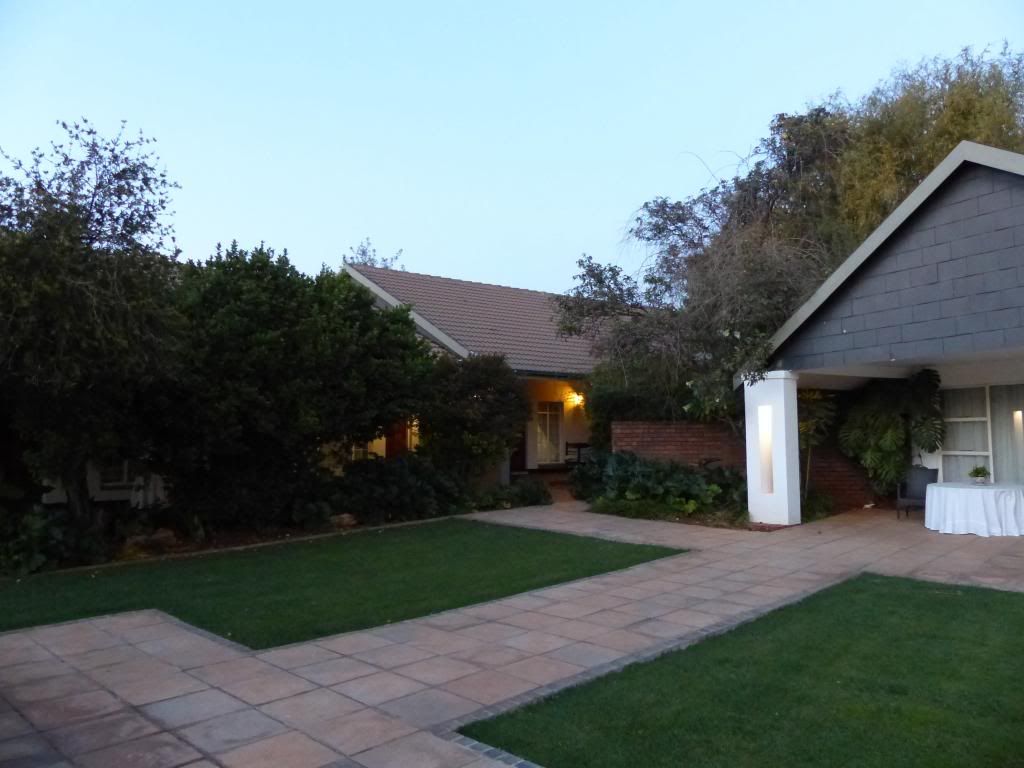 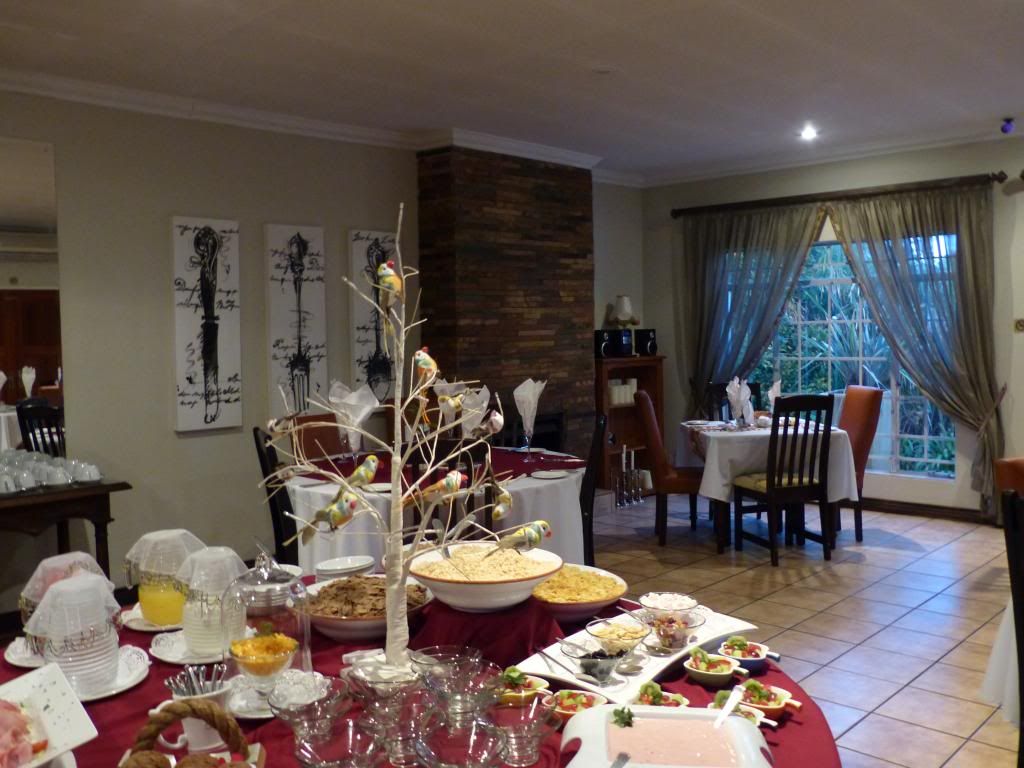 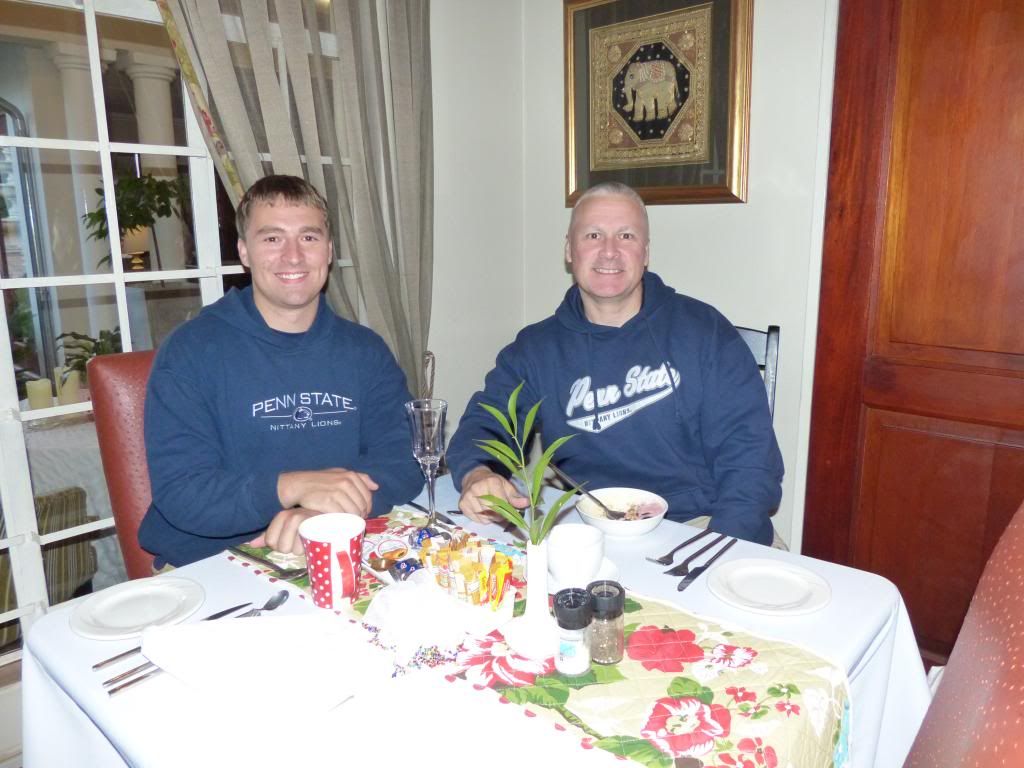 The representatives from the ASGH walked us through the airport and to the proper gate. 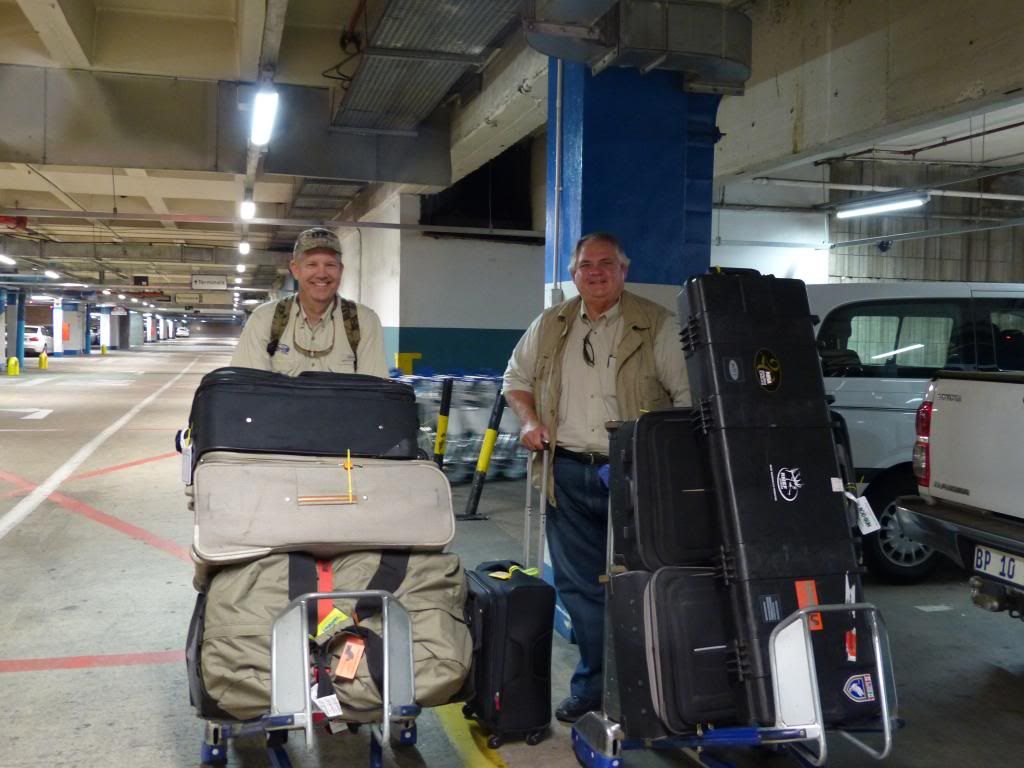 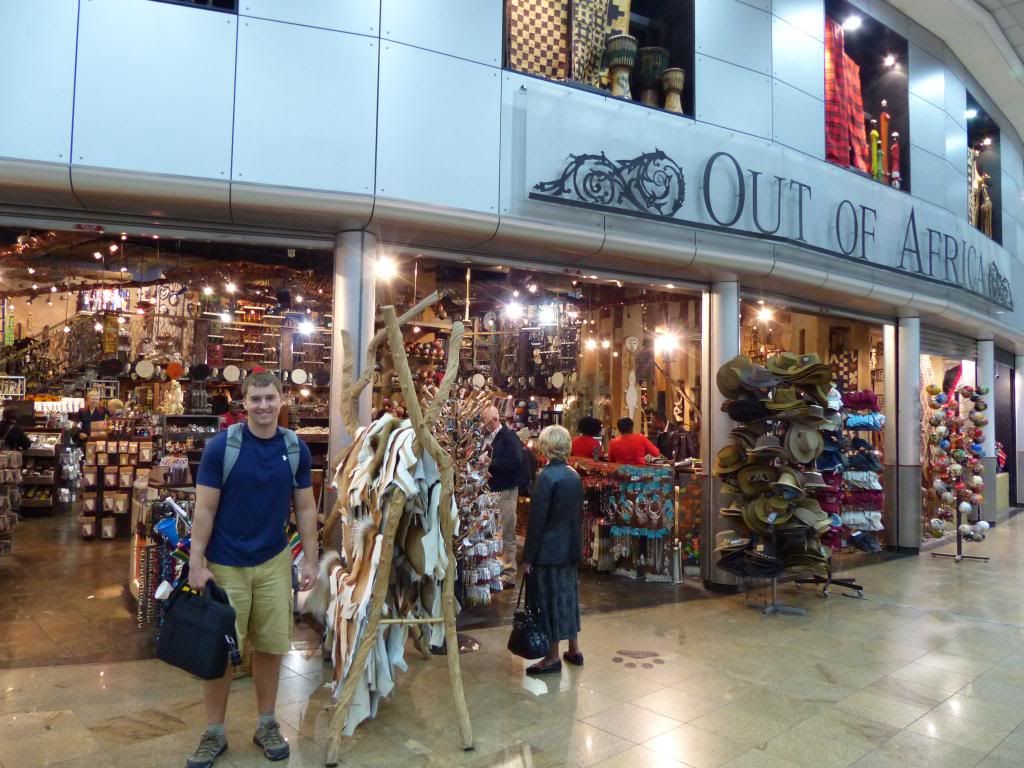 The flight to Bulawayo was painless, noting Steve had gotten us the seats at the front of the small plane which made for a smooth ride (and as close to “1st class” as I will ever get!). Brett and I chatted with Cobus, an ex Rugby player for the SA Lions who was still living in South Africa but running a gold mine in Zimbabwe. He looked like a rugby player, with a thick neck and a huge forehead. A heck of an nice guy too. BULAWAYO & DRIVE TO HUNTING AREA This was my third time through the Bulawayo airport, which is still in a temporary hanger as the airport terminal is still not yet completed. I remembered it being chaotic, and nothing had changed. It is a small area, but there is no flow and people spend most of the time standing in the wrong line. I was lucky in getting to the right desk at the right time. For those going to Bulawayo, here are a few tips that I noted, understanding that this may have already changed: - Obtain a Zimbabwe VISA (Immigration Declaration) form via the Internet prior to travel (I snag a few extras each trip) and have this completed and in your travel folder - Look for the “Visa Window” which was on the left side wall, where you pay for the Visa - Go back to the right front desk to get your passport stamped with your Visa - Your outfitter will provide tax paperwork, which is completed at the desk in the front left - Pick up your luggage - Look for the Customs “Firearms Desk” towards the rear and sign your pre-completed Zimbabwe firearms paperwork - Go thru the Customs “Declare” line, open cases, take with you your copy of the firearms permit and store this in a safe place for departure Ade was waiting for us outside the hanger, and was a bit surprised at how quickly we navigated the terminal. Brent Hein introduced himself, and I remarked that it was a pleasure meeting him and that I had heard a lot about him over the years. To which he smiled and replied, “Not all of it bad I hope”. 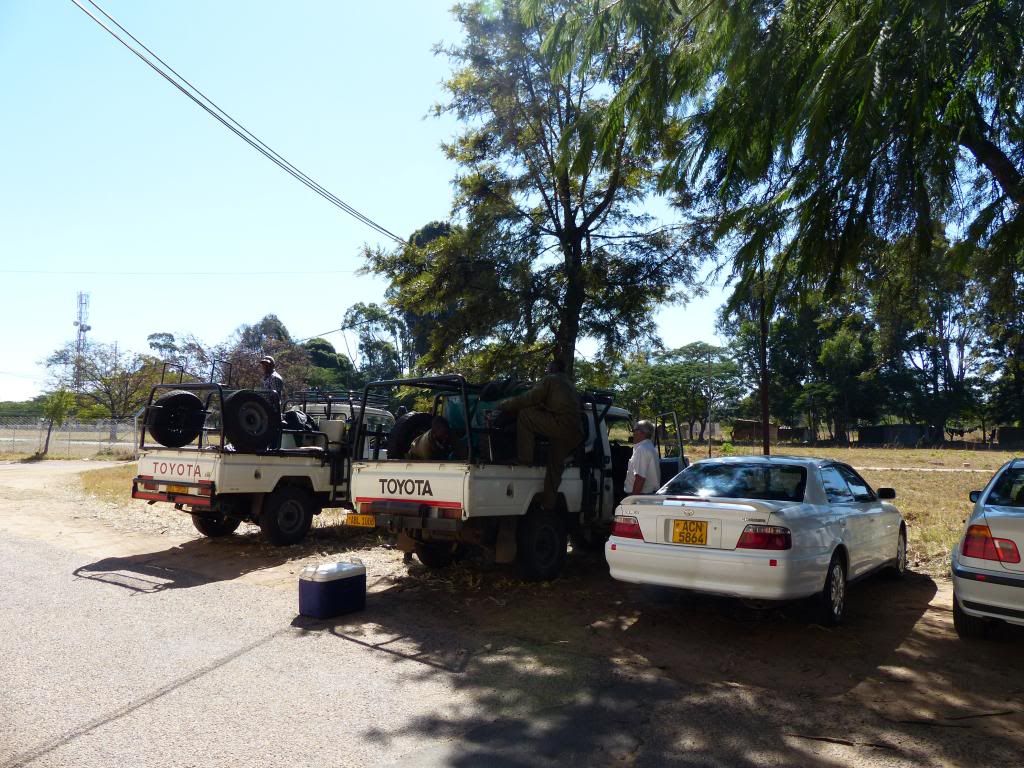 It is always a bit strange meeting the hunting team for the first time, I am not sure why, perhaps because the routine seems so familiar yet we don’t really know each other yet, and it takes a while to settle in. We made some stops in town for miscellaneous last minute supplies and beef biltong. 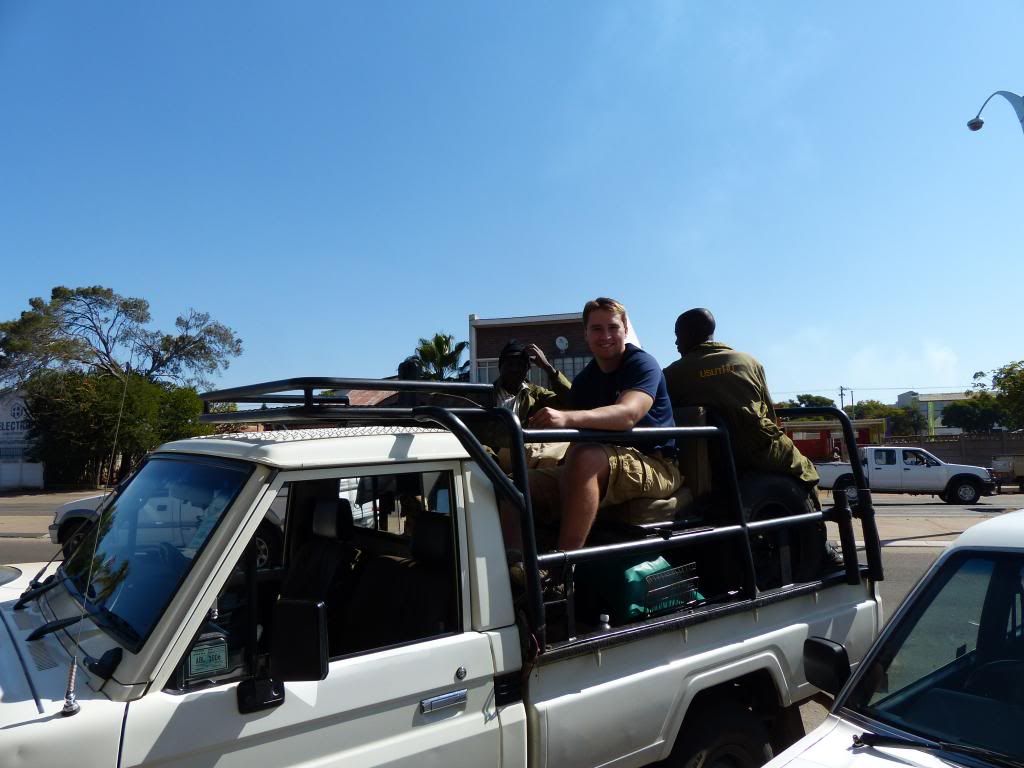 The ride from Bulawayo to the BVC in the hunting vehicle is only 3-4 hours including a stop or two along the way, plus drive time within the conservancy to reach your particular camp. This is nice in that one can make the drive without having to overnight in Bulawayo either heading into camp or working your way back home. We stopped at the road to Falcon College to wait for a mate of Ade’s to drop off his .22, where I chatted a bit with three local boys on their way home from school.  Some of you may know of Todd’s Guest House? 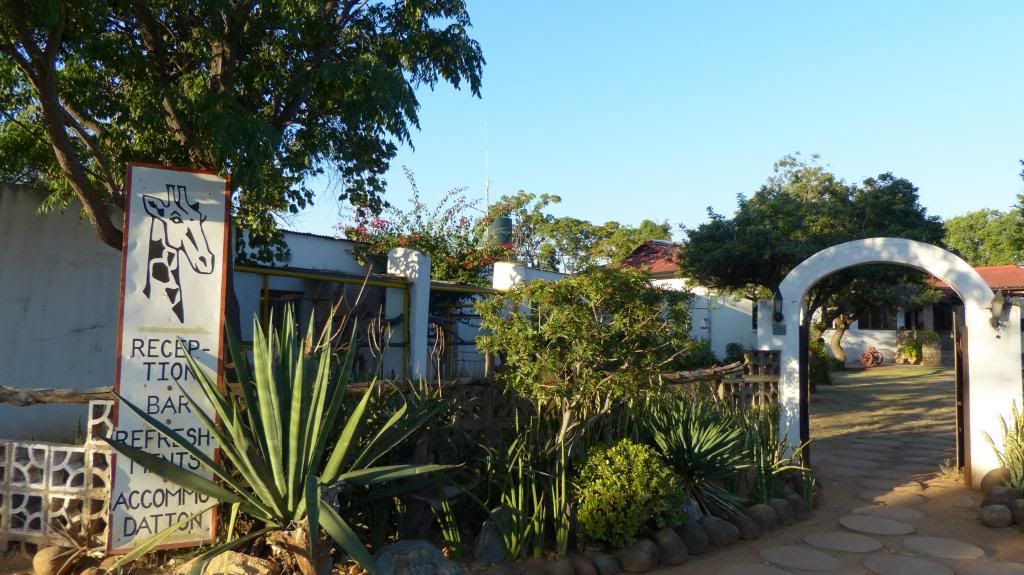 We saw a few animals on the way into camp, including elephant which to Ade’s surprise did not excite me as much as the herds of wildebeest and zebra. It was dark by the time we arrived at the Chamalaya camp. During our stay, I found Chamalaya to be very comfortable with a homey feel to it, and slightly preferred it and the staff over the Ngali camp where we would stay later in the hunt. 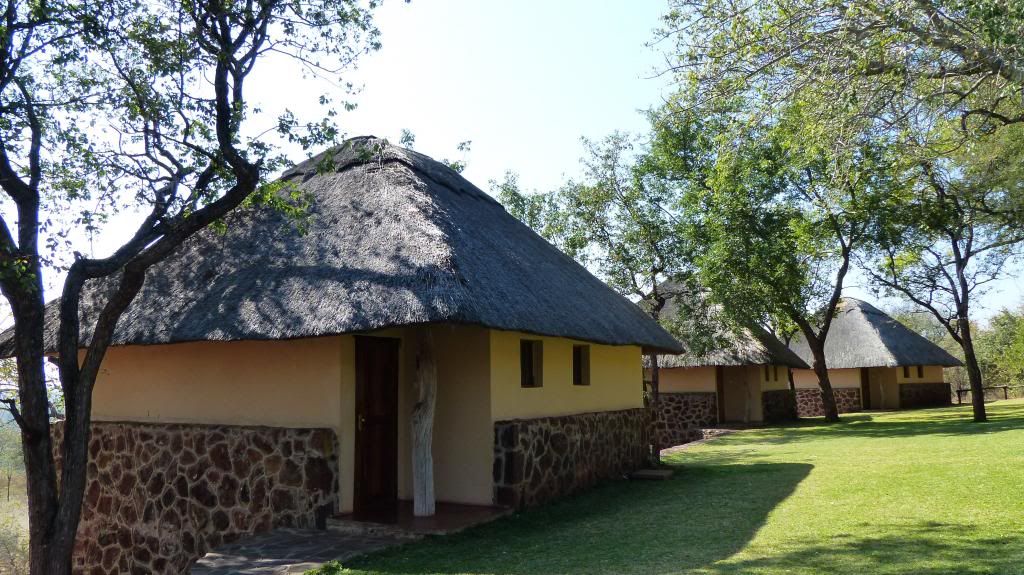 The service at Chamalaya was also excellent, and although they were the newest team at that time, they were exceptional and eager to please. At the end of our hunt, I made sure to thank each one personally, and tip to the best of my abilities. Chef: Supa Waiter: Samoa (picture below) Laundry/Rooms: Oswald Garden/Misc: Kulule (picture below) 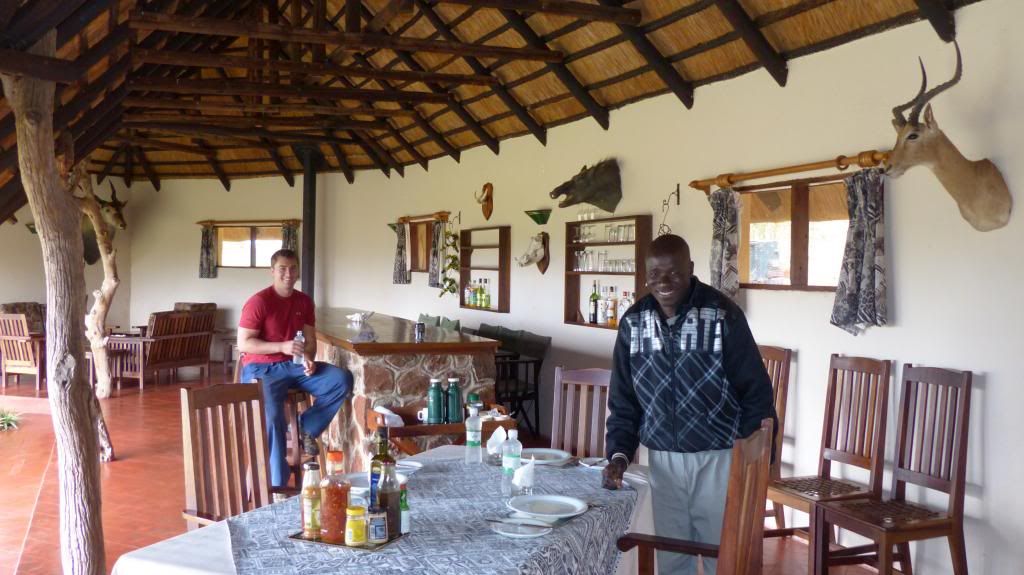 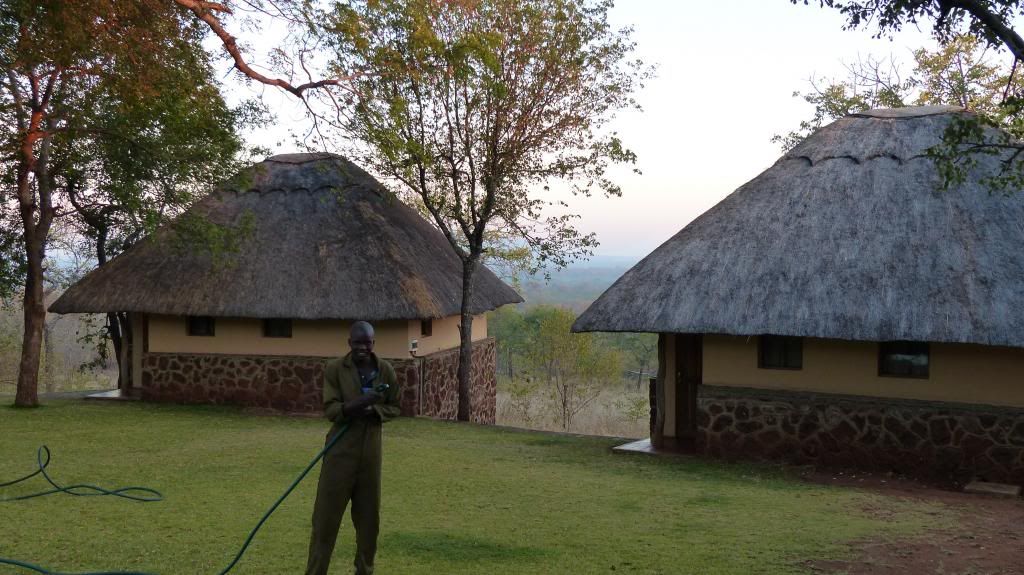 Brett and I selected our hut, preferring to share a cabin as we enjoy talking in the mornings and evenings. We had dinner and were in bed by 10pm. With the help of an Ambien, and the benefit of having spent a night in Johannesburg to help get the body clock adjusted, I managed to sleep until 3am, then tossed and turned until 5 when the generator kicked on and I remembered that I had forgotten to turn the lights off after the generator went off the previous evening. THE BUBWE VALLEY CONSERVANCY For those not familiar with the BVC, it is one of the most remarkable conservation success stories of recent times. The 850,000 acre private conservancy is located in the southern lowveld of Zimbabwe, close to the boarder with South Africa. The area was a prime hunting destination in the 1800’s, offering one of the largest concentration and diversity of game found in the country, including buffalo, rhino, lion and elephant. At the beginning of the 20th century, the land was used by Leibig’s Extract of Meat Company (Lemco) for cattle ranching, as despite experiencing little rainfall the lowveld is nutritionally dense and can support large numbers of herbivores. During this time, most of the game was eradicated to avoid competition for food and to minimize the threat of disease. Carnivores were shot on a bounty system to minimize predation on livestock. Drought in the 1980’s and again in the early 1990’s devastated the ranching operation, which was then sold off and purchased by a group of shareholders who began transforming the land back to its former glory. The majority of the ranch was dedicated to trophy hunting, although a section (Samanyanga) was initially fenced separately and dedicated to ecotourism which turned out to not be viable and in 2002 this areas was incorporated into the main conservancy. An external double electrified fence, erected at a cost of $2.1 million dollars, keeps meat poaching and snaring to an astonishing minimum, which is not only good for the plainsgame but also lion who are prone to death by wire snare, and one of the reasons why the lion population in the BVC has outpaced that of the Save Conservancy over the same period of time. There is no internal fencing. The naturally reproducing game is free to roam and select the habitat most suitable to their existence. Although not hunted, rhino have benefited tremendously from the establishment of the BVC, as funds generated via hunting can be dedicated to establishing and through aggressive anti-poaching grow the population. The habitat consists of mostly flat classic lowveld bush, granite kopjes in the north, and riverine habitat around the waterways including the Bubye River which flows through the middle of the conservancy. Today the BVC has over 35 different species including black and white rhino, elephant, lion, leopard, cheetah, wild dog, hyena and a variety of plainsgame and nocturnal animals. The primary source of revenue is from the sustainable takeoff of game animals via trophy hunting. Without hunting, there would be no BVC, as the land would be used in a different capacity, which means there would again be little if any wild game. 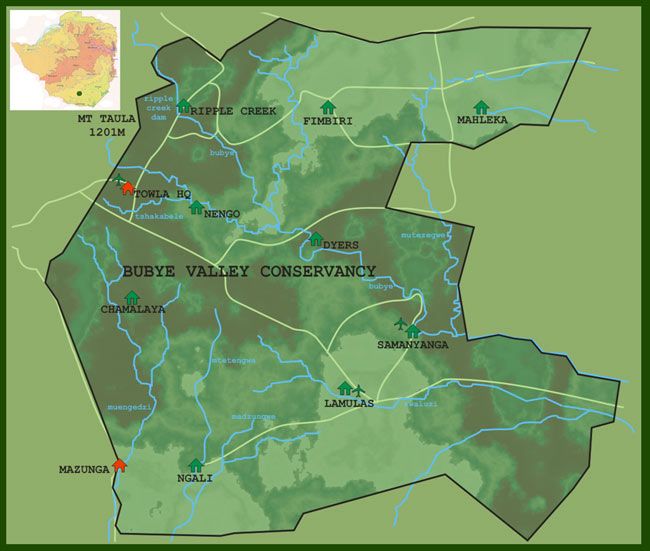 HUNT DAY #1 (Wednesday May 29th) The days are fairly short this time of the year, with sunrise around 6:30am and sunset at 6:00pm. Conversely, for the prey animals the night must be awfully long! Mornings were the best time to call home, as at 5am it was 11pm in PA. Brett made good use of the satellite phone to keep in touch with his new fiancé. Ade was kind enough to obtain for us a 3G wireless USB adapter, which allowed us to access our email. This was a first for me. Signal was better at the Ngali camp given the proximity to the cell tower, but with patience we were able to send and receive emails from both camps. While some may be aghast at the thought of this, it was necessary as I needed to stay on top of developing projects at the office and Brett was receiving emails from medical school that required immediate response. While I respect those who wish to disappear from the grid, for me at this point in my life, I need to be accessible by my family. Breakfast was per our request porridge (maize), meat/cheese platter, toast and of course Nescafe Instant. We made a plan to walk an area from the road to one of the many water points. All water in the southern area of the BVC is pumped from wells in the north via the irrigation system to manmade waterholes, which are mostly circular concrete structures, and are the only reason that the otherwise dry area can sustain game year round. The Hunting Team (Yobane; Lovemore; Richard – missing from this picture was Paul) 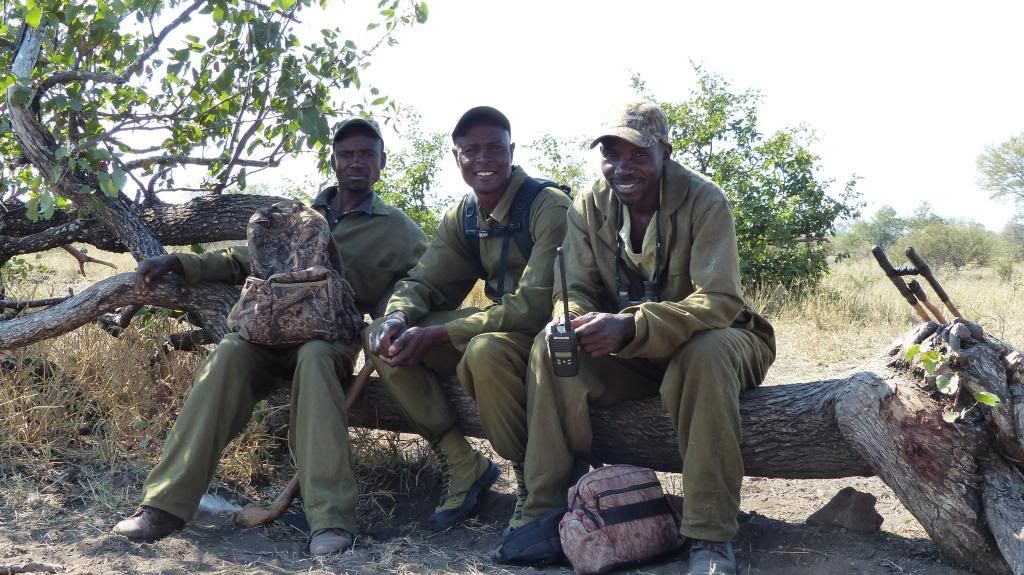 The first order of business was to make sure that the rifles were still shooting accurately. There is no range at the camp, so we shot off the hood of the Cruiser. Both rifles, and their operators, were shooting good enough, and we proceeded. The weather was cool and cloudy, with a slight dampness to the air. We walked about 5 kilometers, seeing multiple groups of blue wildebeest and zebra, most often together in groups, which would become a common theme during the course of the hunt. One wildebeest bull was exceptional in terms of trophy size, but by the time that I decided to shoot it, he had run. We followed the small group, bumping them several times until finally losing the bulls in a herd of 20+ wildebeest. We waited for the truck at the water point, where I practiced my stalking capabilities armed with my Panasonic bridge camera. After an apple and some biltong, we set off again on foot walking another 6-7k. 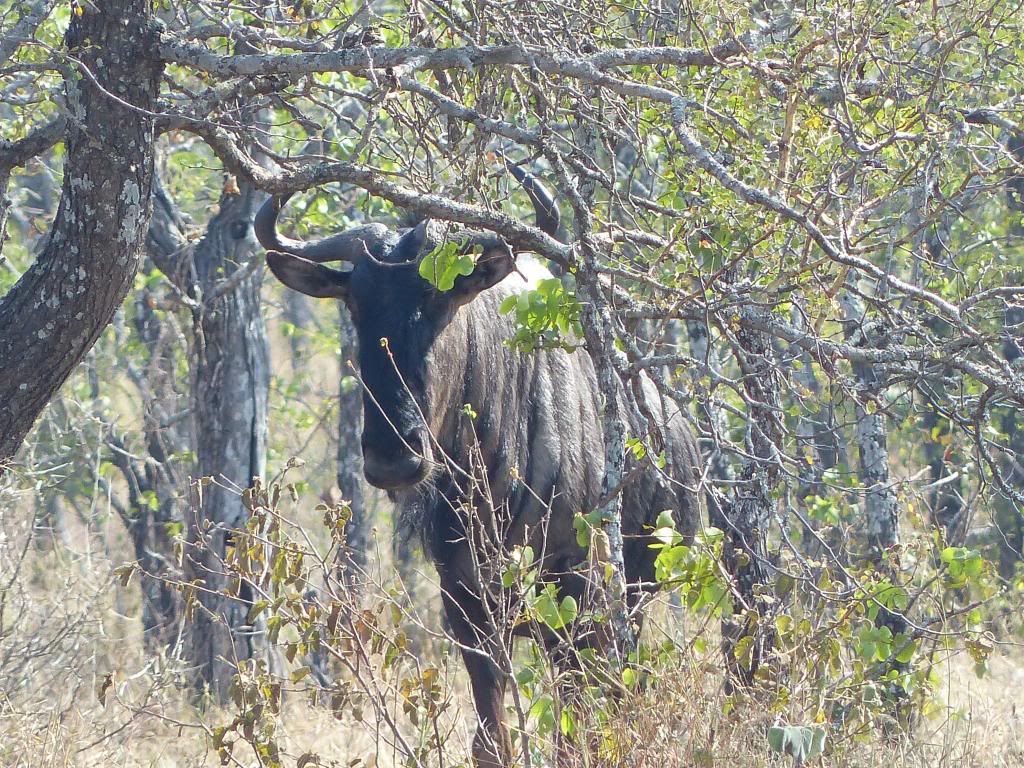 An armored ground cricket: 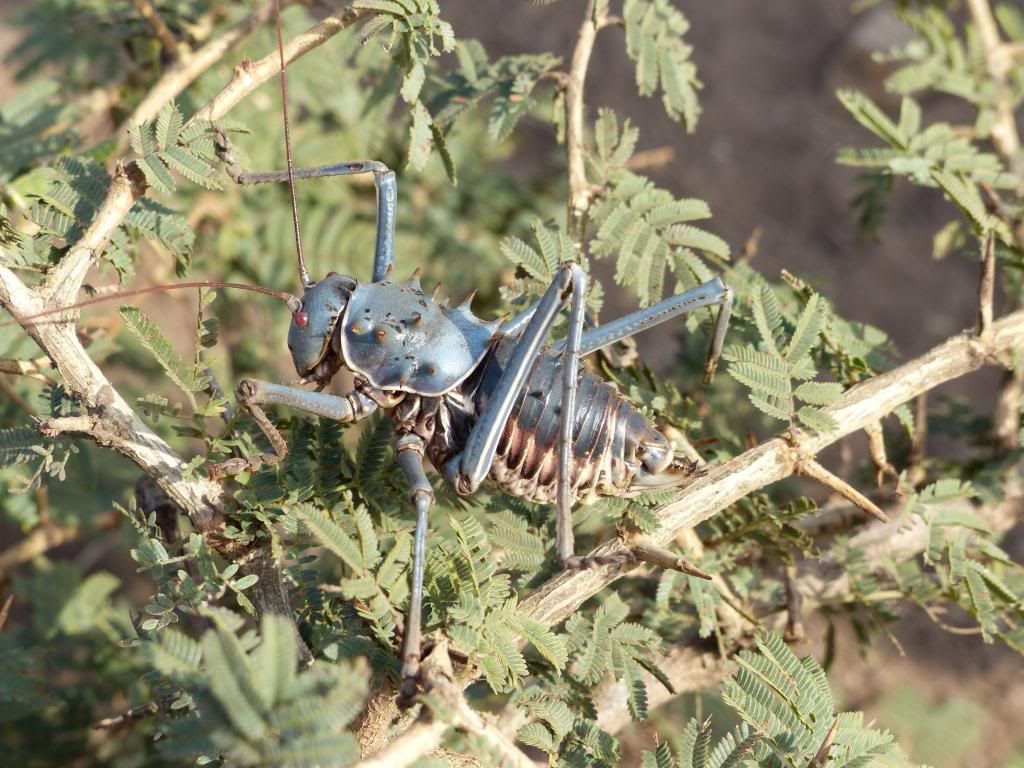 The ground was covered with hoof prints, and it was rare to see any patch of dirt that did not have a track on it. There was life everywhere. This being said, hunting plainsgame on foot is far from easy. During the course of the hunt, I found the game to be very wary of any movement and always on edge. Given the high population of lion and other predators, the animals are on constant guard and run at the slightest sign of danger. This combined with their grouping – it was not uncommon to see four or five different species together – made sneaking up on game quite a challenge. Once a stalk was blown and an area cleared, it would usually be a while until another concentration of game was happened upon. I have no doubt that hunting in the typical fashion, using the vehicle to spot game and stalk from reasonable distances, that one could shoot a variety of plainsgame in a short amount of time. As expected, and hoped for, this was NOT the case on our hunt, and we worked very hard for the opportunities that we had. We reached the second waterhole around 1pm, at which point given our proximity to camp, we decided to return for a proper lunch and a short nap. As I have noted in previous reports, it takes me 5-6 days to get fully acclimated to the new sleep and exercise schedule, and it would be no different on this trip. One really nice aspect of the BVC is that there is plenty of game meat (lean protein!) available, unlike hunts to communal areas where chicken, pork chops and spaghetti are necessary mainstays. We departed camp at 3pm for the afternoon walk, which was to a nice dam where the guys expected to see a lot of game. For whatever reason, the area was quiet except for a few zebra and wildebeest. At the truck, we prepared for the night hunt. The first and only time Brett or I have shot anything at night was in South Africa in 2001, and it took us a while to get accustomed to the process of spotting, locating, and shooting. This was not something that we prepared or practiced for! I underestimated how cold it would get on the back of the truck, and without enough warm clothing along, froze. After not getting on a few jackal, Brett was successful in shooting an African wild cat. For me, it was mostly a great excuse to be out under the African night sky. Dinner was a braai of impala filets, sausage, sadza, carrots, potatoes, tomatoes with cheese, and a fresh salad. One could get very used to this! 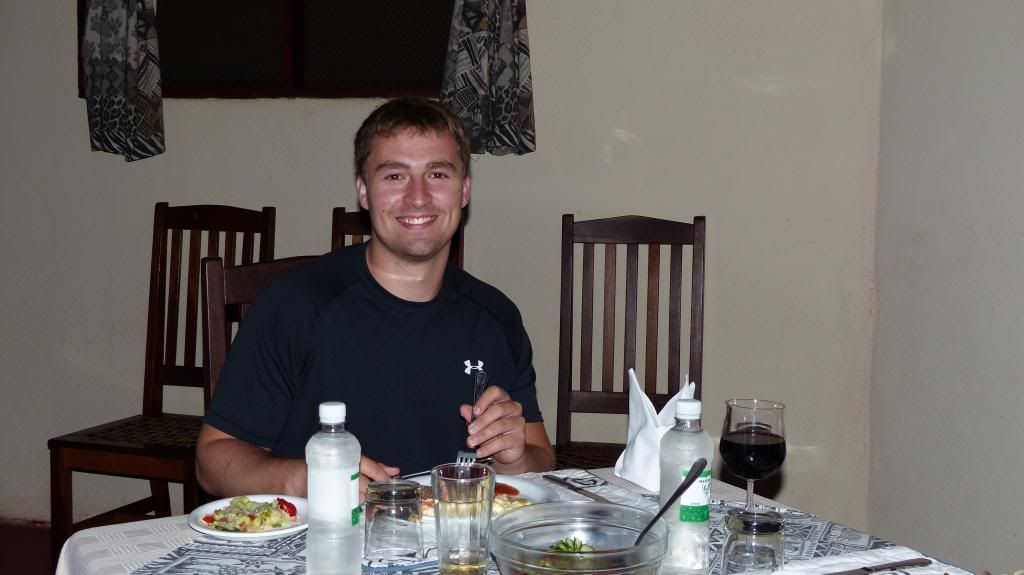 That night, herds of zebra and wildebeest visited the waterhole by camp, which we were able to spot using my larger headlamp. The clanking of their hooves on the rocks echoed in the still cool air, and grew closer as they fed to the back of our cabin. A lion’s roar in the distance startled them and put them on edge, and eventually they moved off. The lion continued to call and grunt until daybreak. HUNT DAY #2 Hunting close to camp this morning, we were in no rush to depart. At around 7:30am, we were on foot making our way to a pond that was still holding water. At the water there was a lot of spoor, including lion, but no game present. Ade showed Brett and I eland tracks and compared to those of giraffe, per my requests for him to “teach” us wherever possible during the course of the hunt. I have tracked and shot eland before, including a Lord Derby in Cameroon, but over time my memory fades and I find it difficult to differentiate the different spoor. 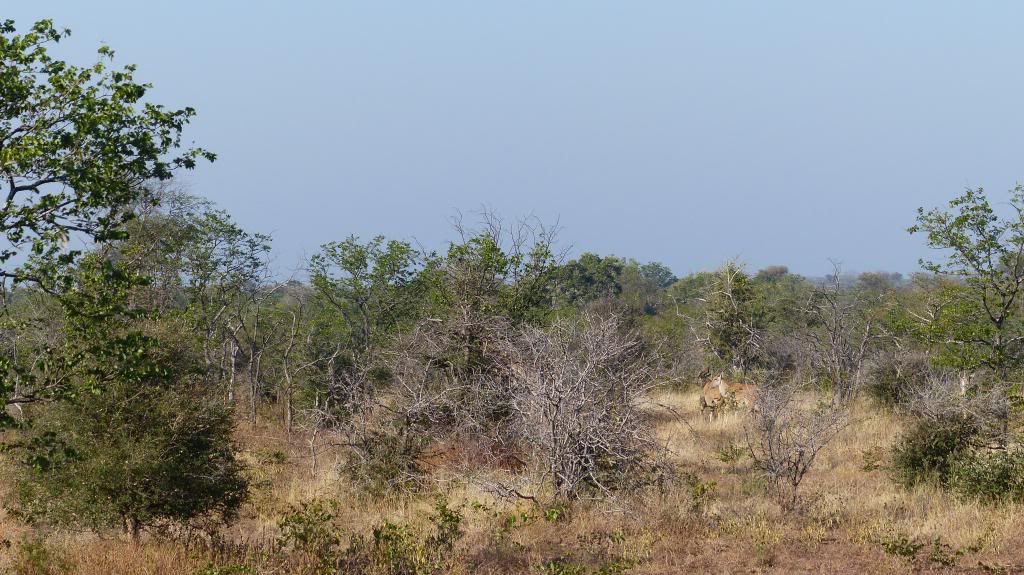 The truck met us and after a mid-morning snack, we walked another area of mopane scrub and low acacia. We encountered a small herd of zebra which Brett and I stalked. The bush was thick, and we were able to work our way to within 20 yards of a feeding stallion, which in hindsight is quite a feat, and would have provided the perfect opportunity for the open-sighted Lott. Later that morning we walked along a dry river bed, jumping two kudu bulls, one of which might have gone 50 inches, although to me he looked a bit immature and was not what I was expecting out of the BVC. Brett and I worked our way to a group of feeding impala. Taking up the lead while Ade and the guys hung back, it was a completely new experience, made more difficult by knowing that there were multiple sets of eyes viewing my actions and approach. As usual, the impala were not alone, and we soon found ourselves pinned down by a small herd of feeding zebra. The wind swirled, and a kudu barked the alarm from somewhere on our right, which sent everything running including a big eland cow that I had not seen. It is a discouraging feeling, to be actively engaged one moment, then in a matter of a few seconds to have the area clear with nothing but a dust cloud remaining and zero chance of anything good happening again for quite some time. We did walk up on an old giraffe bull, who seemed friendly enough despite Brett getting on the sticks for a mock shoot. I am sure Ade was doing everything in his power to will the trigger to fire! 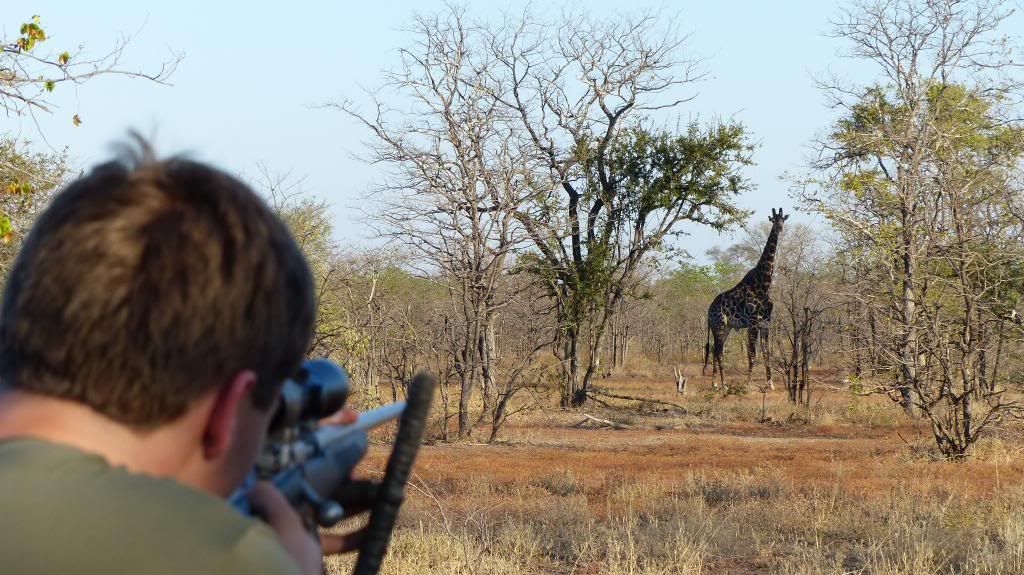 We cut the closest road and radioed the truck. Ade had selected a scenic area for lunch, which was about a 30 minute drive away. The eland steaks were cooked over an open fire, and eaten with sadza by hand out of the communal pot using the “clean hand” (which is the right hand by culture as the left hand is “dirty” if you catch my drift). 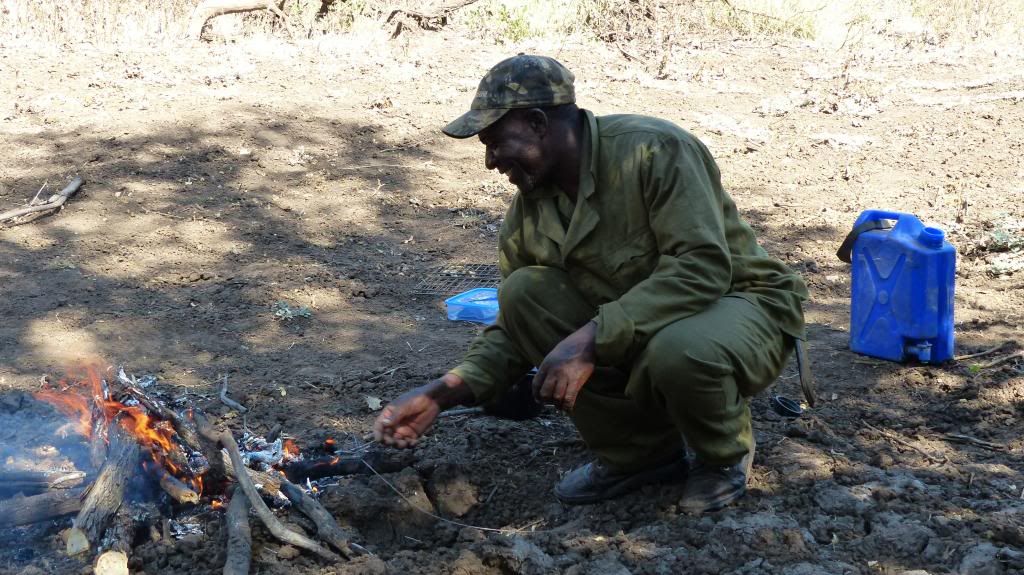 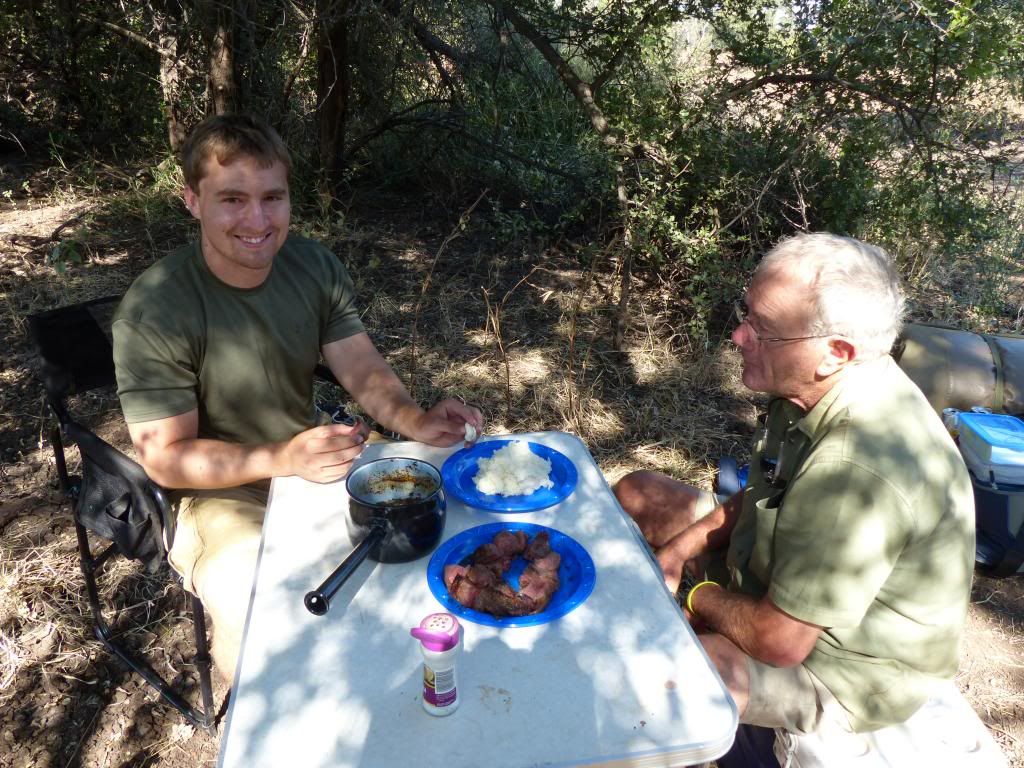 The afternoon walk was not terribly exciting, perhaps another 6K at a brisk pace. 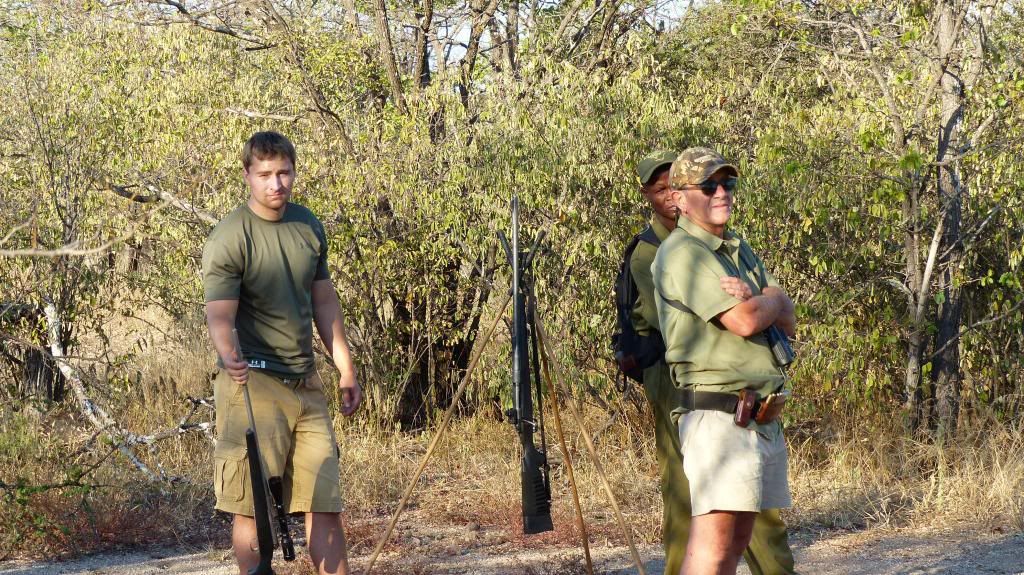 Nevertheless, the bush almost always provides something of note if one is observant, and interested in such things. The area is thick with guinea fowl, which attract the birds of prey. I tried to keep a list of birds seen, noting Ade is an experienced falconer and is very knowledgeable. Sightings included a Great Eagle Owl hunting a flock of guineas and an African Hawk Eagle which had killed and was eating a hen when we happened upon him. The picture below I believe is of a Tawny Eagle. 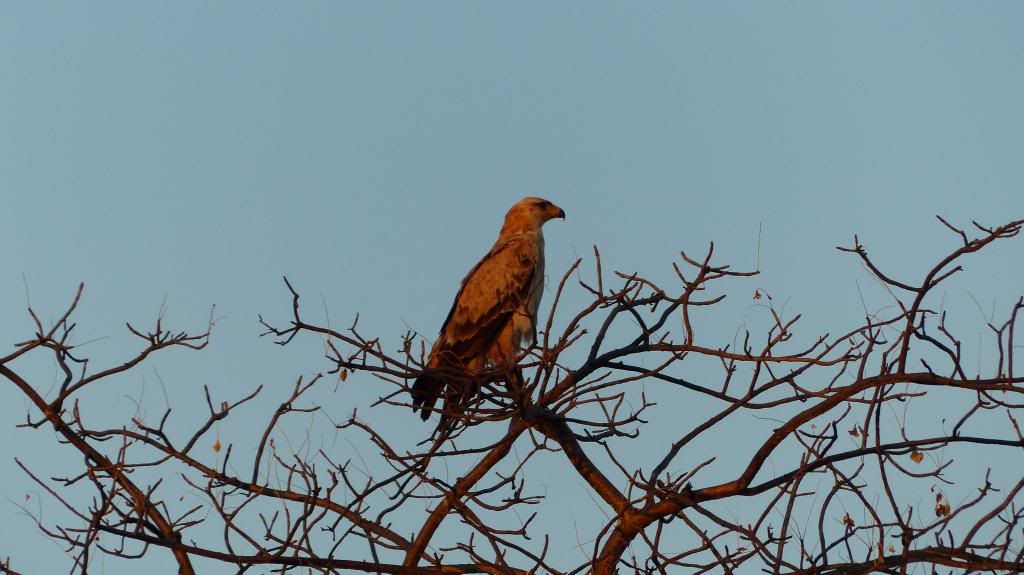 After dinner (chicken…but camp-made ice cream for desert!) we spotted from 9:30 until 10:30, seeing a few wild cats and one small genet in a tree trying to get into a birds nest. HUNT DAY #3 I have to admit that having heard from everybody how thick the BVC is with lion, I was a bit disappointed in not having seen any yet. I had heard their call, and seen their tracks, but still no sightings. Of course we are not covering huge amounts of ground on foot, as compared to what one can do in a vehicle, and I knew it would come…but Brett and I were getting anxious. We drove east to the Dyers camp to hunt along the Bubye (pronounced “boobie” which always brought a smile to my face when verbalized) River. One of the attractive aspects to the BVC is that when you book a hunt, you are guaranteed exclusive use of a particular area surrounding your camp. One may encounter others on the road system, or on occasion when an animal (or lion) is hunted that is not available in the party’s area, but groups are not bumping into each other on a daily basis. It was stated that the people who were to hunt out of the Dyers camp cancelled their safari, and as such Ade was given permission to hunt it for the day. The camp was beautiful and more luxurious than Chamalaya (although I understand it is still a notch below the ultra-luxurious Samanyanga and Ripple Creek camps). In addition to the swimming pool, I noted the thick mattresses and twin beds, which given the discomfort caused by my hip after a day on foot, would have allowed me to get a better night’s sleep. I am not sure how the hunting compares, but Dyers would be a fantastic camp to bring the wife/family.  Unfortunately, the walk turned out to be unproductive. The sand was too deep to walk in, and the bush too thick for a party of 7 to quietly walk thru. So we ended up walking the dirt track that parallels the Bubye River, jumping only two immature kudu bulls and a few herds of impala that saw us long before we spotted them. 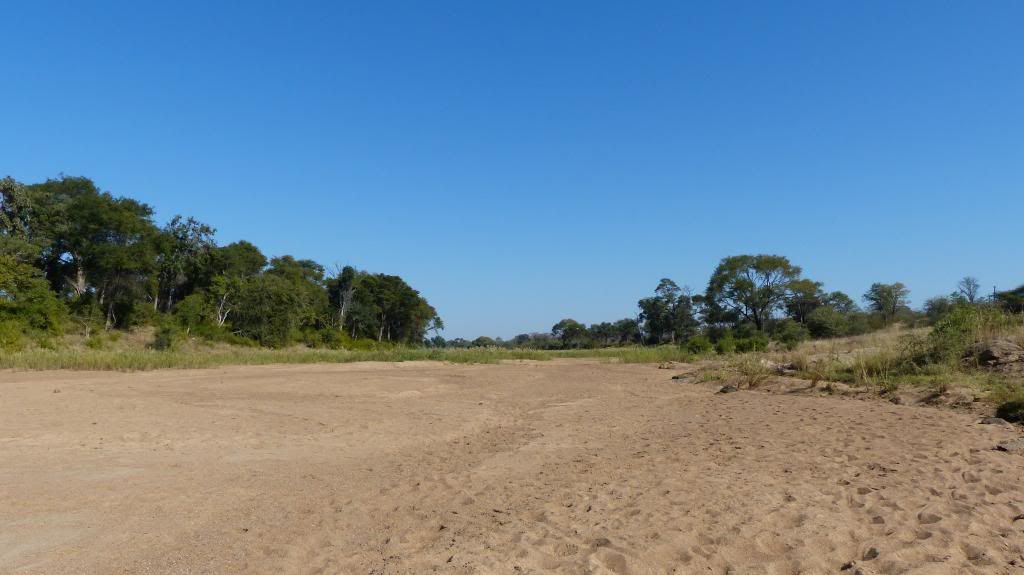 We crossed the river and made our way back to camp via the dirt track, meeting PH Pete Fick on the way who was hunting leopard with a husband and his wife. They didn’t seem too thrilled to see us, as although we were not actively hunting at the time, I believe we were walking in the neighboring area. Strolling into camp on foot was cool. However, the brisk 4 hour walk had taken a toll on my feet, and I was developing a few hot spots and my big toes were not looking so good (after getting home, I actually lost both nails which was entertaining). Lunch was from our cool box eaten overlooking the Bubye River. And yes, the beds were as comfortable as I earlier assumed them to be! 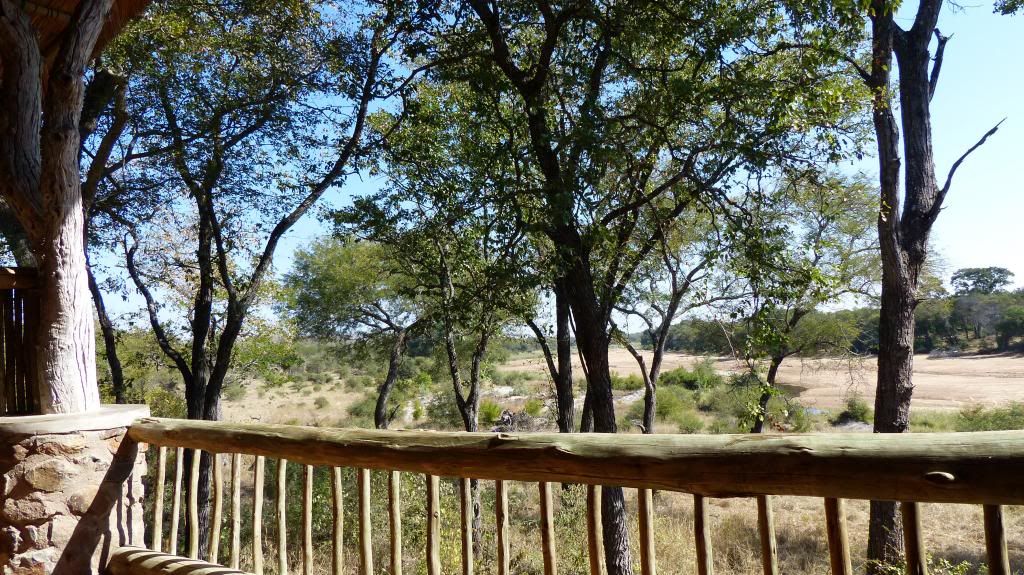 Working our way back towards Chamalaya, we walked into a large dam hoping to bump into game congregated on the outskirts of the water. There was a herd of wildebeest, but mostly cows and young. 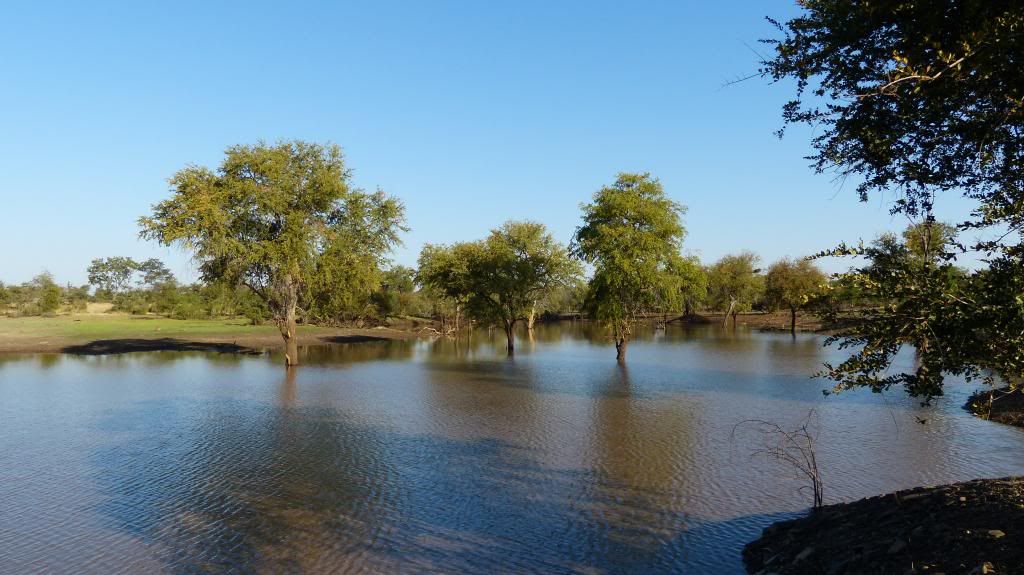 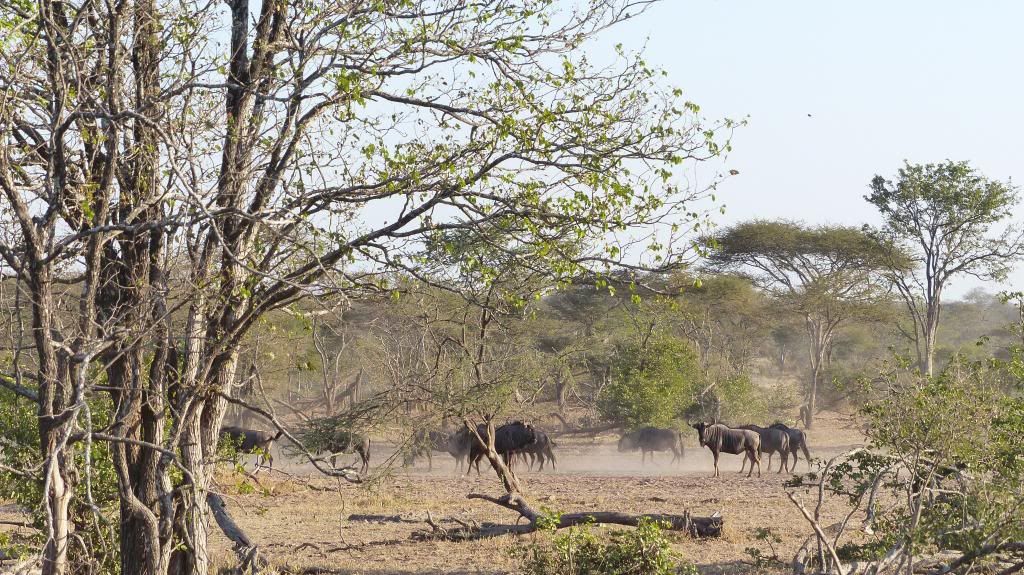 Later, we watched a young warthog enjoy the mud by a water hole while waiting for the truck. It was interesting to see how far in advance the warthog was alerted to the truck’s approach. He was long gone by the time anybody in the truck would have spotted him. Just before dusk, Brett solo stalked a decent wildebeest bull. He got close, probably too close, and the bull ran just as he was taking up the slack on the trigger. Brett was all grins walking back to the hunting party, and it was a fine end to the day. We reached camp at 6pm, and after a shower enjoyed the warmth of the fire before 8pm dinner. The food was once again delicious, hunters pie made with ground kudu. The wind picked up in the evening, possibly indicating a change in the weather. | ||
|
| one of us |
HUNT DAY #4 Brett and I enjoyed waking up early, getting our coffee, and sitting by the fire each morning as the sun rose. Each day on safari holds such promise, and I can’t help but to greet it with eagerness and anticipation. I wish it were possible to meet every day with such enthusiasm. 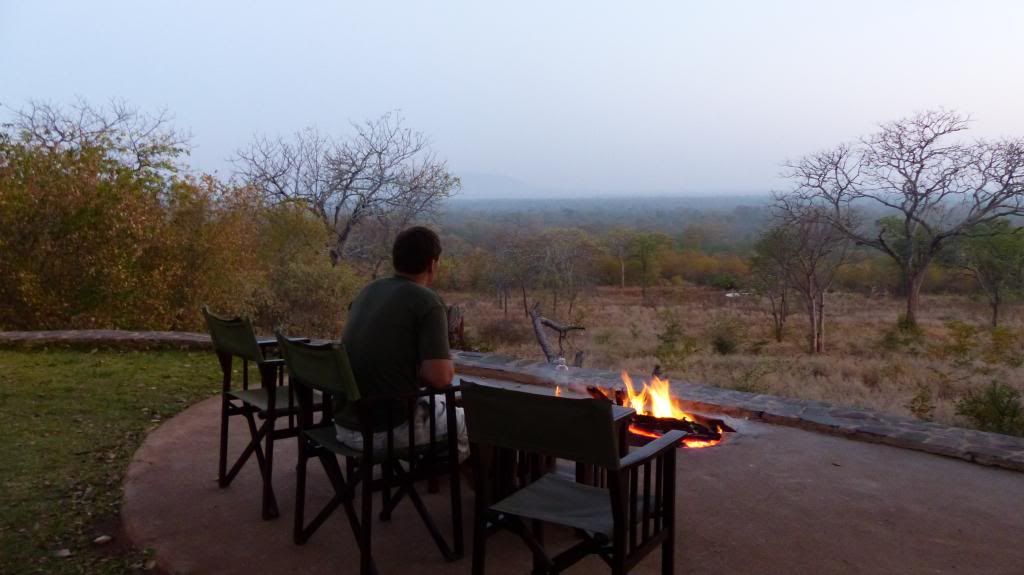 The mist hung heavy in the air, and limited visibility to a few hundred yards in many areas. Hyena and jackal scurried as we approached, having not yet gone to their dens for the day. At one water hole where we stopped to check for eland tracks, there was 200-300 guinea fowl scurrying about. It is an amazing sight, although their constant movement and fighting erases any tracks that may have been present from the night before. It had been a while since we shot anything, and the guys were asking for something to cook with their sadza lunch. Brett attempted a head-shot on a fat male guinea, but hit a little low-and right. The bird exploded at impact, but there was enough left to put a smile on the guys face. 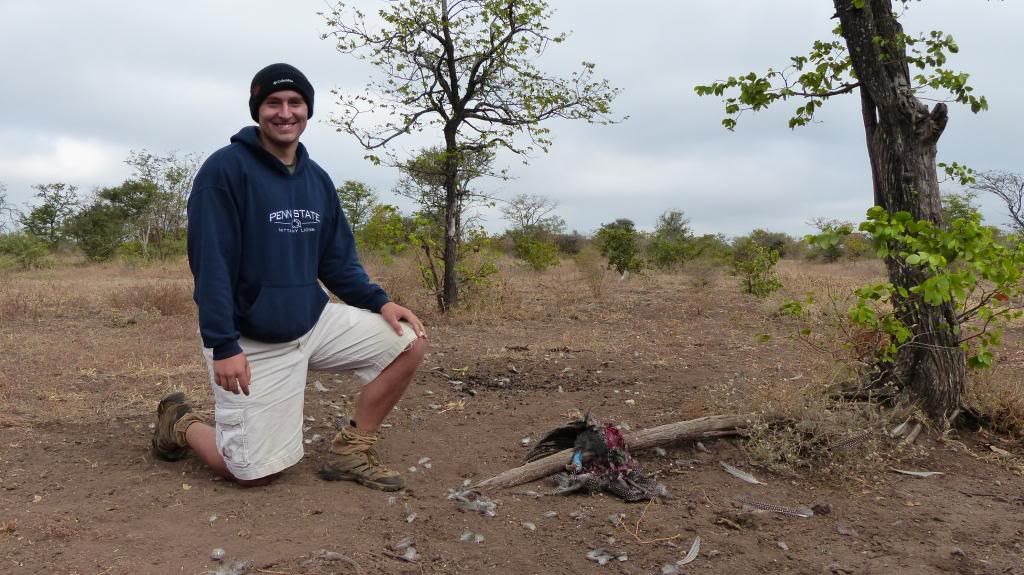 A lone wildebeest bull offered Brett an opportunity to put on a stalk, but he snorted and ran off before he was able to get off a shot. I was up for the next target of opportunity, which was a herd of zebra with several stallions, one of which clearly was dominant. I prefer to not shoot the males out of a herd, especially zebra, but in the BVC there are thousands and thousands of zebra to the point that they are culling to control their numbers. With the Lott, I stalked the herd which was walking single file and head down in front of us. When there was no more mopane scrub for cover, I slowly moved across the open ground closing the distance and in an attempt to intercept the male as he crossed in front of me. The stallion was almost directly in front when he stopped to glance in my direction. He took a few more steps then decided that this strange looking bush needed further investigation. As his head swung up, I shouldered the Lott, taking the safety off in the process. The front bead naturally settled in the rear v-sight, and as it found the shoulder, I fired. I did not hear a bullet impact, and the stallion showed no apparent reaction, but I felt the shot was a good one. Instinctively as he ran I cycled the Lott and fired off another round, but it was a long shot and I think I lead him too far as he changed direction. They disappeared in a cloud of dust. Looking back at the group, my immediate question was if I hit him with the first shot. The general consensus was no. We walked the ~50 yards to where he had been standing and found blood. Rich pointed to a few of the mares standing another 50 yards further, which meant that the stallion was likely down. As we approached the mares, the apparent second in command stallion gathered up the remaining mares and moved them off. The shot had been true, impacting at the point of the shoulder. The 350gr TSX sailed right through and did the job, but I’ll never know if and to what extent the pedals opened. 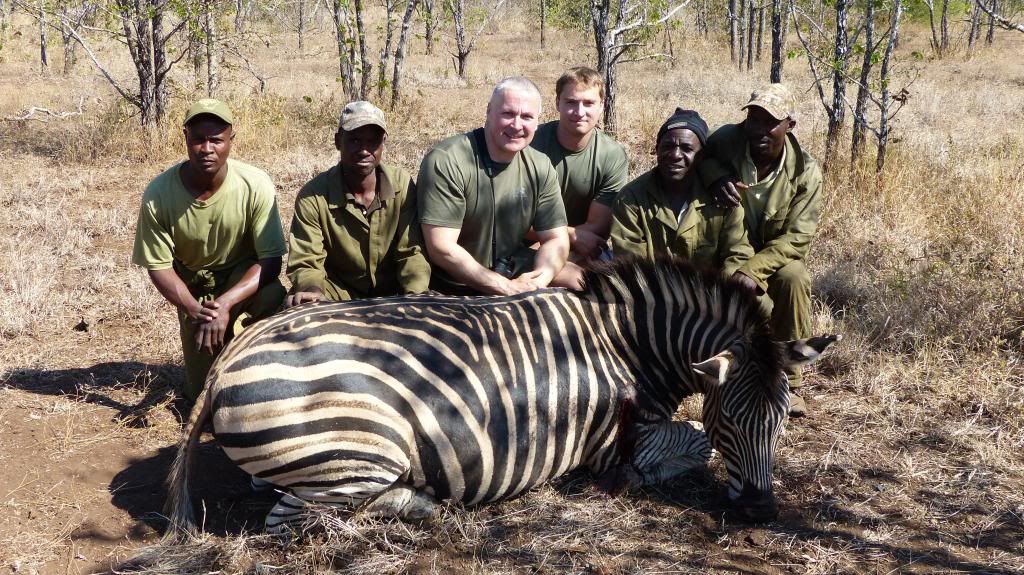 Ade remarked afterwards “The way you threw that rifle to your shoulder, I saw the elephant hunter in you, and I knew that the zebra was going to die”. Thinking about this, up to this point in the hunt, I had not really expressed the desire to shoot anything, being content in enjoying the hunting and watching Brett in his attempts to stalk game. I am sure this made it difficult for Ade, who probably wondered if I would ever pull the trigger. Before the trip, I spoke with several friends who gently expressed their concern that given some of my experiences, I might not be able to enjoy a plainsgame hunt. Deep down, I wondered the same thing, that after a few days I would begin to long for the excitement and thrill of hunting elephant. I am very happy to report that at no time during the hunt did this cross my mind. I was ecstatic after shooting this zebra, as the challenge and effort was comparable to most of the buffalo that I have shot. Make no mistake about it, hunting plainsgame on foot can be a LOT of fun, especially in an area where there is a lot of game and one does not need to be upset about blown stalks or missed opportunities. It is a stress-free hunt, and an ideal opportunity to spend field time with that classic rifle or double that is otherwise of limited use. Too, some plainsgame lends itself really well to “specialized hunts”, such as stalking bushbuck along a riverine forest, walking for klipspringer in the rocks, zebra or kudu in the mountains….or as was yet to come for Brett and me, tracking eland over open ground. 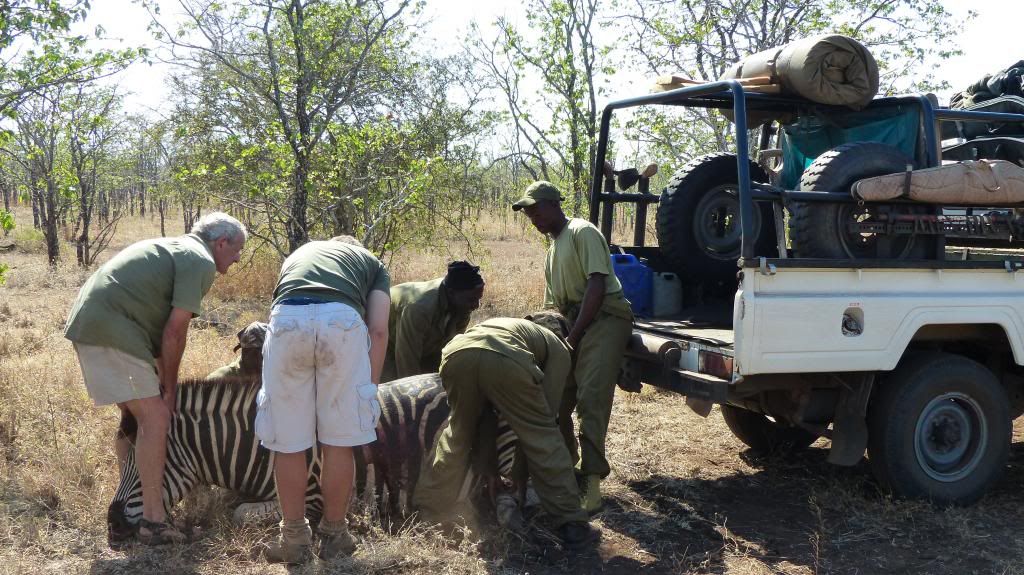 We took the zebra back to camp for skinning, and began packing for a night in the bush. The plan as discussed prior to the hunt was to locate an area where we could setup a basic spike camp, and sleep under the stars. The concern, which was expressed by virtually everybody we encountered, was the quantity of lion in the BVC, and their brazenness once the sun goes down. As a precaution, we would be heading to the granite kopjes in the northern part of the conservancy. The drive north was very scenic, the terrain more varied and the bush is thicker than in the south. Game seen in addition to the usual herds of zebra, wildebeest and impala included warthog and waterbuck. 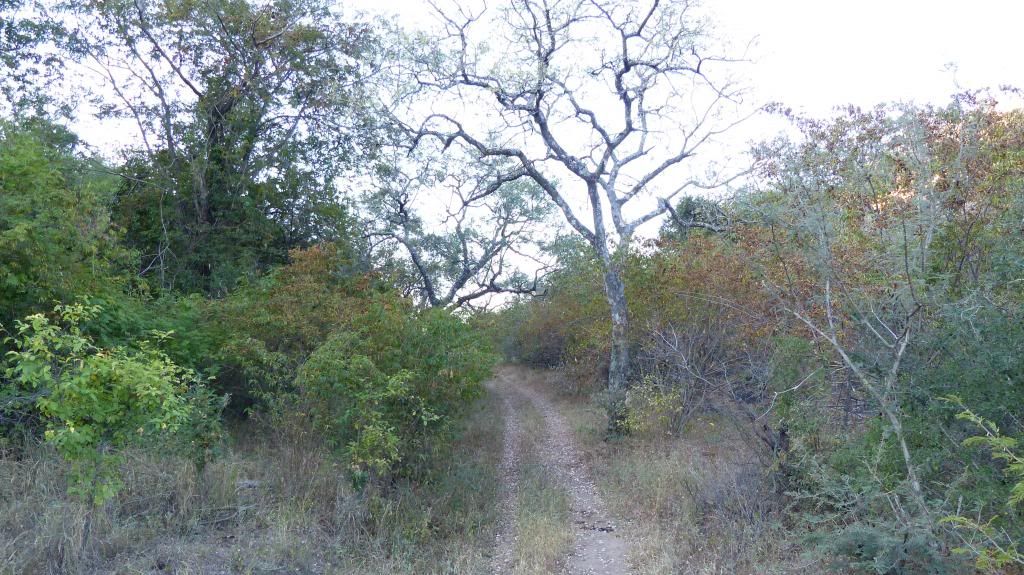 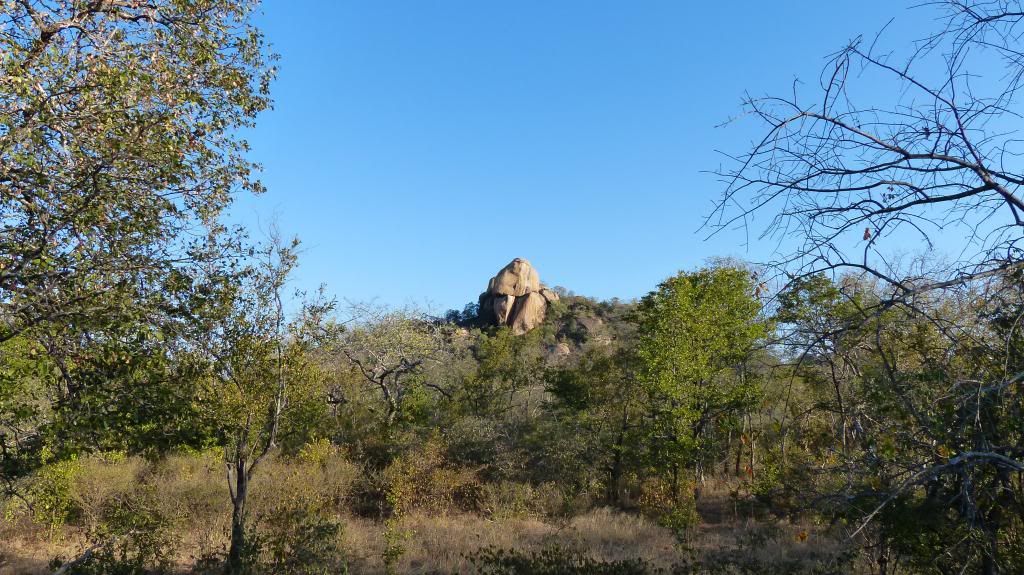 There are a few herds of elephant in the BVC, which were introduced several years ago. They are big-bodied, from Gonarezhou National Park if I recall correctly. According to the guys at the BVC, elephants periodically break-in from the outside areas, and finding everything they need, remain. To control their numbers noting their ability to quickly reproduce and change an ecosystem, there will be limited take-off of bulls. 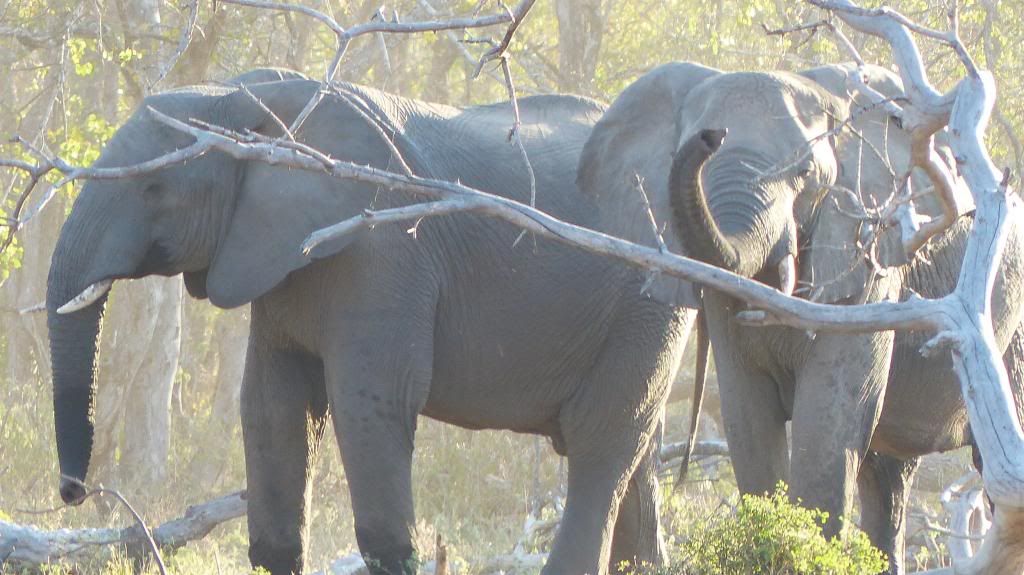 Reaching one of the high points in the conservancy, we scrambled to the top of the hill to scout an area to setup camp. A granite flat was selected for sleeping, and a path identified to get the Cruiser to within a reasonable distance. 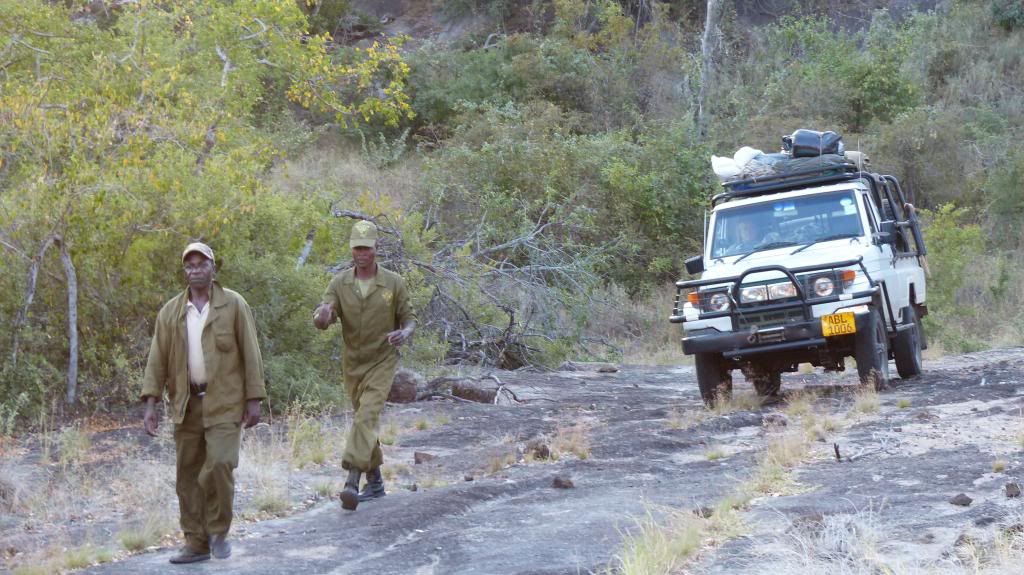 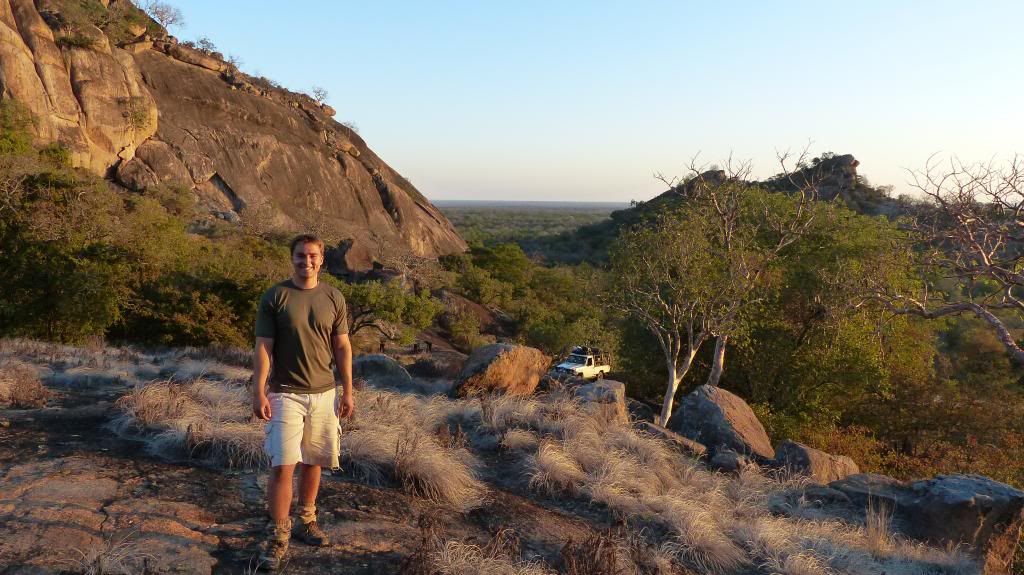 We unpacked the essentials and moved the Cruiser. Paul and Richard lugged heavy mopane logs up from the bottom of the hill, and even managed – in typical African style – to produce a smile when I asked them to please pause for a picture. 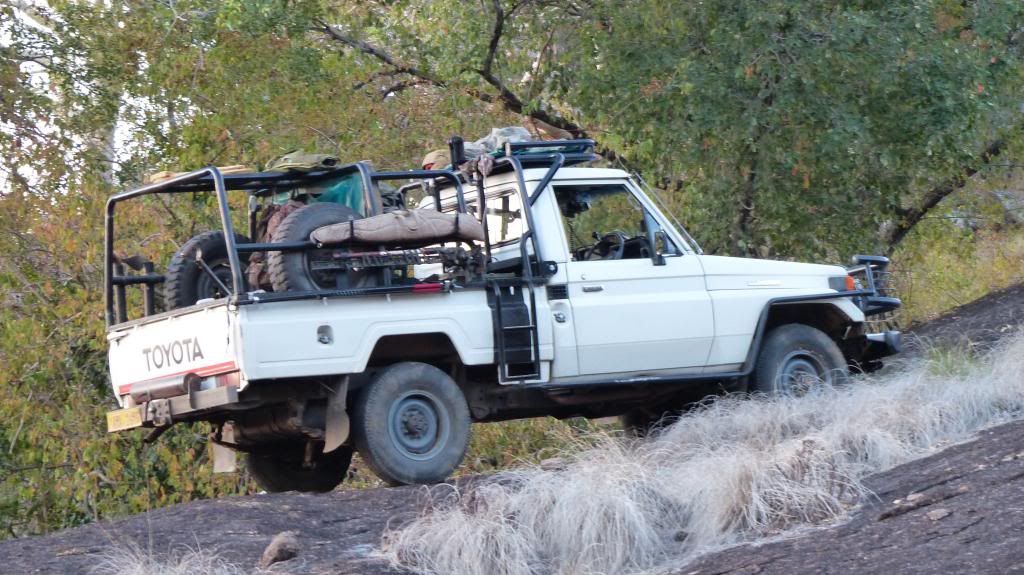 It was a glorious sunset, watching the fireball sink beneath us. Africa changes once the sun goes down, and everybody and everything seems to swallow hard in preparation of the inevitable darkness. The air instantly begins to cool. The bush becomes silent. The nights are long, and it would be 12 hours before the sun would rise again. 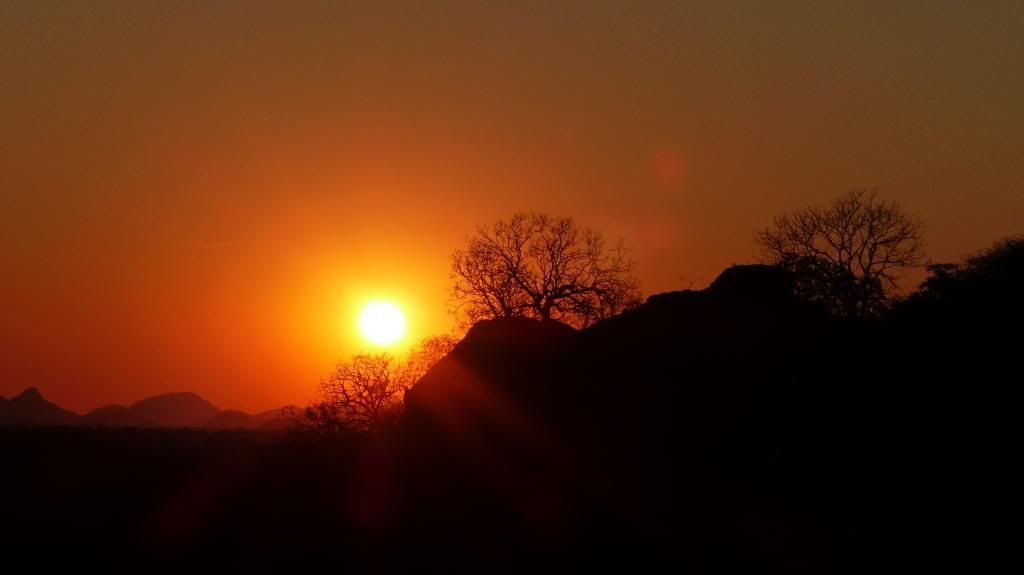 With a warm fire, the eeriness dissipated and we turned our attention to cooking dinner. Better than any five-star restaurant in my opinion, Paul worked his magic on a pot of beef stew and sadza. 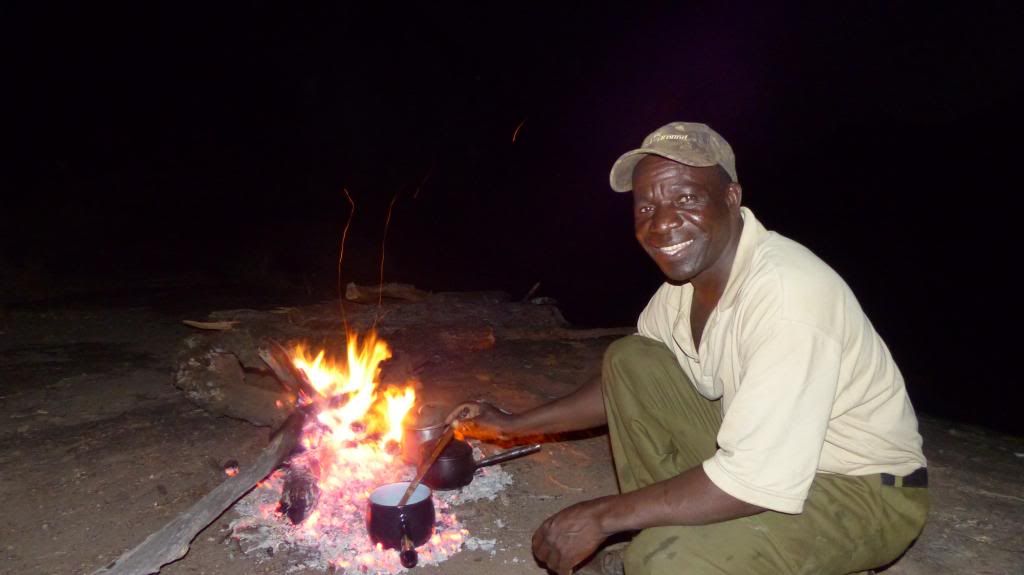 After dinner, we prepared the sleeping area. Brett and I had brought along inexpensive sleeping bags, and I snuck in a Therm-a-Rest sleeping pad for a little extra cushioning. 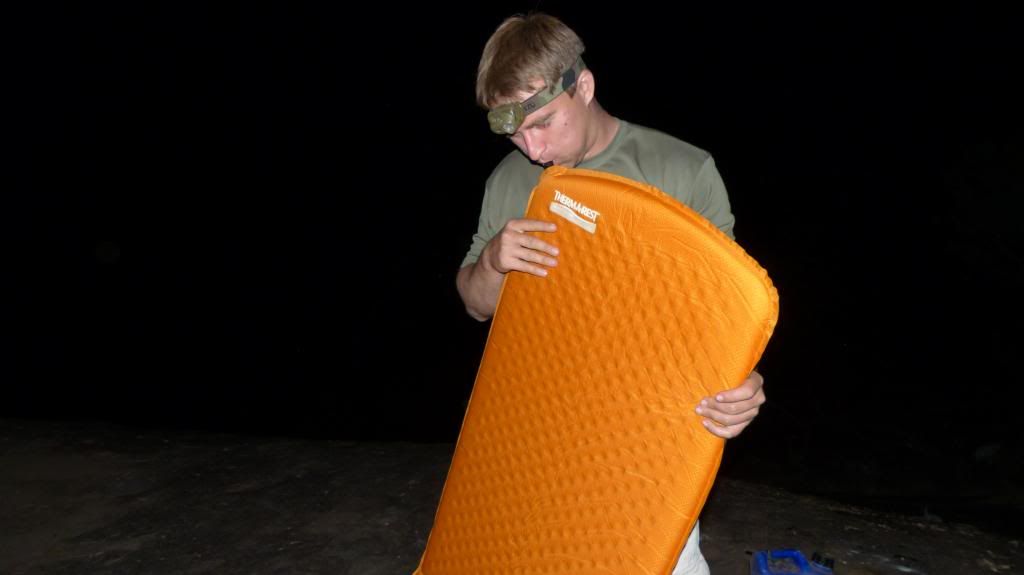 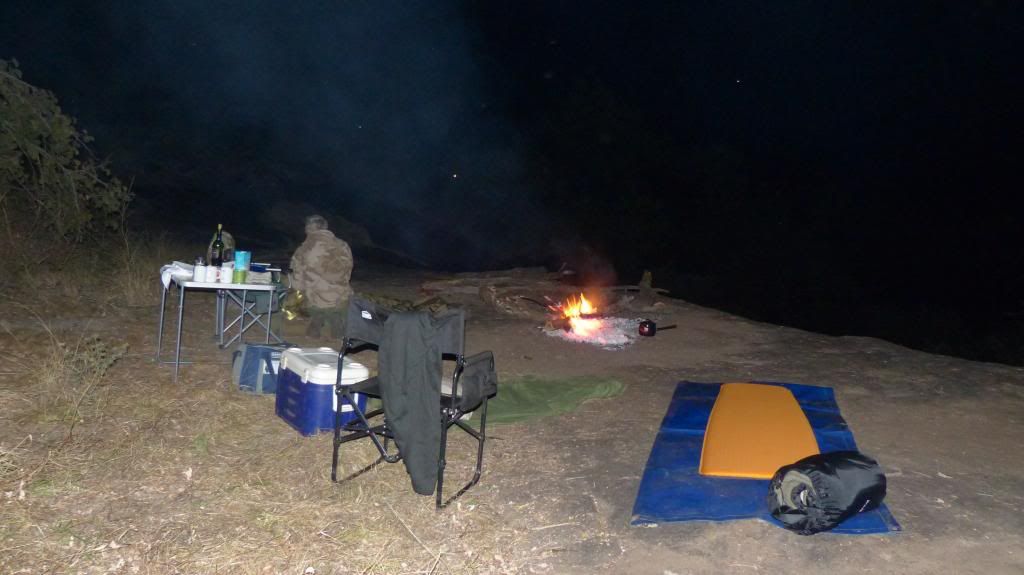 The night sky was stunning, and I lied awake for quite some time watching the stars, and passing satellites as they orbited. I thought about all that it took to get to exactly where I was at this moment in time, and how perfect it all was, knowing that in the months that follow, this would be the time and place I would most like to return to if it were somehow possible. The cold was made bearable by the warmth of the fire which I tended during the night. Warthog oinked at the bottom of the hill while zebra barked in the distance. Lion called periodically, and while maybe 3-4K away, they were still pretty close. When they stopped calling is when I fondled the Lott, which found a home next to me during the night. Closest to the fire and surrounded by Ade and me, Brett slept well. Ade zipped himself into some type of sack that he used to use while working for Parks, and I didn’t stir until the sun rose! HUNT DAY #5 When the guinea fowl and doves became active, I knew that the sun would soon rise.  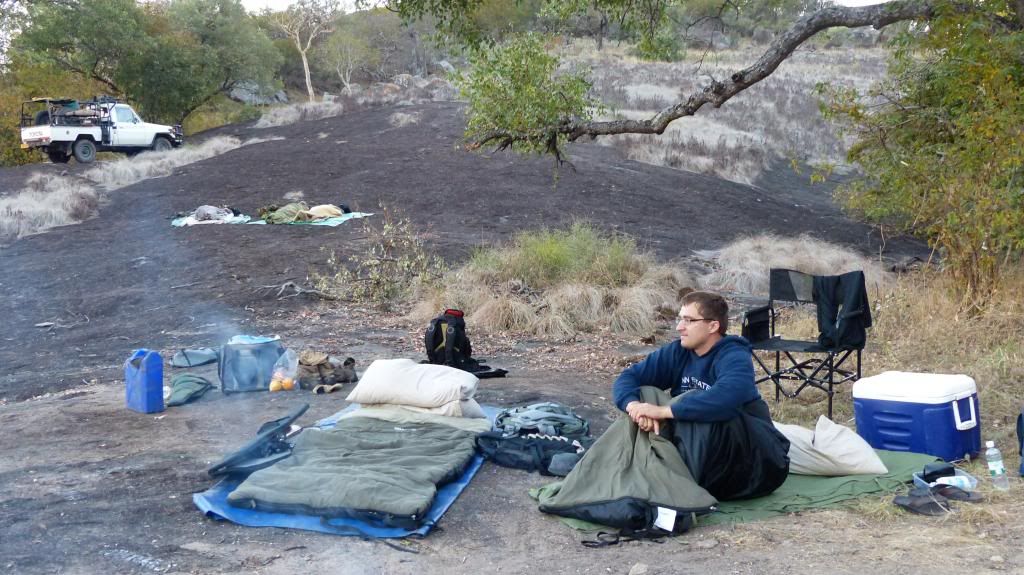 After a bowl of oats and some cheese, we packed up the Cruiser and worked our way back down the hill. It was going to be a long day. 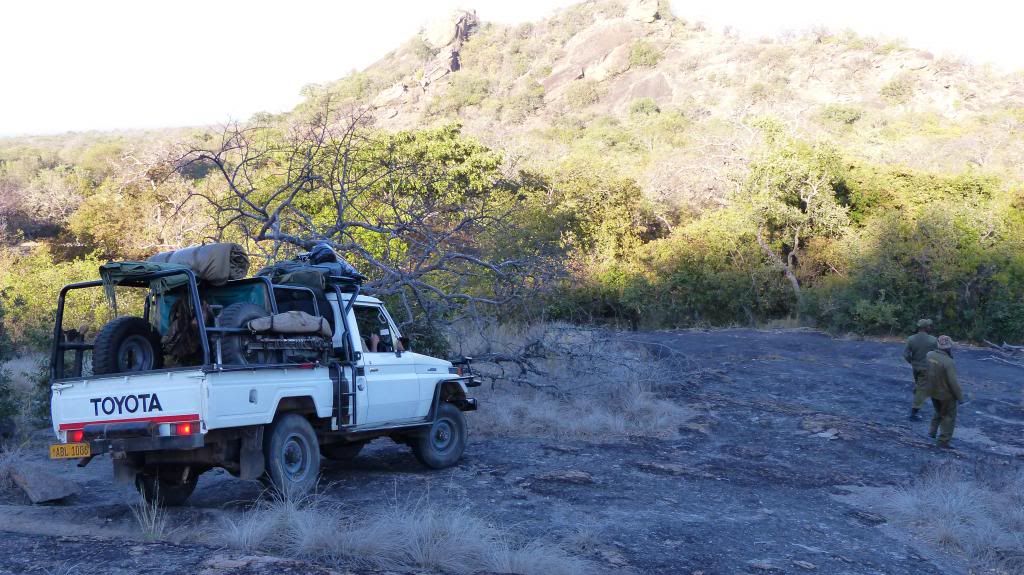 We hunted in and around the granite hills looking for kudu and eland. We tracked a lone eland bull for several miles, having to give up the pursuit when he crossed into the neighboring camp (Fimbira). We did spot a nice klipspringer, but there was no quota available. This was fine by me, as the pair seemed to be enjoying their morning. The bird pictured below I believe is an African Black Eagle. 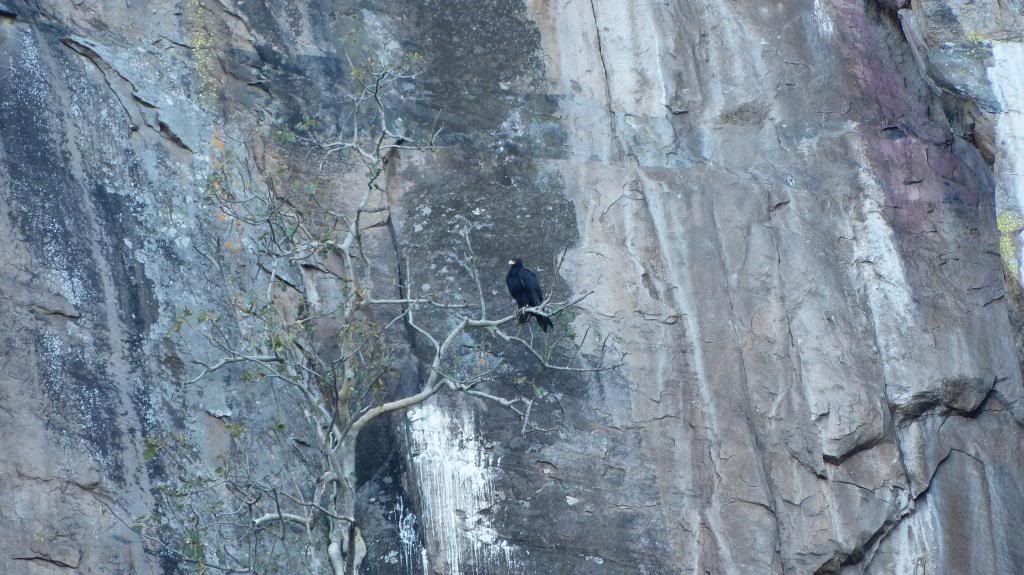 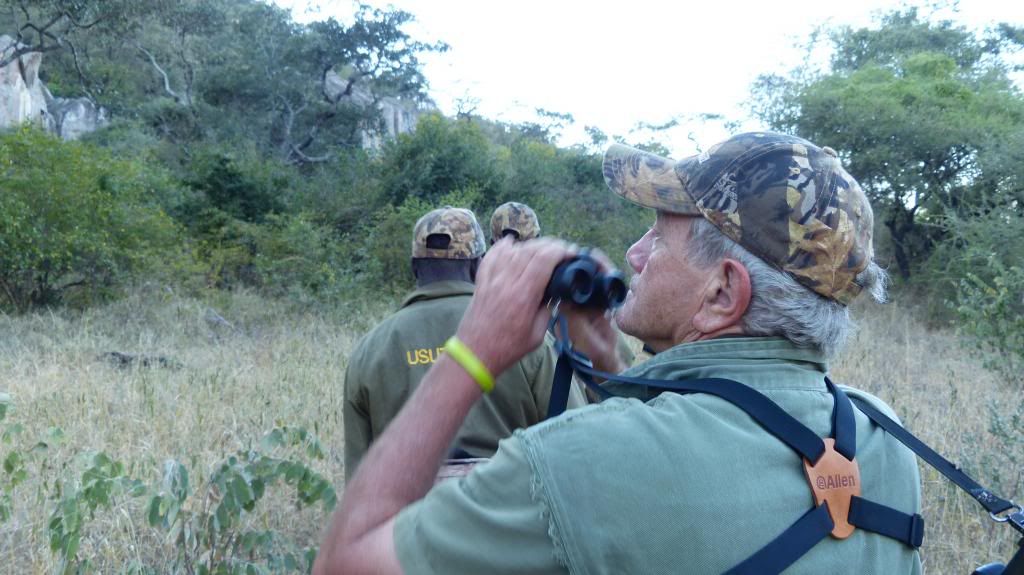 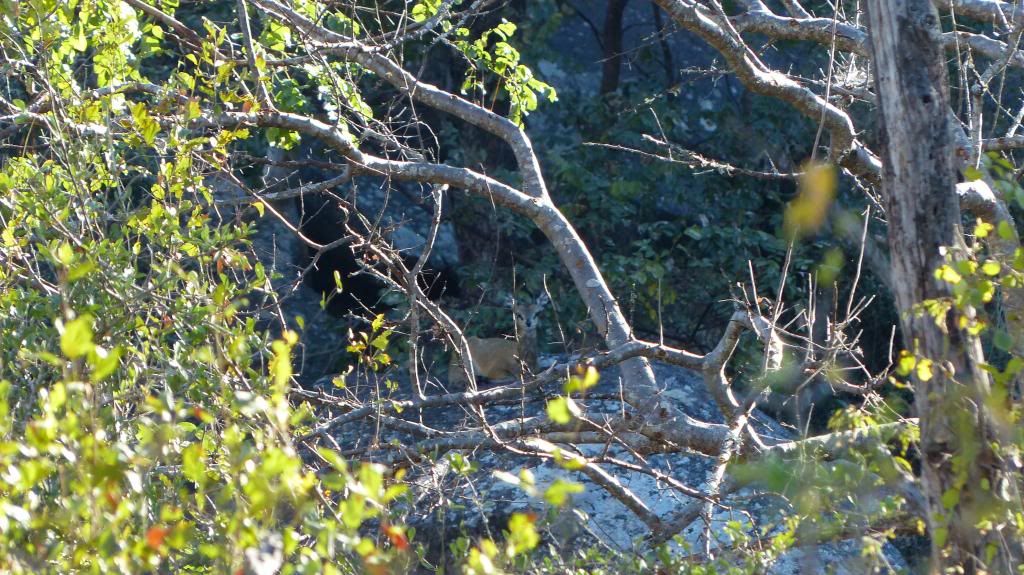 We gave up on another eland bull after 3hrs of walking. We made the mistake of bumping him, at which point he was on guard and very clever. Like buffalo tend to do, he would periodically change direction so that the wind was to his back. When resting, he would take up a position opposite an open grassy area where he could see our approach. After finding where he stood watching us before running for the third time, and given that we were within 2K of the area boarder, we gave up the chase.  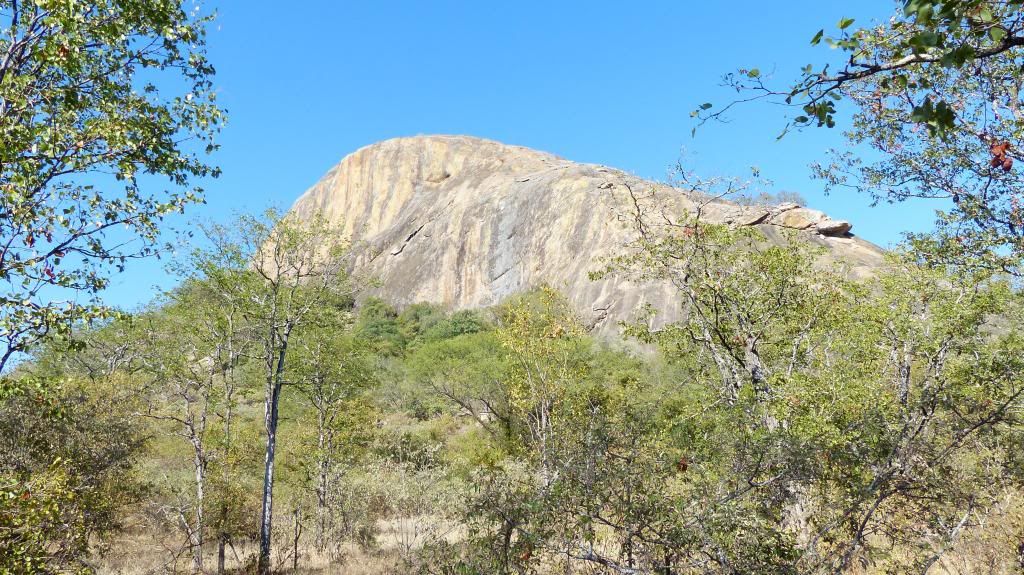 After hours walking the open bush, we encountered a herd of impala along the dirt track a few hundred yards from the truck. Go figure. Brett put on a stalk, but they already knew we were there, and ran when he began to get close. 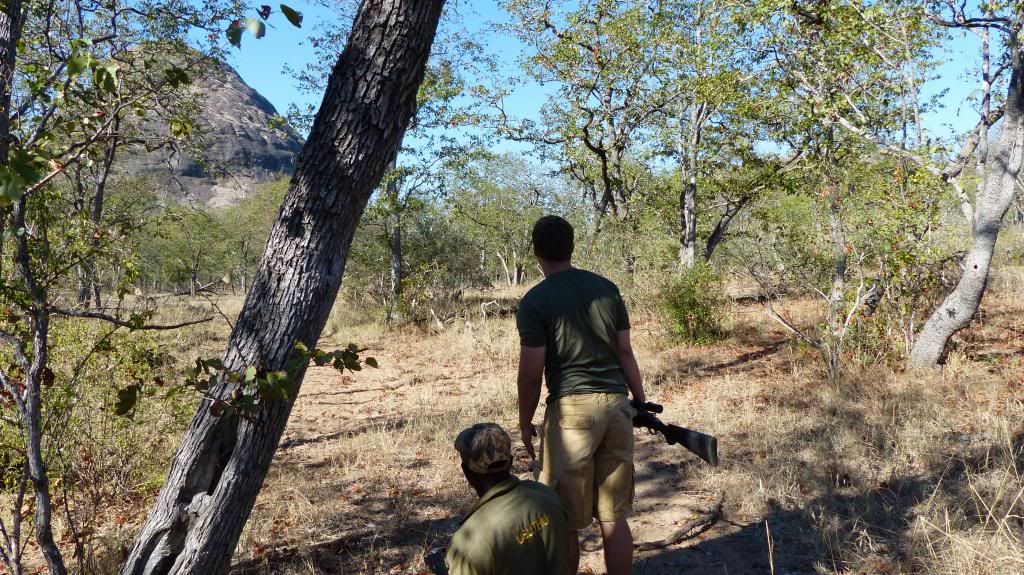 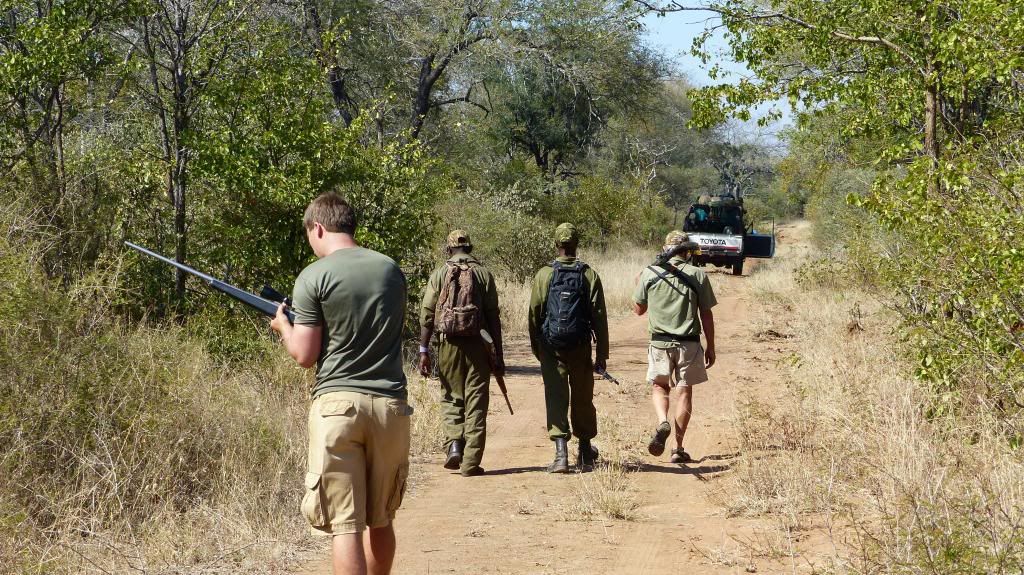 On the way back to Chamalaya, I took some pictures of an old tattered-ear elephant bull, drinking from one of the water holes. Not carrying large ivory, I hoped that he was free to live out his normal life within the safety of the BVC, but the reality is that a bull such as this will likely be shot. Elephant cause conflicting emotions. 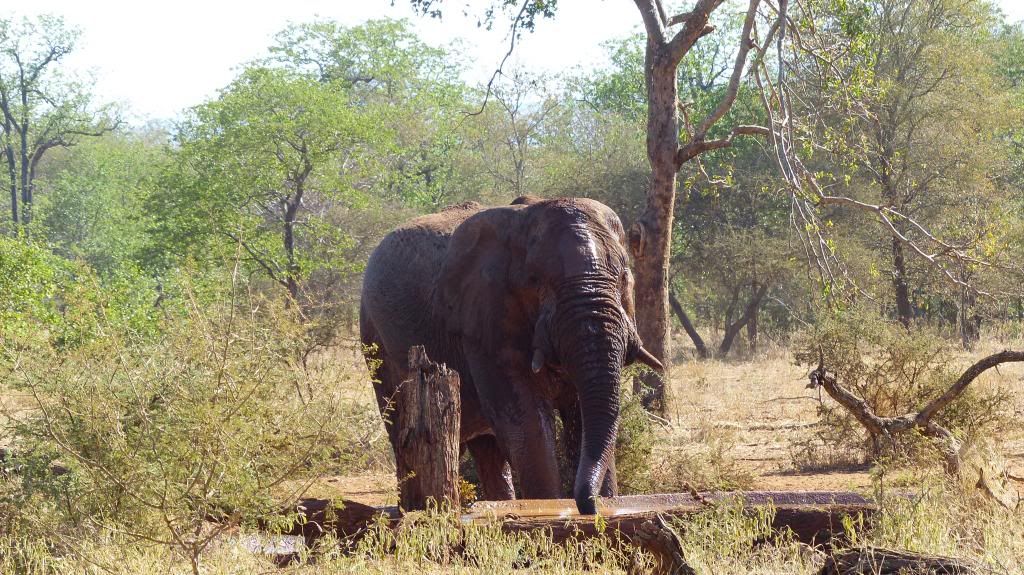 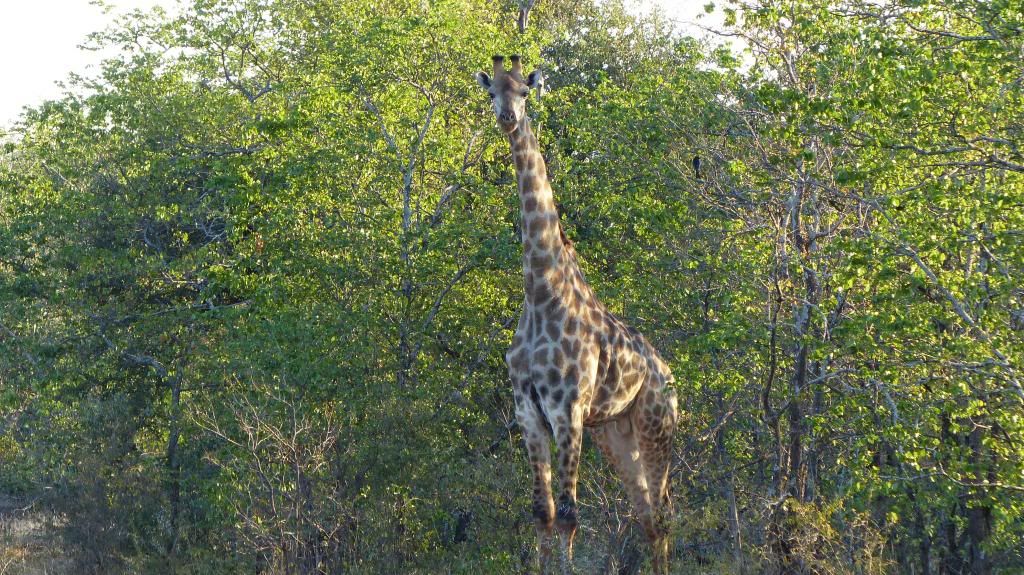 After some kudu burgers and a much needed nap, we took Ade’s .22 out for some bird shooting. Typical .22 round nose bullets most often sail through a large guinea fowl, and although likely deadly, the strong birds are able to fly off and often cannot be recovered. In previous hunts, I used hollow point rounds, and the difference was dramatic. Brett and I each hit and lost one bird, at which point we vowed to only take head/neck shots. During the night hunt, I declined a large hyena which appeared to be confused and ran directly at our truck. We saw a few genets but were unable to get lined up. Using the .300, Brett made a nice shot on a large male jackal. The 180gr Barnes TSX did a number on his pelt, due in part to the shot hitting bone but also the inherent velocity of the .300 mag. Dinner was once again awesome, tender sable filets cooked medium rare, mashed potatoes (not from a box either!), zucchini and squash, pees with cheese and a pudding for desert. With day five down on our eleven day hunt, we made a plan to do a bit more driving in an effort to locate kudu and/or eland. With two tags each, and no success thus far on foot, we decided that it was time to put some miles on the Cruiser. I also hoped that we would finally see lion, which everybody else seems to trip over on a daily basis! The bush around camp was active with lions and hyena calling until daybreak. HUNT DAY #6 We did indeed see more game today, but mostly wildebeest, zebra and giraffe which seem to be the predominate species in this area at least during this time of the year. We shot a few GF’s for the table, Brett and I making nice neck shots using the .22. For fun, we did a trophy pose with the mornings take. In all honestly, we enjoy shooting guinea fowl as much as any aspect of a safari. 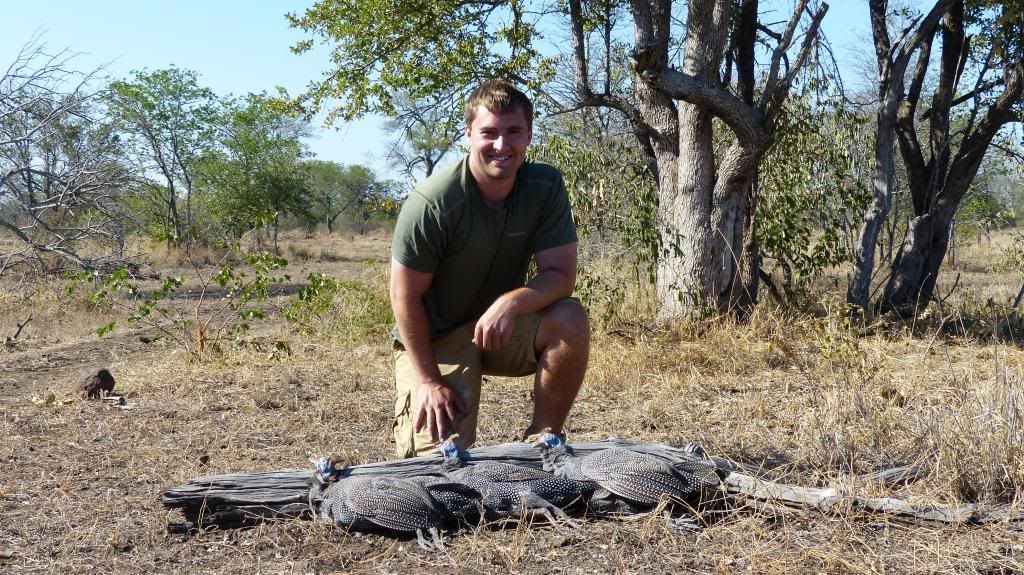 An old hard-bossed bull guinea fowl: 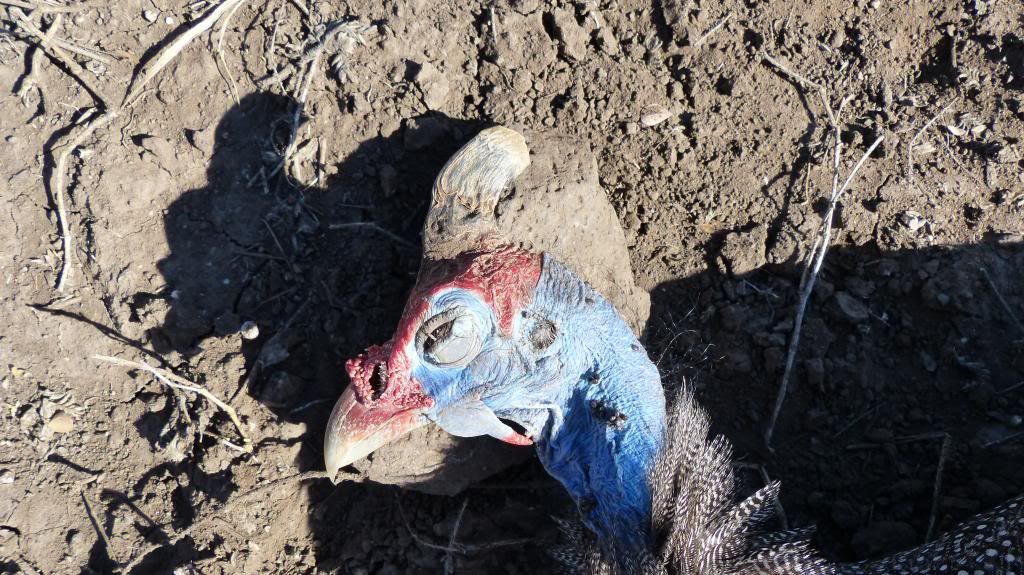 After lunch we packed our belongings and made the move further south to the Ngali camp. It was only an hour drive, during which we met Blondie along the road at the southern boundary of the conservancy. I do not know much about Blondie, other than he severed time in the war, lives in the conservancy with his family, and for years has done a fantastic job managing the BVC on behalf of the shareholders. A man of principal, he does not always see eye to eye with the various professional hunters, noting that as one can imagine there are many PH’s vying for a piece of the BVC pie, but I believe all respect him for what he has been able to accomplish. Other than a handshake, Blondie did not seem too interested in chatting, but he was very agreeable to Ade’s unusual requests and for this I am appreciative. 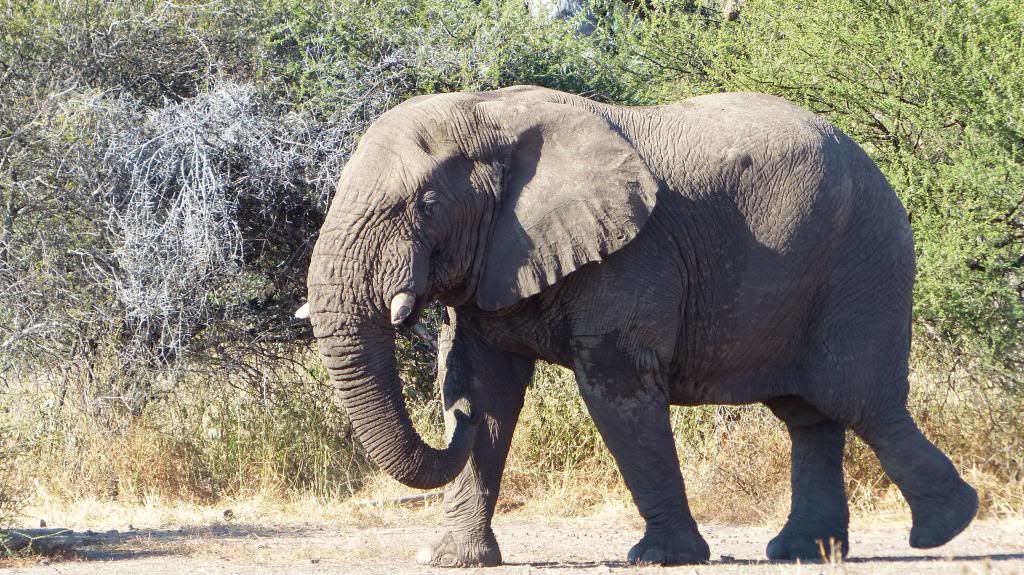 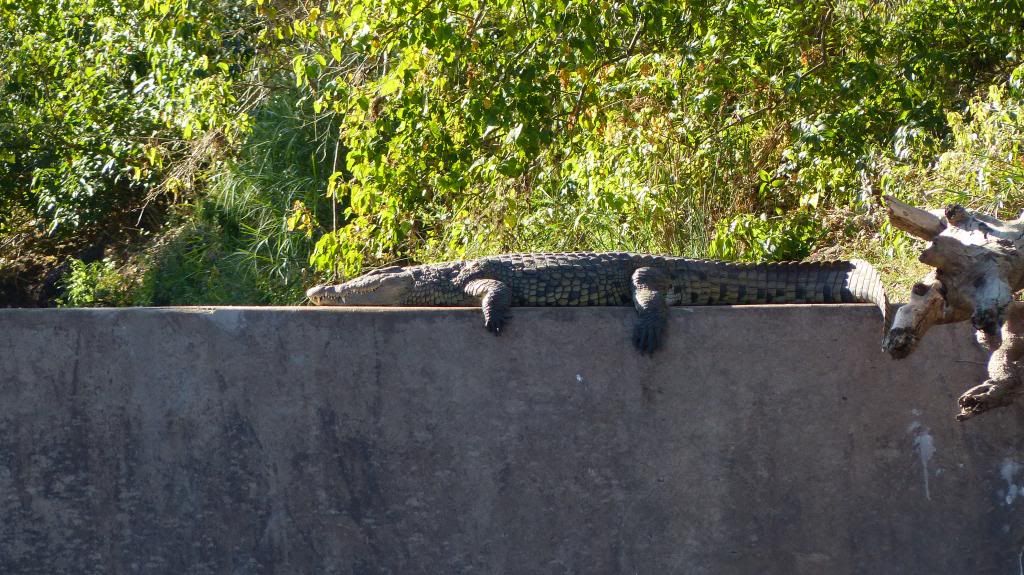 Ngali is a comfortable bush camp, but small and sometimes noisy given the proximity of the staff buildings and kitchen. There is a perimeter fence, which given the lion activity in the area, is prudent. The brush area directly in front of the huts is a haven for birdlife, especially franklin and guinea fowl which roost in the trees. 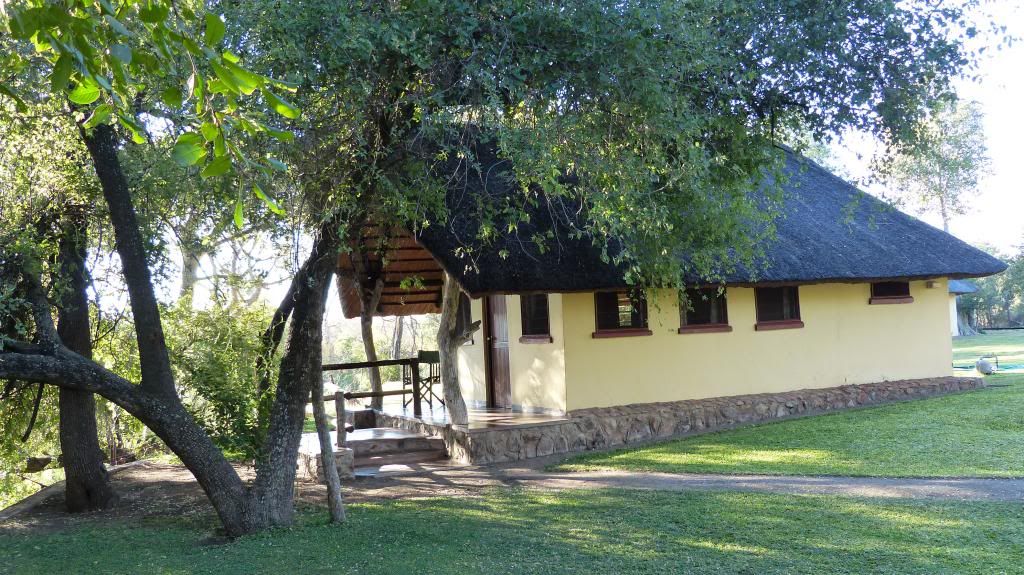 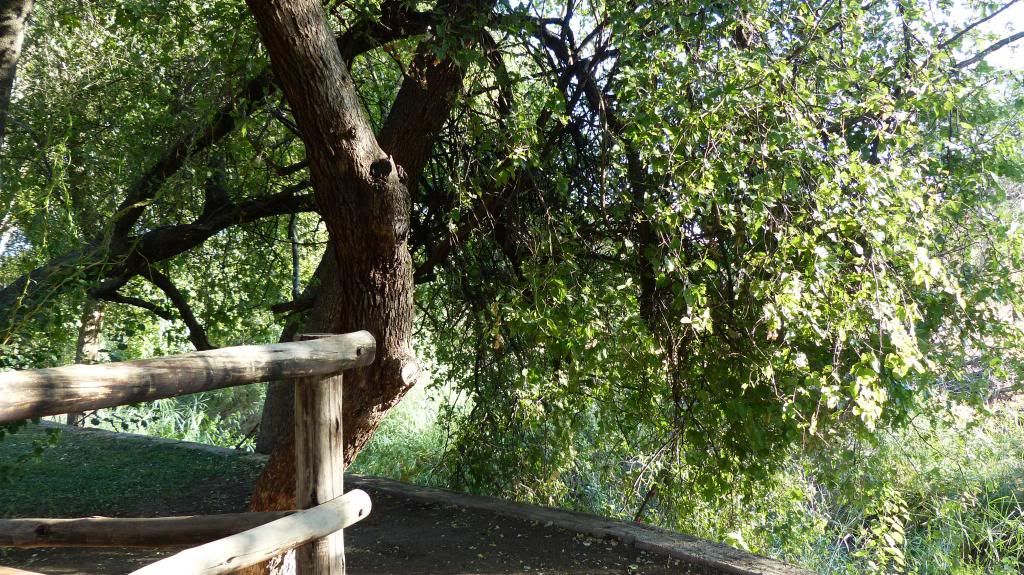 We drove the area late afternoon, seeing three young eland bulls. 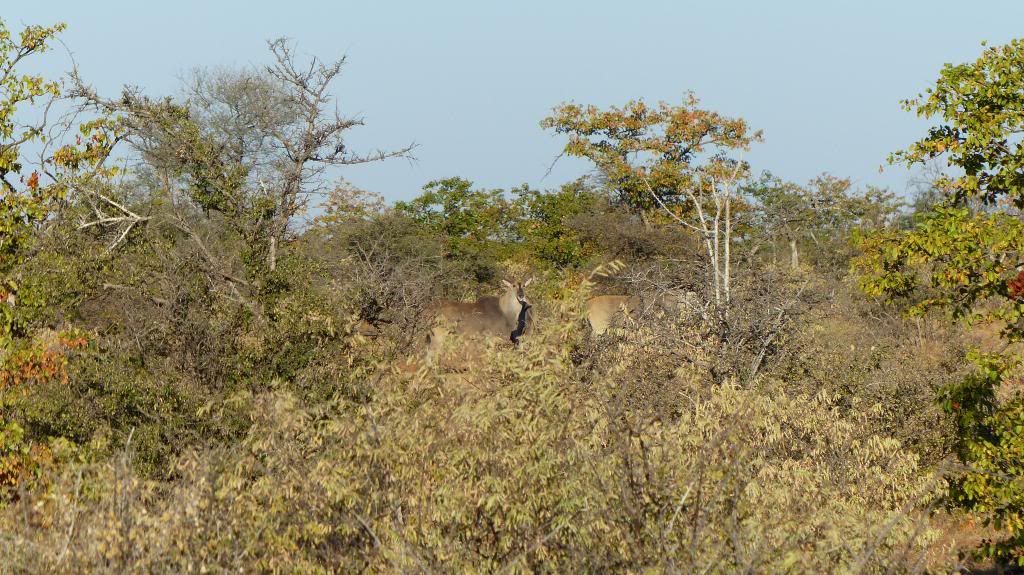 After an hour of spotting, we returned to camp for a shower, dinner, and fireside chat.  HUNT DAY #7 We awoke to the chatter of birds in the trees outside of our cabin, and jackals whelping seemingly in all directions. Leaving camp at 6:45am and not returning until 6pm, it was a nice full day. Brett and I rode in the back of the truck, appreciating the comfort of the high-seat in Ade’s Cruiser, noting that the smooth roads of the BVC sure don’t hurt (as compared to say Chewore North!). He has a custom metal tool box on the floor which makes a nice place to stand while holding on to the rails of the roof box. I have been in Cruiser’s before that did not have anything to stand on, which meant that you either sat the entire time, or stood on the floor of the bed, face-level with the roof of the cab, and with no way to absorb the bumps using the knees. We checked for eland tracks at a pond, but guinea fowl and quelea (sparrow-sized birds found in the billions in Africa) feet erased any signs that may have been present. 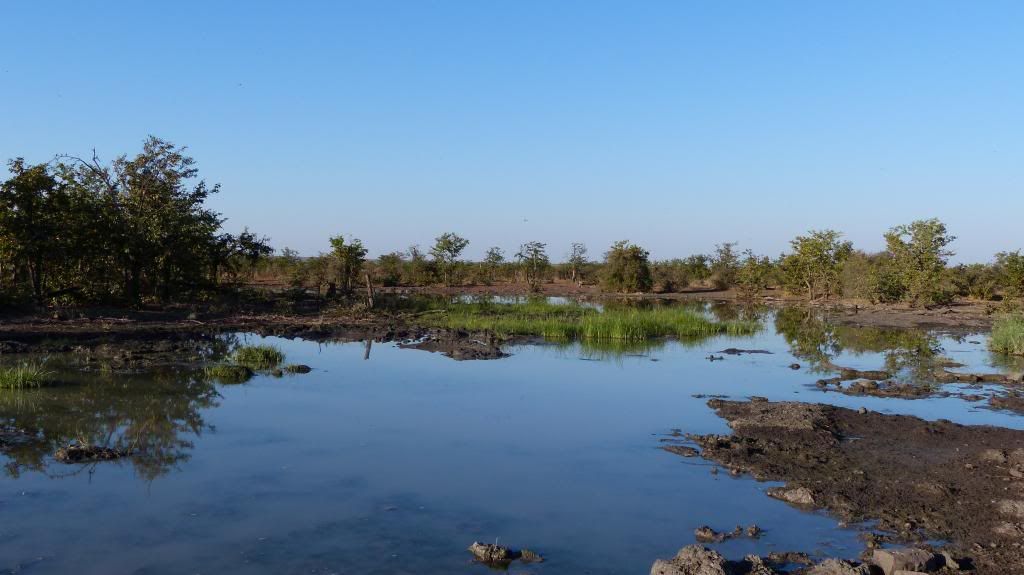 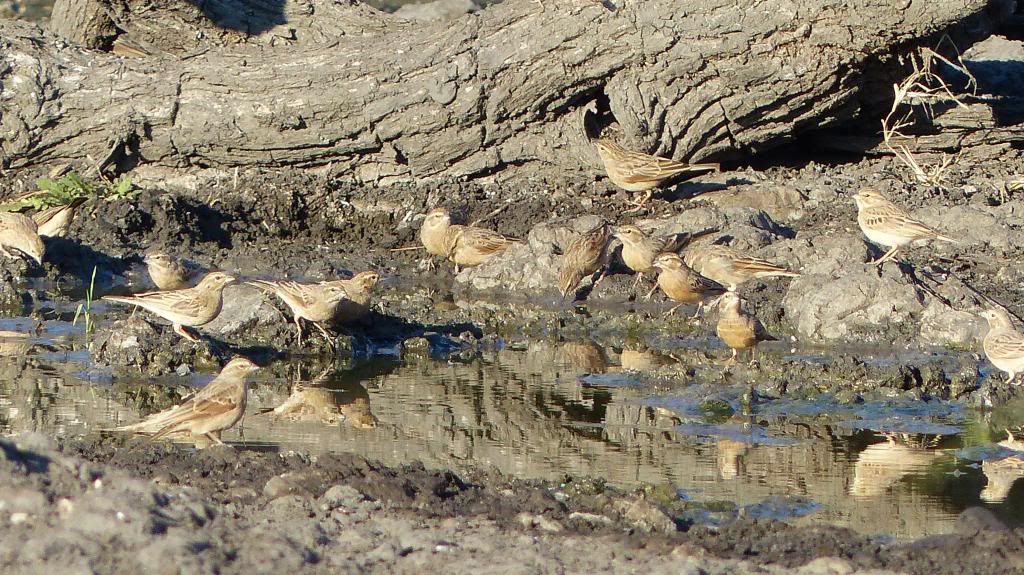 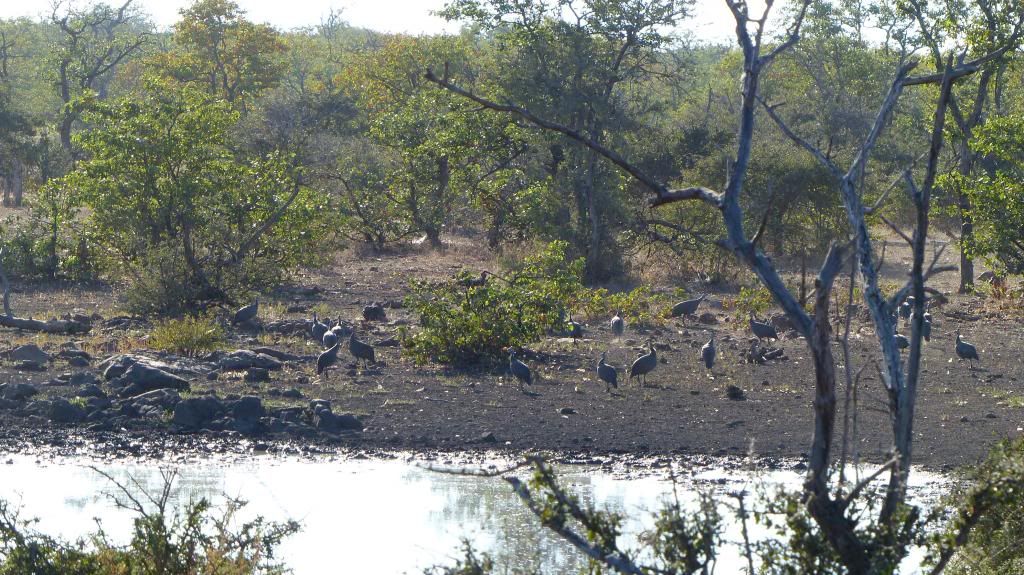 A Kori Bustard was hunting, which can stand over four feet tall and weigh up to forty pounds. 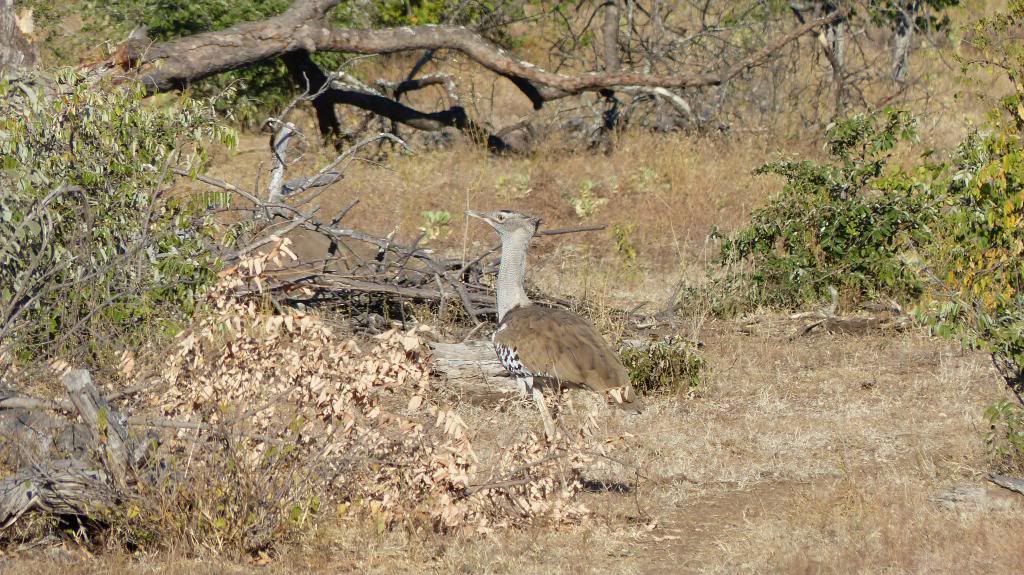 Finally, while driving a relatively open area near the Lion Research spike camp, the guys spotted a pair of lion a hundred yards off the dirt track. Ade idled the Cruiser closer, as I madly snapped pictures with the Panasonic, not knowing what their reaction to the vehicle would be given that most game has been cautious bordering on skittish. As they were likely accustomed to Paul’s truck (more on Paul later), the young males were calm and gave us time to observe and take pictures from a few different angles. 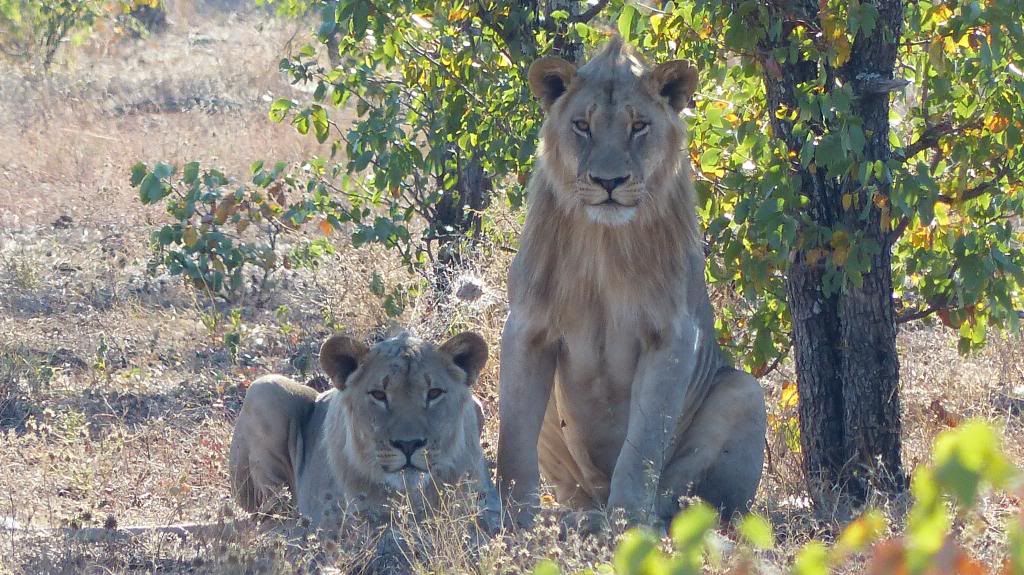 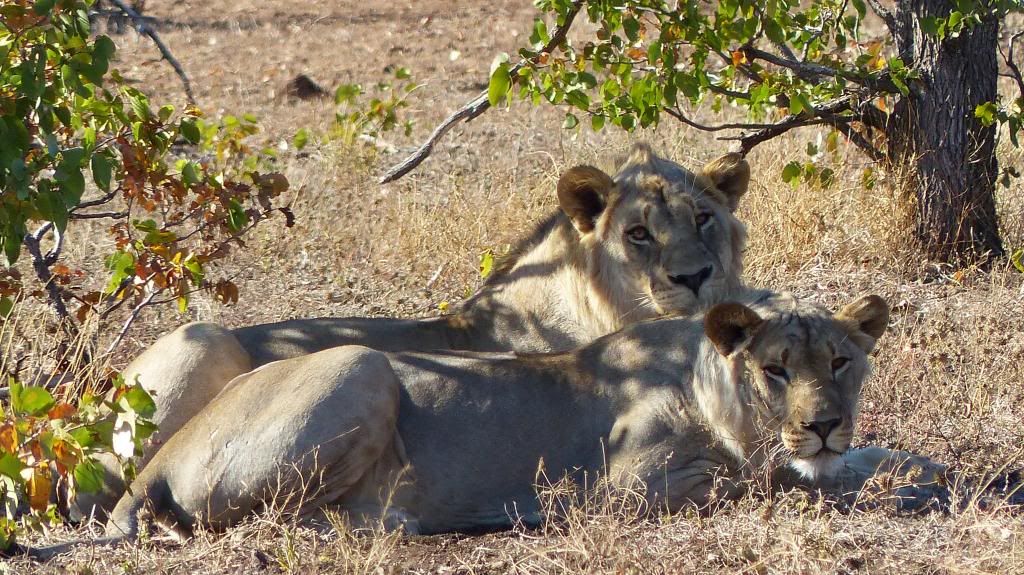 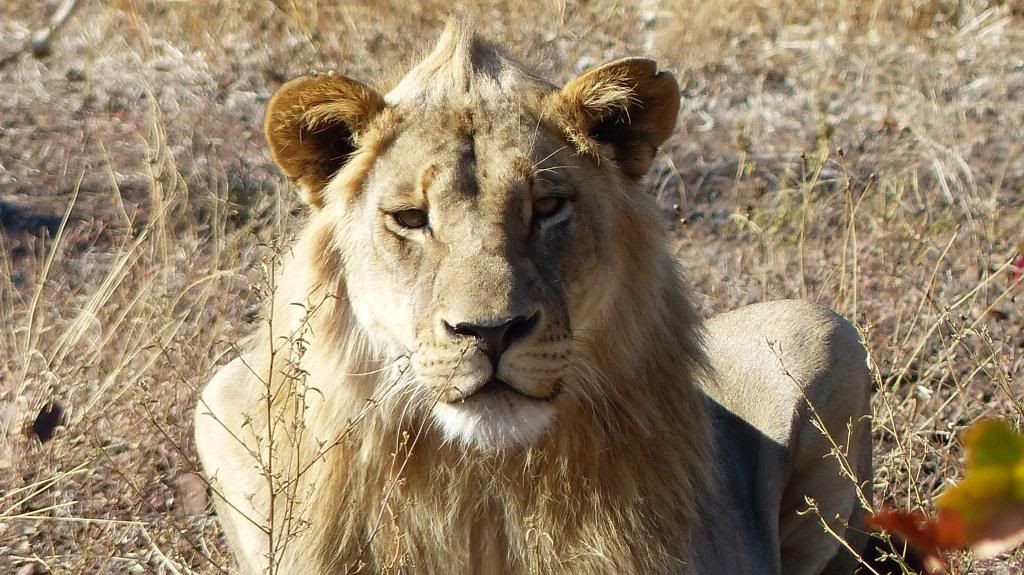 There is a limited number of gemsbok (oryx) on the BVC. They were not indigenous to this area, and given the high trophy fee as compared to their native ranges in Namibia and Botswana, they are not something I would personally shoot. But, somebody must and if it helps keep the BVC profitable, so be it. 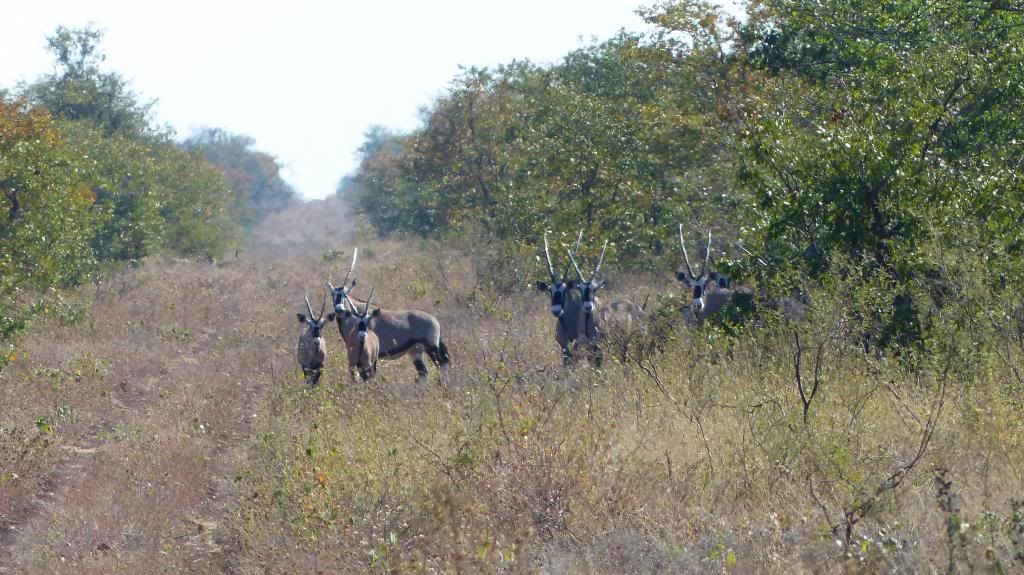 At 12:30 we stopped for lunch along the dry Mazunga River bed approximately 1km from the southern boundary. Richard and Yobane made a fire and whipped up another terrific bush lunch of nyami (meat steaks, either impala or kudu) cooked over hot coals, and sadza. For those who never watched the guys cook their sadza, make it a point to next time. The sadza (corn) meal is gradually stirred into a pot of boiling water until the mixture is just the right consistency. 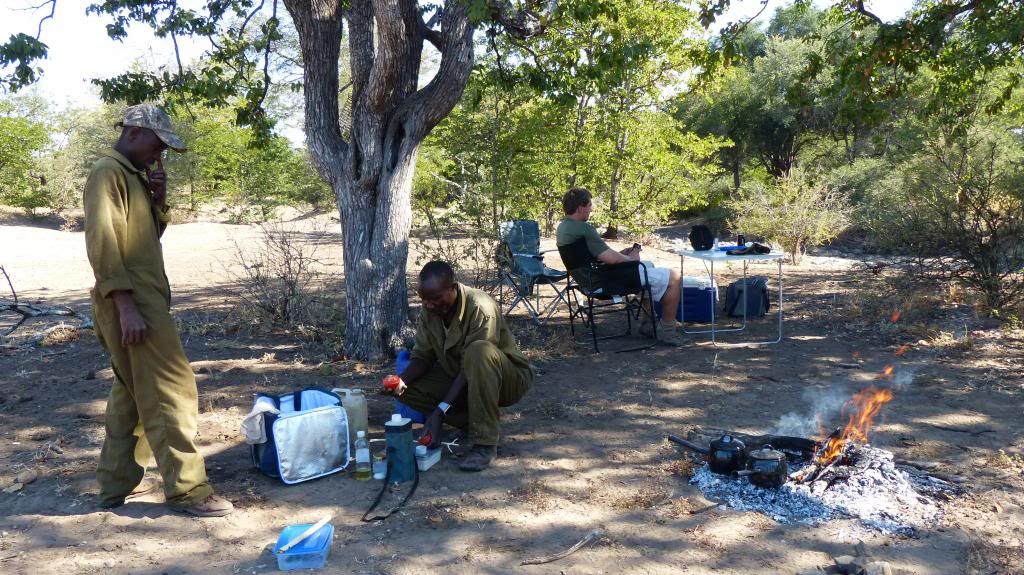 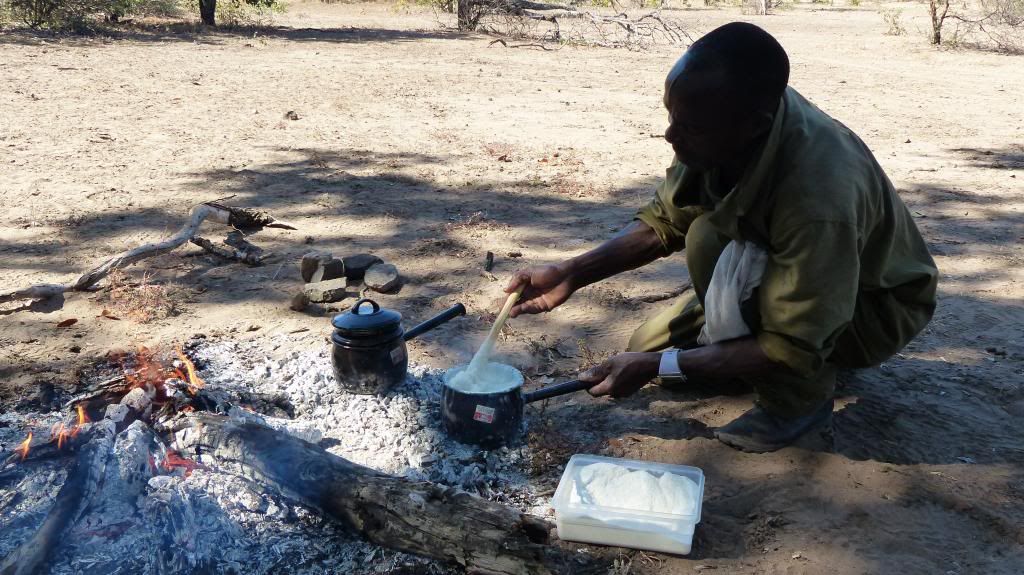 After lunch, we each found ourselves a spot to spread out a rolled blanket and get a bit of rest. Mine was poorly selected, as after 15 minutes the sun changed positions and was baking me. At least there are relatively few bugs in the area, which was unlike previous hunts where I have been tormented by tsetse flies, mopane bees, common flies and mosquitoes. Rousing before the guys, Brett and I explored the dry river bed, unearthing several skulls including a giraffe. By 3pm we were back on the truck driving the fence line heading north. I admit that seeing the fence and more so the vehicles on the tarmac road was a bit of a reality check, but the fact is that the BVC is a private for-profit conservancy located in an inhabited area, and it could not exist without a fence to keep the poachers out (and as the song goes, to “keep all the nature in”). This is not to say that poachers do not occasionally sneak in, although given the presence of rhino the security at the BVC is taken VERY seriously. There are also lion, who in and of themselves are a powerful deterrent!  Having witnessed firsthand the heavy poaching in the wilderness areas of Cameroon, Tanzania, Zambia and Zimbabwe, I accept the fact that inevitably private conservancies like the BVC and Nuanetsi may be the only way forward, at least for plainsgame. I would include the Save in this list, however, I do not have a high degree of confidence that they will straighten things out, and fear that in a few years from now it will end up like so many of the other private ranches in Zimbabwe, land ownership in perpetual dispute and poaching rampant. I hope this does not come to pass. Cheetah are found in the BVC, although I have to believe that as lion numbers increased their numbers declined. We were fortunate to see a female on a kill, not more than 2k’s from where we took lunch. Unfortunately I was not able to get good picture, the Panasonic is fast to deploy and I most always had it at the ready, but when she stopped the camera auto-focused on the bush in the foreground and the image of the cat is blurry. Each evening Brett would download the pictures to his laptop as a precaution, and it was most often disappointing as on the cameras LCD display it appeared as though I had captured a great shot, only to find the picture blurry. The zoom and Leica lens on the Panasonic are fantastic, but the problem is that I tended to zoom too far not realizing that the camera was actually focusing on a bit of brush or grass in the foreground. 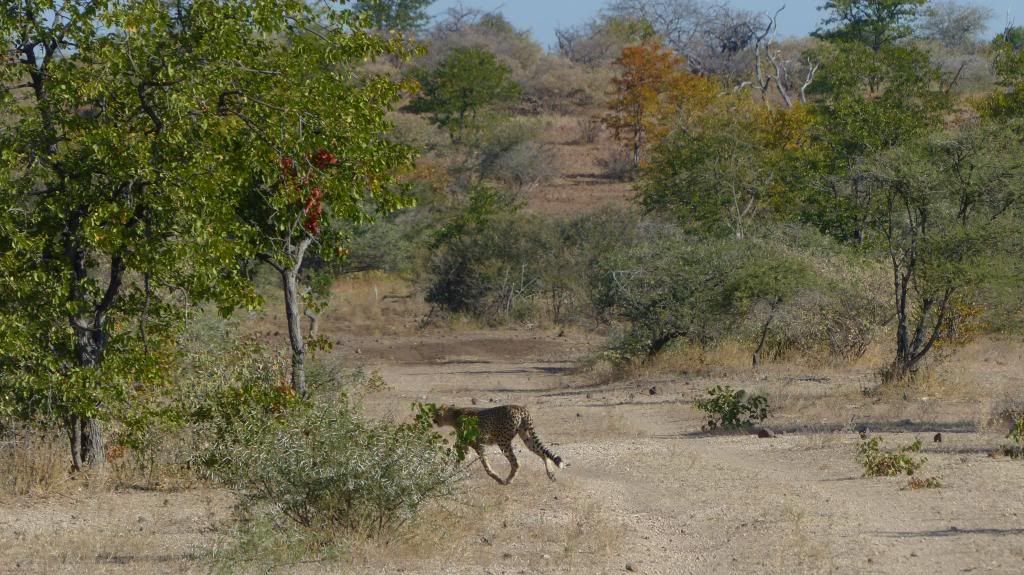 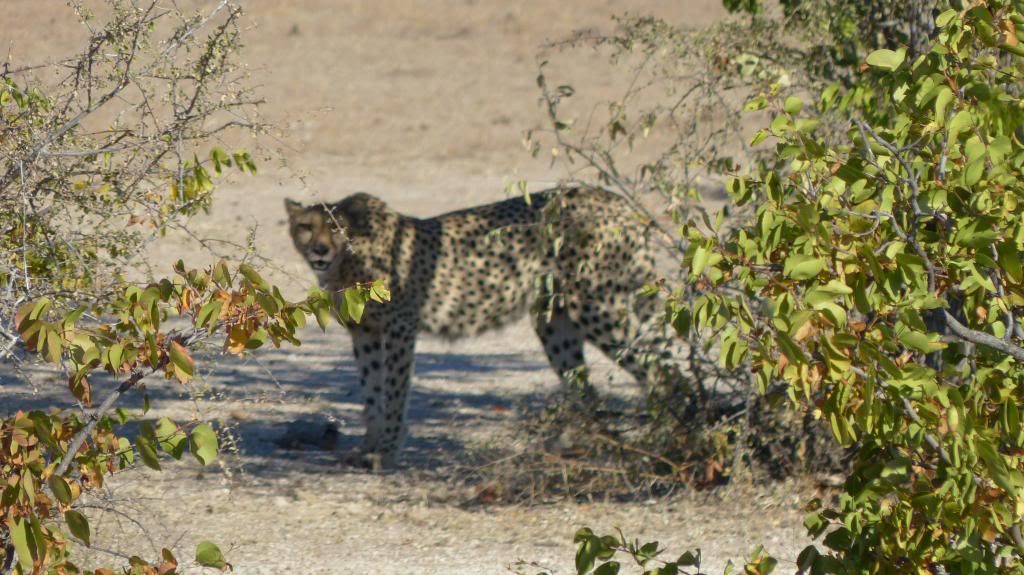 Later in the hunt, I learned a trick to zoom in on the target, and with the button depressed halfway, move off the target and back on, which seemed to tell the auto-focus where to concentrate. Like everything, there is a learning curve, including with the bridge cameras. Of note is that per the suggestions of friends on the forum, I saved all widescreen images in .jpg and .rw2 format, so at some point I could have somebody with the appropriate skills clean them up. The high-speed SanDisk “Extreme Pro” 95mbps memory card was very fast, and I never had to wait for the camera to catch up. We did not disturb the kill in the hopes that she would return, but it appeared to be an impala. 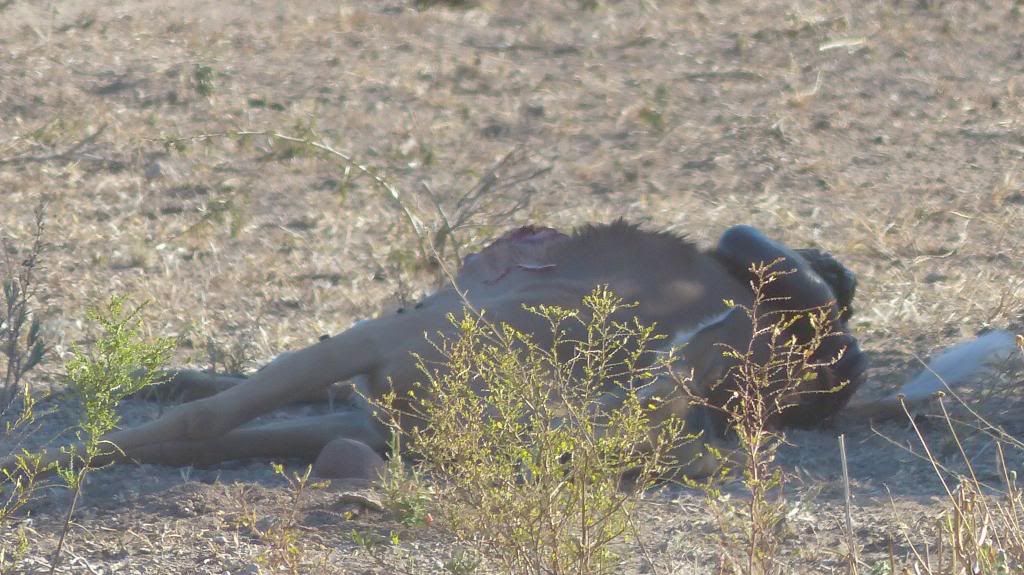 Like the rhino, lion and leopard, the cheetah is being studied in Zimbabwe and the folks at the Cheetah Conservation Project Zimbabwe were anxious for me to provide them with an image so that they could compare it to their known database. In email correspondence after the hunt, they said that using the spots on the rear hindquarter they were able to match this female. Cheetahs of Zimbabwe: http://cheetahzimbabwe.org/cheetahs-of-zimbabwe.html There was a lot of game concentrated in the south, including insane numbers of giraffe. At a $750 trophy fee (expect this to increase), they are arguably the “best buy” when it comes to game on the BVC. Obviously lots of guys feel the same way that I do and the TF needs to be low enough to encourage hunters to help manage their numbers. They also produce a lot of meat, which is managed very efficiently by the BVC and the excess sold off for profit. 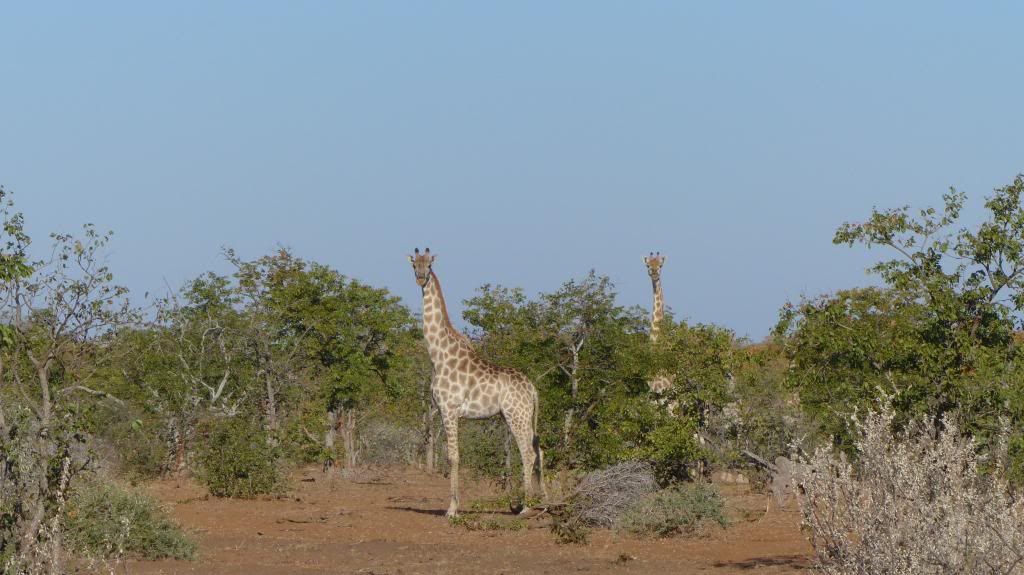 During the course of the hunt, I suggested that the BVC consider lowering the trophy fees for the commodity animals (zebra and wildebeest), or perhaps a “buy one get the second at half-price” type of offer. Despite Brett and I having a total of four of each species available, at TF’s of $950 and $800 each respectfully, I could not afford to shoot anywhere near this many. Apparently this was not the first time it has been suggested. However, as you will see later in the report, at a certain point perhaps it becomes more beneficial to capture and slaughter the animals in an organized, commercial fashion. 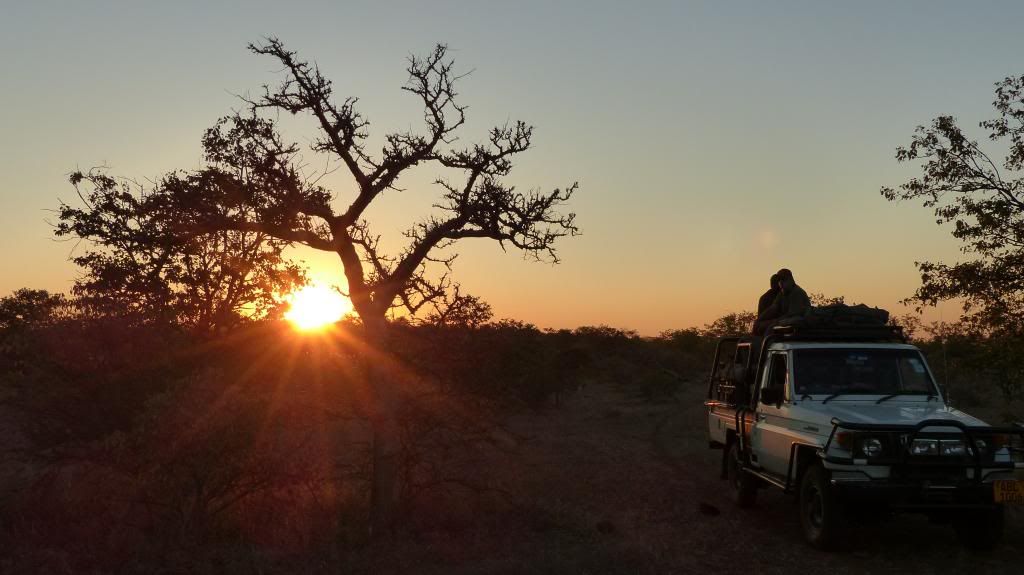 HUNT DAY #8 We drove the southern edge of the conservancy where we had seen the high concentrations of game the previous day, but came in from the opposite direction so that the wind would be in our favor. The impala were mating, and if you have never firsthand witnessed one roar, you would not believe such an ominous and intimidating sound could come out of a seemingly gentle and skittish creature. Preoccupied with mating (the impala that is!), Brett put on a stalk but was not able to get a clear shot before they scrambled off. Our goal was not a “trophy” ram, but a mature male that offered a good shot opportunity. Fortunately it was not long until another group of impala were spotted. Despite our desire to hunt them “on foot”, it was getting late in the hunt and doing the stalking ourselves was proving to be challenge enough. This time Brett went with Richard as the rest of us stayed behind and watched from the truck. Brett led and Rich helped direct him to the ram, avoiding the females, while staying downwind. They had disappeared into the bush for several minutes when we heard a single shot. The wait seemed like forever until they victoriously emerged from the bush, the impala slung over Richards shoulder. “Just an impala” you say…ha! 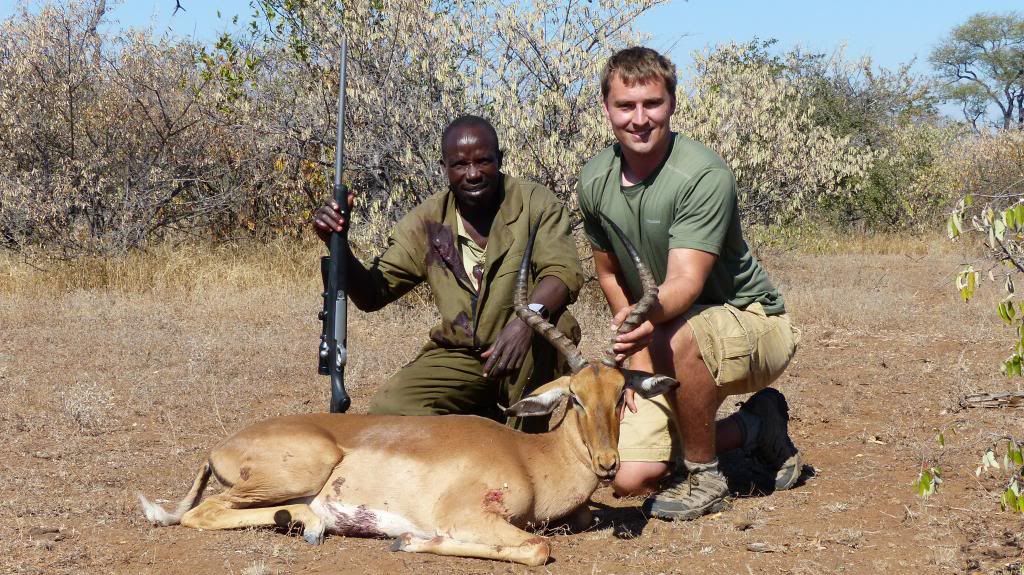 After gutting and loading the ram, we slowly made our way back to camp. A group of banded mongoose shot in front of the truck, and only turned to look back, in typical mongoose fashion, when they were a safe distance away. We really didn’t see that much small game, no honey badgers or porcupines (in fact despite many miles on foot I never saw any quills), and not too many of the small cats (genet, civet, caracal) other than wildcats at night. I do not want to blame the lions for everything, but with a current population of 300 to 350, they are near or at the carrying capacity of the area. Given what efficient killers they are, they must be having an impact on the small predators, in addition to cheetah, leopard and wild dog. Lion not only compete with other carnivores, they are not picky about what they eat and a trophy sable or kudu or warthog is probably just as tasty as a zebra or wildebeest. The reality is, if lion hunting is severely restricted in the future by the USFWS listing them as endangered, or an upgrade to CITES Appendix I, hunting will become undesirable or impossible for the majority of the BVC’s hunters. At this point, the ownership of the BVC would have no choice but to eradicate most or all of the lion. Lion will remain on the BVC as long as financially viable to the shareholders. If hunting continues, numbers can be controlled via adequate take-off of males and females, and there will be a source population of wild lion available for restocking other areas in Zimbabwe. On the road back to camp, Yobane and I simultaneously spotted a group of eland bulls, and whistled Ade to stop. Glassing the bulls as they moved off, there appeared to be four in the group, at least two of which were shooters. The decision was made that as they were now trotting, we would leave them. I was fine with this, as ideally we would walk down our eland working just from tracks. We returned to camp to drop off the impala, and have a bite to eat (wildebeest meatballs, yum!). By 2:15, working from the water point closest to where we had spotted them, we were on their tracks, which were easy to follow in the soft ground. 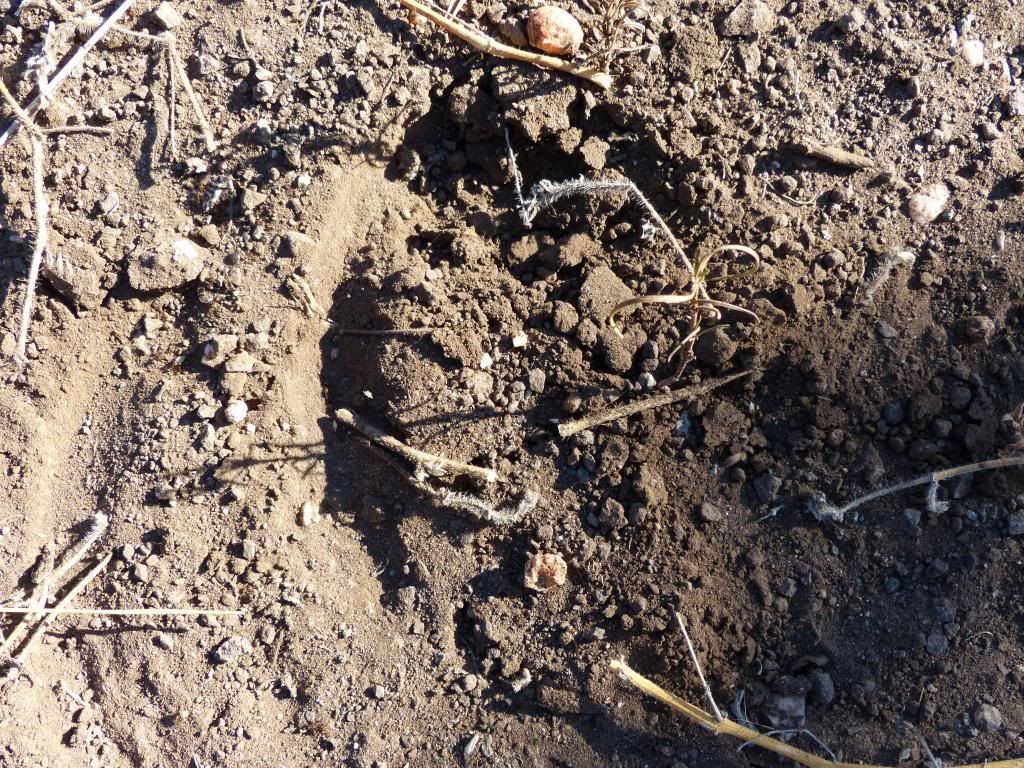 After drinking they appeared to have rested, and may have heard our vehicle approach as the tracks indicated they were again trotting. Eventually they slowed and walked single-file into the sun, which was still high in the sky. Once spooked, eland are very difficult, if not impossible, to walk-down. We were not far behind given the spoor, but like the previous bulls, they were clever and several times we found where they stopped at the far edge of a clearing and turned sideways to look back. 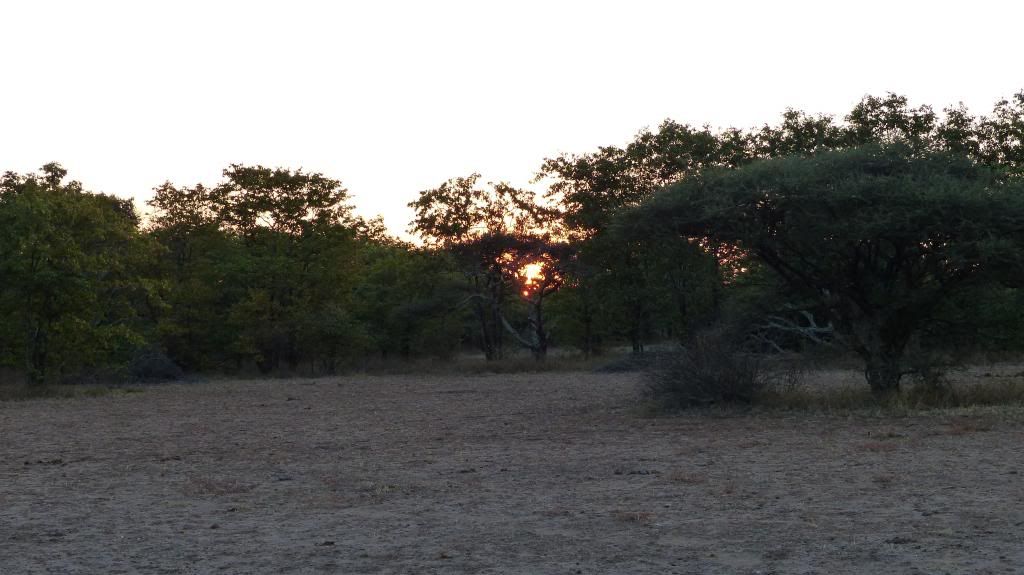 We inevitably bumped them a second time, at which point we took a break of ~ 10 minutes to allow them time to hopefully settle. 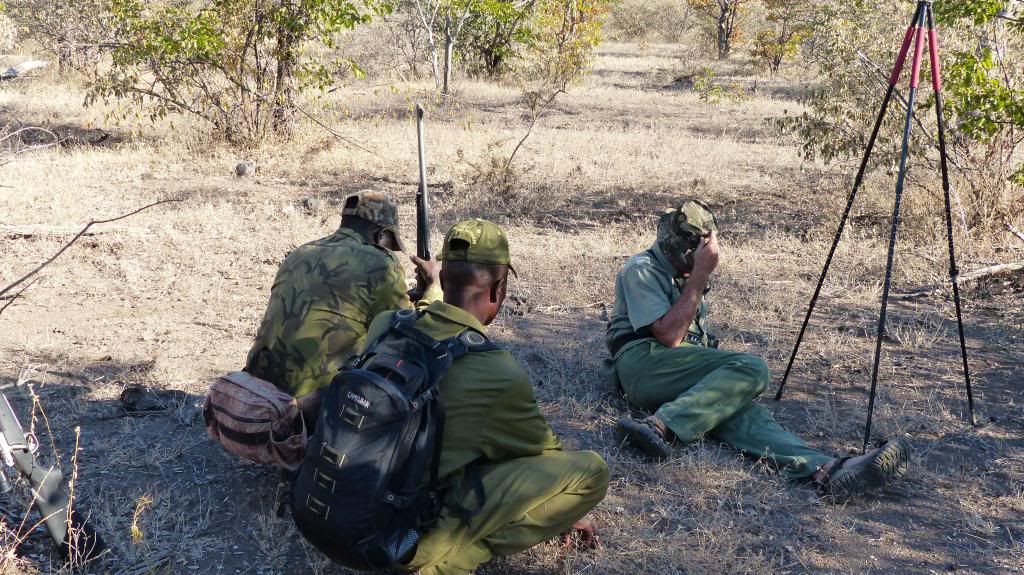 After more walking, Richard made a fantastic spot, locating the eland feeding in some thick bush about 150 yards ahead. They had not seen us first this time, which gave us the opportunity to put on a stalk keeping the cover and wind to our advantage. 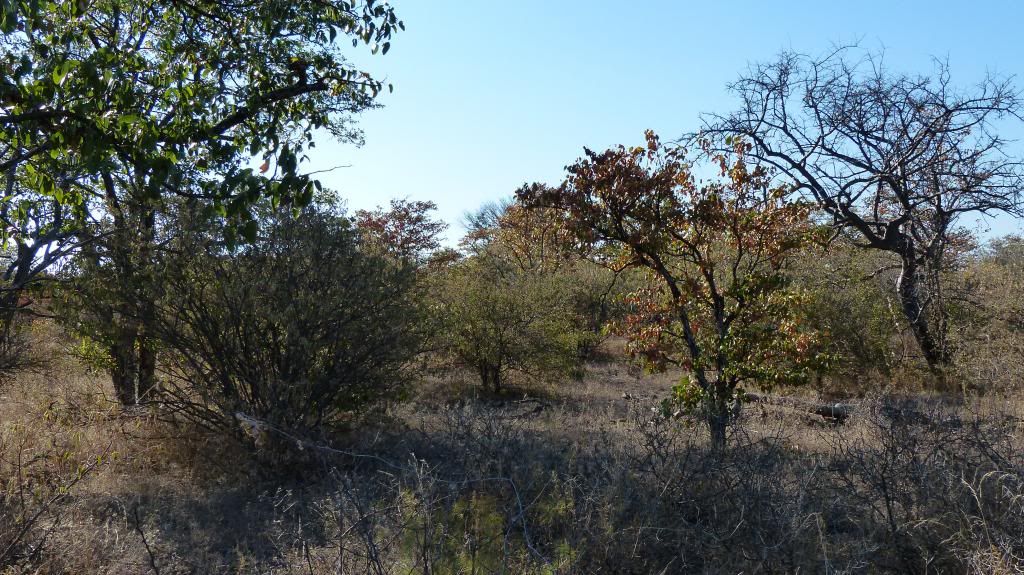 While we worked out our final approach, the wind changed direction, and blew hard at our backs and towards the eland now 125 yards away. We just looked at each other in disbelief. To me it just seemed too coincidental, and I wondered what fate had in store for us. Quickly we moved to our right and worked our way to where they had been feeding, but as expected, they were gone and once again on a trot. We followed at a brisk pace into the setting sun. They did not stop, and crossing a main dirt track at sunset, we called it off. In total we covered about 8 miles in 3 hours, which is not bad considering the breaks to allow the eland to settle and that an average tracking speed is around 2.5 miles per hour. A few minutes after arriving at camp, a lion began calling from behind the far chalet, and continued as we showered. Dinner was announced by a single beat on the drum, followed by a a somewhat awkward presentation of the menu by the waiter, who was trying hard. The food at Ngali was okay, but was more “old Zimbabwe” in that the meat (including chicken twice in 6 days) was cooked hard and the menu fairly basic. As it turned out, I learned that the cook who was to be at the camp was unable it make it for unknown reasons, and the gentlemen doing the cooking was a bit more basic in his approach. It was fine, and a few years ago was the norm in most Zimbabwe hunting camps, it just goes to show how far the country has come in the last few years. HUNT DAY #9 Picking up the spoor of the eland from the day before, we followed them from the dirt track towards the southern boundary of the conservancy, which was only a few kilometers away. Once we crossed the dry Mazunga River, close to where we had taken lunch two days prior, I knew that the perimeter fence would be close. At the fence, the four bulls split up into two groups. We followed one of the groups for a few minutes before making the correct decision to give up. The spoor was 9 hours old, and the fence obviously impacted their natural behavior. The area was again dense with zebra, wildebeest and giraffe including some big old stink bulls in one herd that had to contain 20-30 mature animals. Other sightings included a group of waterbuck cows and a few baboons, and a small group of monkey. I was becoming keenly aware of the fact that given the lack of kudu sightings, the odds of connecting on two 50+ inch bulls was quite slim. As the focus of this hunt was not in collecting trophies, I was fine with this. We still had eland to hunt, and as we were seeing signs, it felt like just a matter of time. The impala were still in full rut. Approaching the fleeing herd in the truck, we noticed a ram lying on the ground not moving. He had been killed minutes ago while fighting, taking a horn to the jugular. 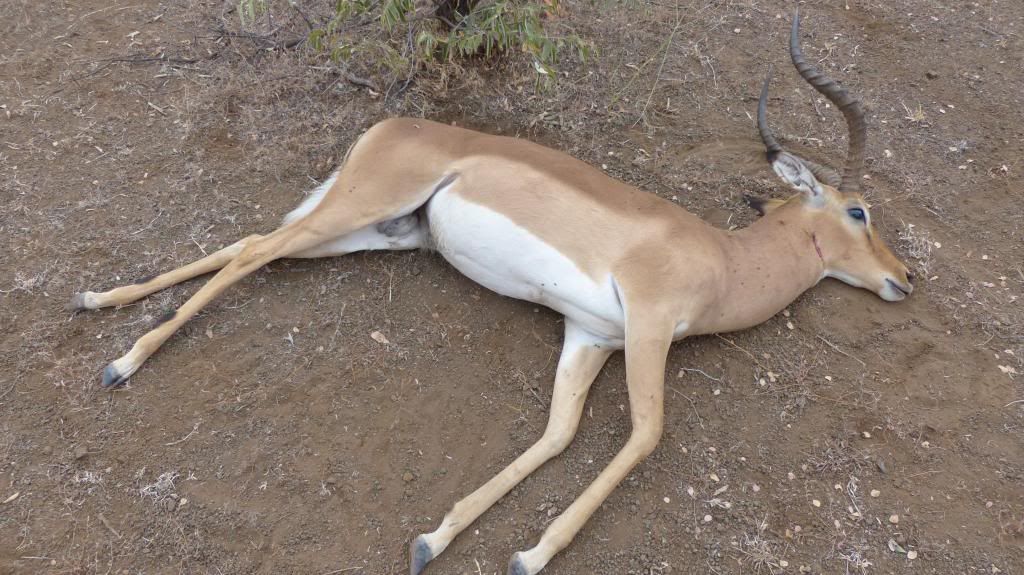 We stopped the truck to glass a warthog standing in the dirt track a few hundred yards ahead. Not a large hog, he appeared to be mature, so we set off on foot to try to track him down. The trackers did a great job following his spoor, which ended at his den. The team was clicking, and seemed sharper than earlier in the hunt. 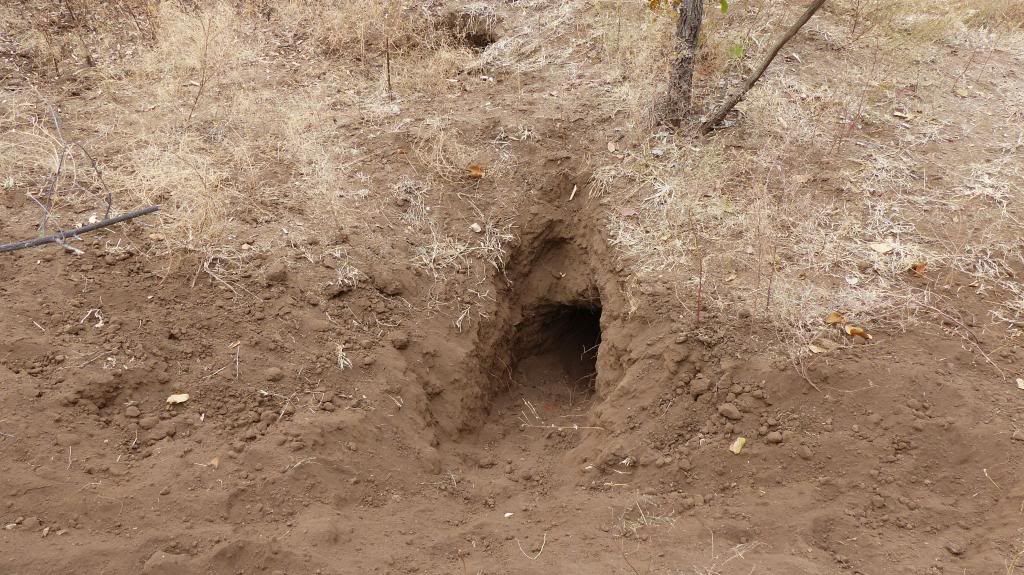 With two days left, we decided it was time to get serious about a blue wildebeest for Brett. Two bulls offered a good target of opportunity. Brett and I began making our way towards the bulls, who were fighting over territory and mostly preoccupied, although the wind was blowing strong which tends to put game on edge. Lovemore worked his way up to our position when I lost sight of the older bull as they had changed positions, and provided some direction. With the sticks in hand, I zigzagged my way towards the bulls. A clump of acacia was the last available cover, approximately 75 yards away from the wildebeest. The older bull knew something was up, and snorted a few times in our general direction. After a 5 minute stare down, he turned his head to look at the younger bull, which gave us the opportunity to move to the left of the acacia. I setup the sticks for Brett to place the .300, and quickly moved back, fingers in my ears. A few minutes earlier Brett and I talked about bullet placement on what was likely going to be a frontal shot. The bull was hit hard, and when attempting to run it was clear that his left shoulder was broken. The guys assisted tracking the bull, which was easy given the blood trail. Thanks in part to following the younger bull, he had managed to get about 200 yards into the bush, where to my astonishment, stood a herd of eland cows and several giraffe. Propped up by a mopane, the wildebeest was broadside to us, and Brett made a superb ~125 yard finishing shot.    We dropped the impala and wildebeest off at the skinning shed, and ate our pack lunch at camp. Around 2:30 we set off in search of eland. We were beginning to see lion now, and a young male and female provided a nice photo opportunity. Note the recent wound to the female in the pictures below.  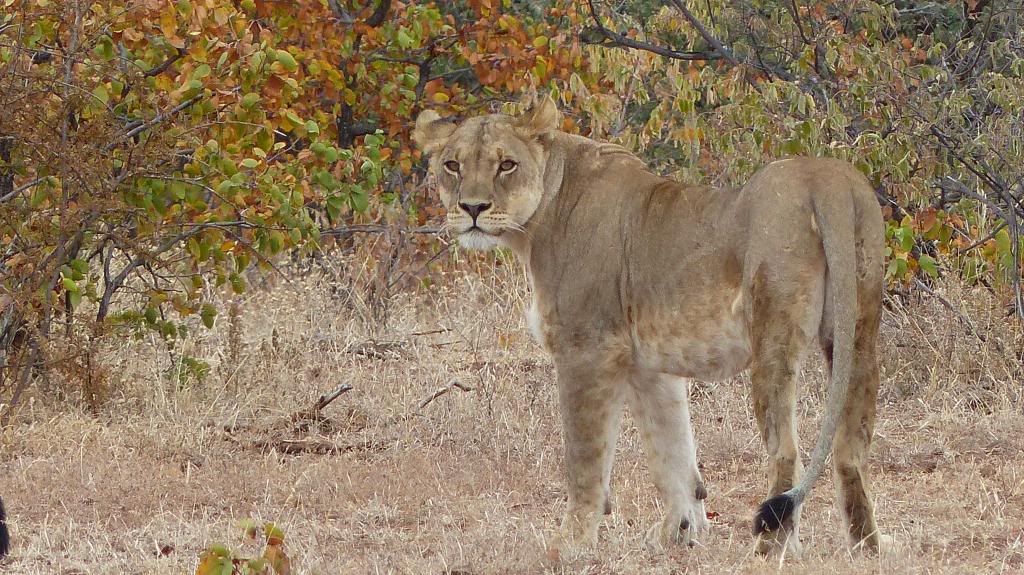 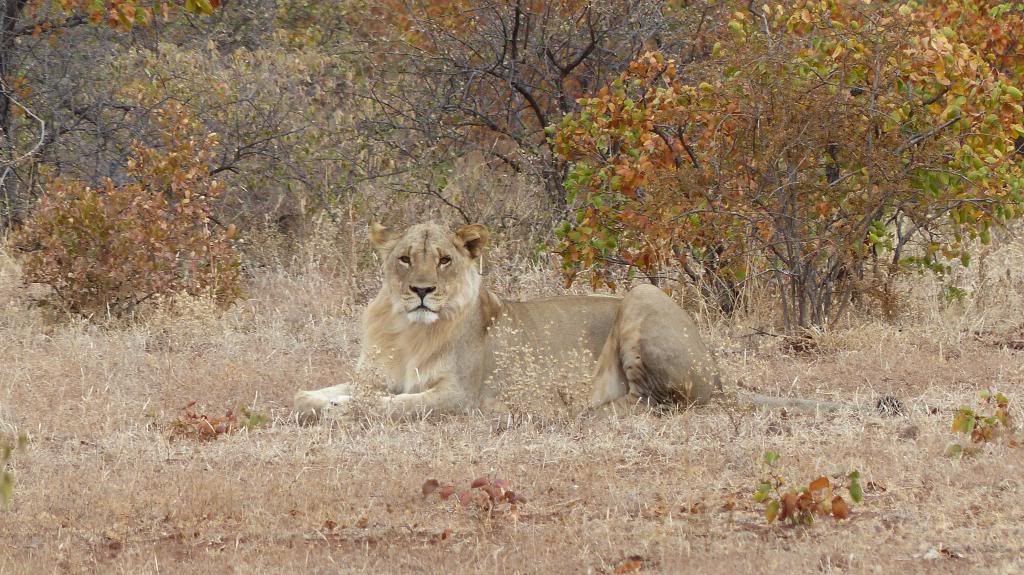 While not a huge bow hunting destination, there are blinds that are available…used by bird hunters too apparently. 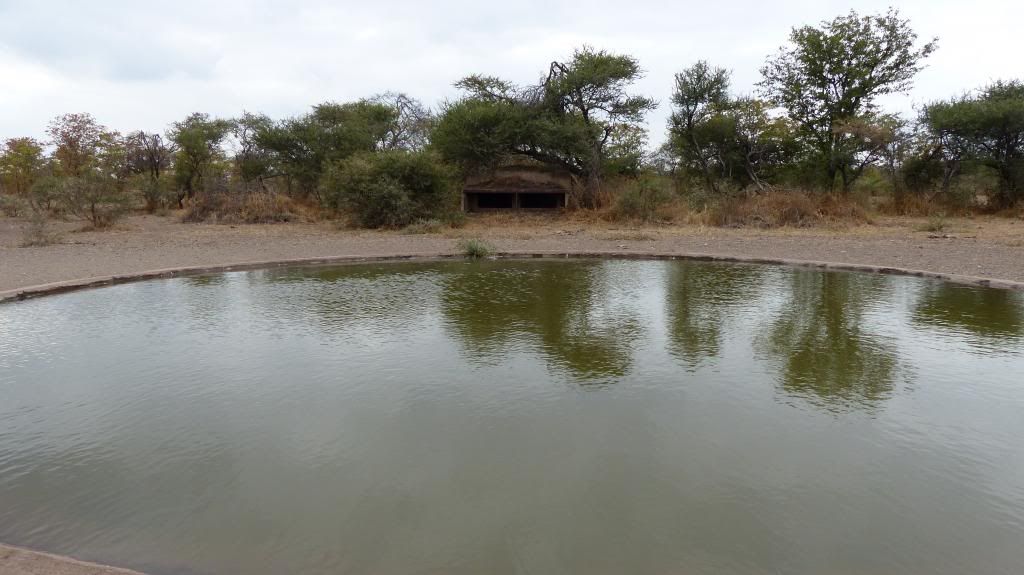  Working our way back to camp, we broke out the Remington pump action 12 gauge and shot a few guinea fowl for the pot. Brett is a natural with the shotgun, and did better than I on the fast flying birds. At dusk, we drove to the top of a hill where a Scout camp was located to ask the guys if they had any intel on recent eland movement. They told us that earlier in the day they had seen 4-5 bulls, and that they regularly drink from a water hole that we had not yet checked. Now dark, we stopped to check out a pride of lion, until their curiosity or bad intentions brought them a bit too close for comfort. A short while later we were treated to a sighting of a female rhino and her small calf. I am not sure if it was a black or white as her mouth was partly obscured by some brush, but she looked like a black rhino. Dinner was a nice kudu meat pie with peas and carrots, and a banana banoffee for desert. HUNT DAY #10 As is not unusual for me, we were now down to the wire with only two hunting days remaining. Breakfast was our standard oatmeal, cheese/meat, and yoghurt. The team was waiting for us at the truck, and by 6:15 we were on the trail in search of kudu and eland. Despite being near to the end of the mating season, the impala were rutting hard. 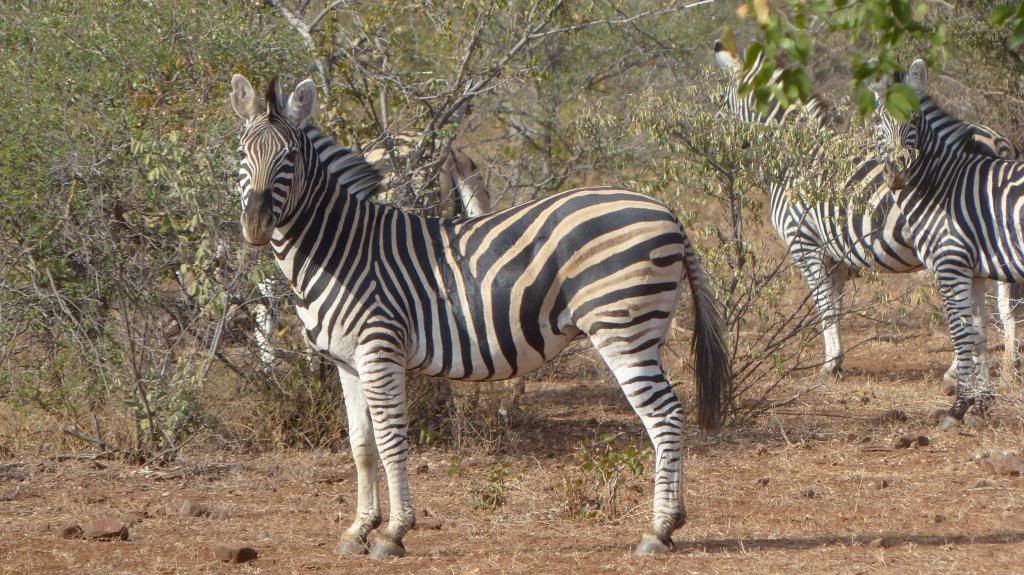 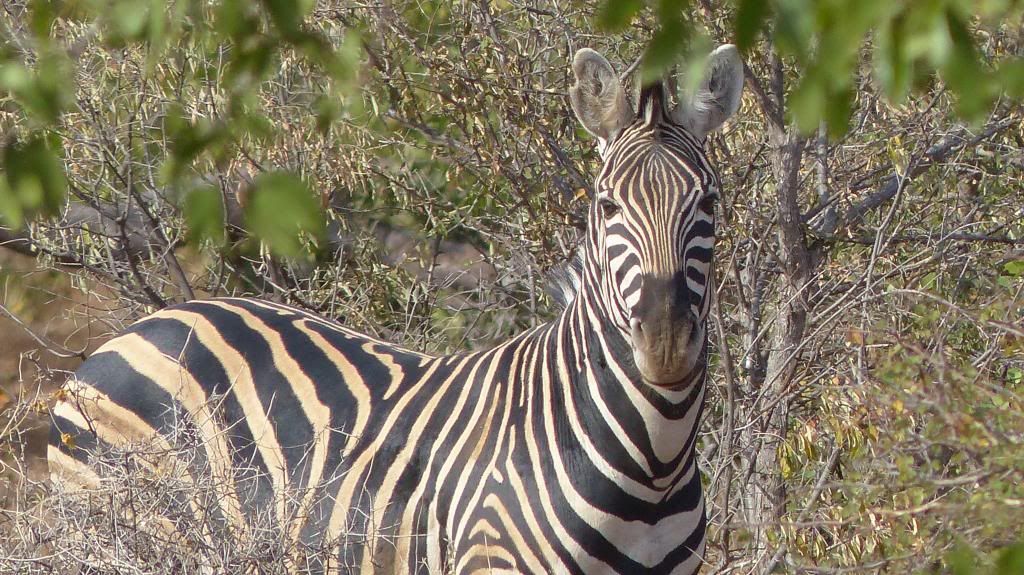 We walked a scenic dry river bed which was full of tracks including some very fresh rhino. This was a little bit unnerving, as I am not sure that I could outmaneuver a rhino in full charge (although with Brett along my plan was to make myself the target), and pretty sure that I could not scurry up a tree, and would not want to be the guy who shoots one of the BVC’s prized animals. Ade said the best course of action was to let the rhino toss me and hope for the best. He was joking, I think. The riverine bush gave way to thick mopane trees, and the sound of breaking branches, which I immediately assumed were elephant. I felt strangely at home, until a big giraffe bull poked his head over top of one of the trees! Further down the game trail, we began to lose focus a bit and started quietly chatting about a bush or some such thing. Richard and Lovemore’s eyes grew big as they urged us forward. A large warthog was heading straight for us. Ade quickly threw up the sticks and Brett, who was carrying the .300, quickly got set up and fired. I heard the bullet impact, and the pig squealing. The shot was true and we found him a short distance away. It was the perfect walk-and-stalk hunt, covering about 8 kilometers in the cool of the early morning. 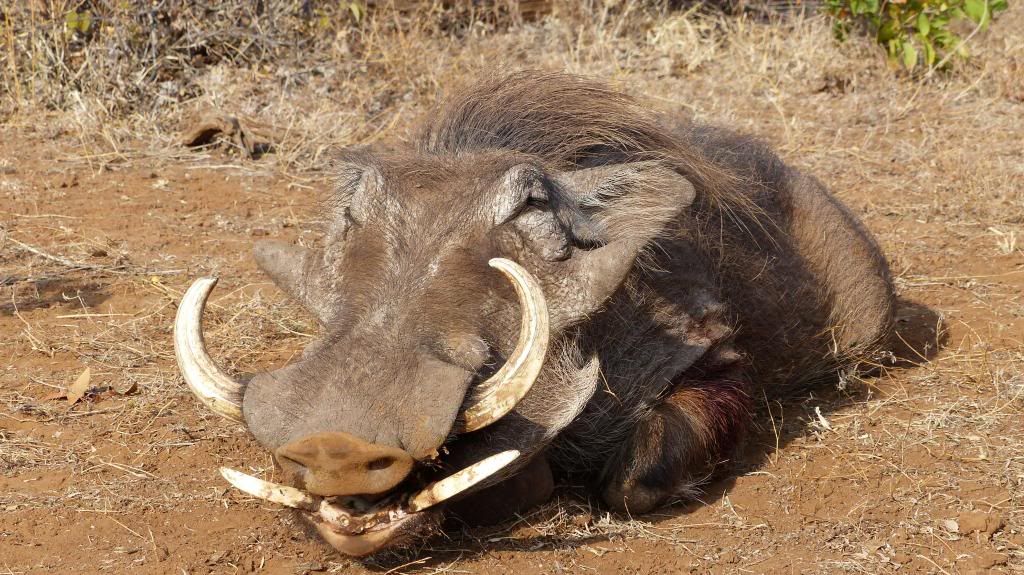 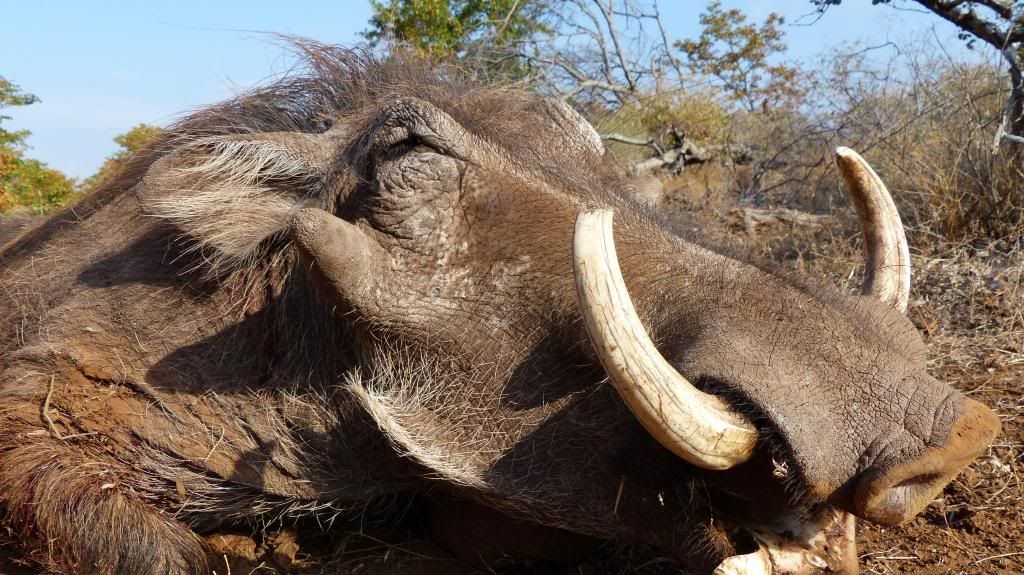 We dropped the pig and Yobane off at camp for skinning. Still quite early, we drove to the area beneath the Scout camp where they have been seeing eland. There was quite a bit of game in and around the waterhole, and it took time to work our way in without clearing the area. The bush was nice and thick, and provided us with good cover. At the water hole, the guys found fresh eland spoor. Given the lack of other tracks on top, they had very recently drunk. Progress was slow as we had to weave around multiple groups of zebra and rutting impala. The tracks led to a patch of very thick cover, the likes of which I had not yet seen on this hunt. We were able to get glimpses of the eland, but did not want to be too aggressive and push them out. In addition to the bulls, there were some cows, which made things interesting as they were very alert. At times we would see patches of eland, but it was impossible to tell if it was a mature bull, one of the younger ones, or a cow. After some further maneuvering, we were face to face with a big old bull. The sun was to our backs, and the wind good. I got on the sticks, but through the bush I was unable to tell where his body was, and my only shot would have been to try to brain him as the top half of his head was visible. I was not comfortable with this and waited for him to hopefully move and expose a shoulder. Uncertain what we were, the bull ran downwind of us. When he got our scent, he bolted and took the other bulls with him. I knew the guys were disappointed and wanted me to shoot, but I have a feeling that the outcome would not have been good. Thus began the longest march of the trip. Instinctively we all knew that it was going to be a long day, and fortunately I was in the habit of making sure that whenever we left the truck we carried an ample supply of water, including extra bottles in my extra backpack carried by one of the guys. We followed the tracks through the valley, and up and over the hill where the Scout camp was located. The terrain was rocky and the descent down the other side took some time as I struggled for footing. The area opened up to a rather desolate landscape, although we were able to cover ground quickly. The sun was high in the sky and the temperature on the ground was hot. We slowed upon reaching thicker areas anticipating that the eland had stopped to feed and rest. Upon entering one of these areas, Ade caught my eye and I whispered “This ain’t over”. I was enjoying myself, and for whatever reason, had a really good feeling about what the outcome was going to be. We were either going to shoot an eland, or be proud of the effort put forth. We navigated our way around a group of wildebeest, and resumed tracking. They were headed in the direction of a dry riverbed where Lovemore thought they might stop to feed. We grew anxious as the silhouetted line of trees grew closer. Carefully moving forward as we glassed, there was no sign of the bulls. I could tell the team was disheartened and as we cleared the trees on the other side, I stopped the march to drink the last of our water. I always carry in the backpack a small Ziploc of Jolly Ranchers for just such a situation. During the course of the hunt, the guys repeatedly said, what sounded to me as, “myvaghina”. I knew of course this was not it, but it offered a perfect opportunity for some much needed levity. It turns out what they were saying was “kachana” which means “far”. Richard especially got quite a kick out of this, as did the others when in their language he told them what it was that I thought they were saying. Savoring the last of the candies, we continued on, much lighter in step. We had pretty much resigned ourselves to the fact that we were now walking out of principle, and would do so until dusk, which was maybe an hour and a half away. In any event, we were moving in the direction of the closest road. It all happened fast. I am not sure who spotted him first, Richard or Lovemore, but 150 yards in front of us, standing next to some brush and directly facing us, was an eland. Ade immediately threw up the sticks and I exchanged the Lott for the .300. I had a great sight picture, a rock solid hold on the rifle, and quickly the crosshairs settled on his neck. At the shot, the bull disappeared from view. Richard began jumping and down saying that the bull dropped and was dead. Just as we were beginning the celebration, Lovemore got our attention and said that another bull had just stepped out from behind some cover and was walking parallel and in front of us. I gave Brett the .300, which already had another round in the chamber with the safety on, and grabbed the sticks. We ran forward to where we were able to intersect the bull. Brett was quickly in a shooting position and made a good hit into the chest area. Eland are big, and he took a few more rounds before finally succumbing, including a Hail Mary from my open-sighted Lott at more yards than I care to admit, that only succeeded in opening his hide up a bit. We were over the moon! It had not only worked out, it worked out perfectly. We had ourselves father-son eland, on day 10 of an 11 day hunt, after many miles of hard walking. And multiple failed attempts. Now it was a race against time to get the bulls’ setup for pictures, as they were separated by about 200 yards. Paul was radioed to bring the truck around, as we prepared the area by Brett’s eland for pictures. When the Cruiser arrived, the guys tied my bull to the back and dragged him to where Brett’s had fallen. 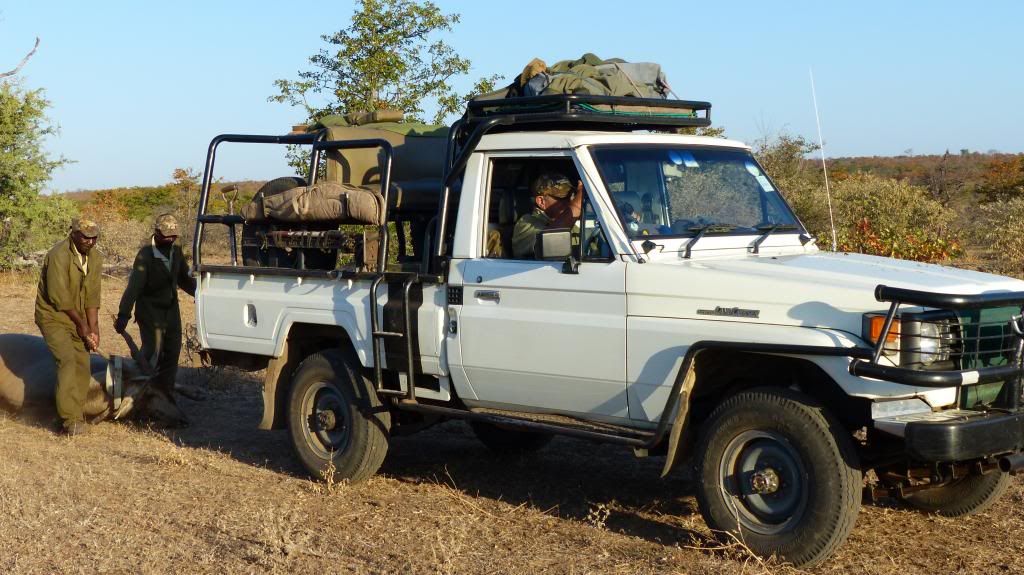 Brett’s bull was the older of the two and the big guy who I had lined up earlier in the thick bush. Although I am not mounting these bulls, nothing from them was wasted. I was only disappointed that we would not get to enjoy some fresh eland steaks! 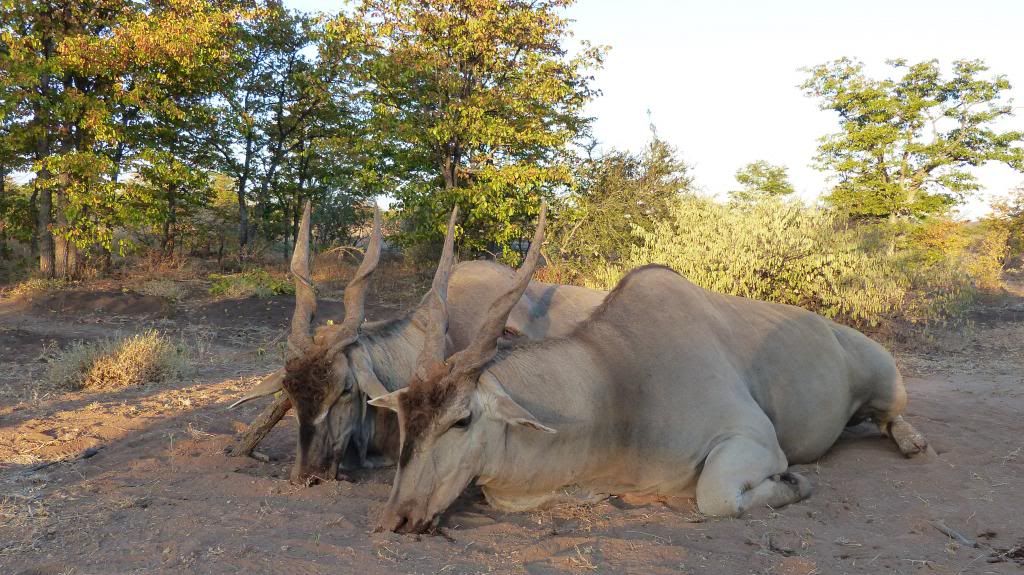 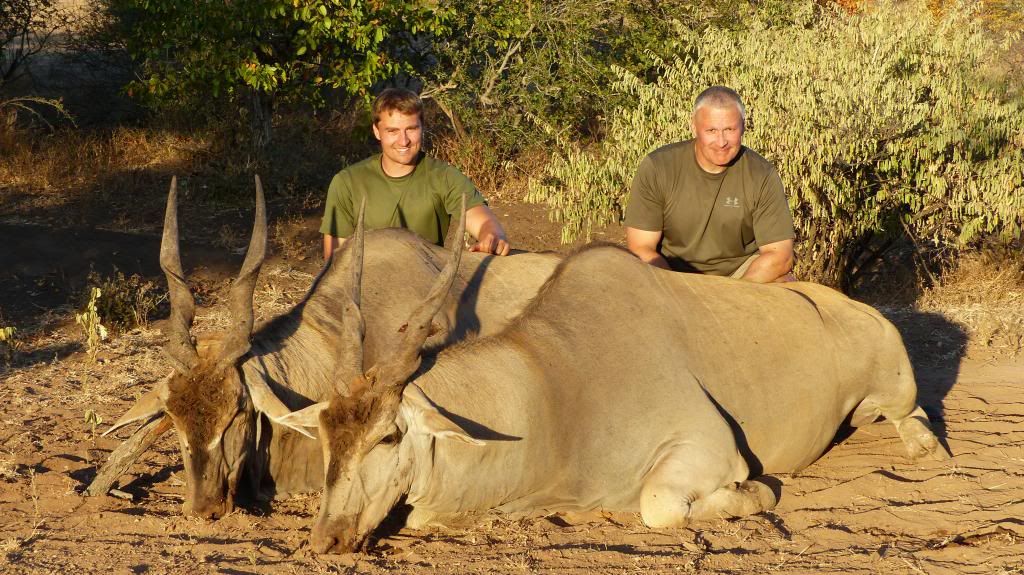  As it turned out, we had more than enough time. 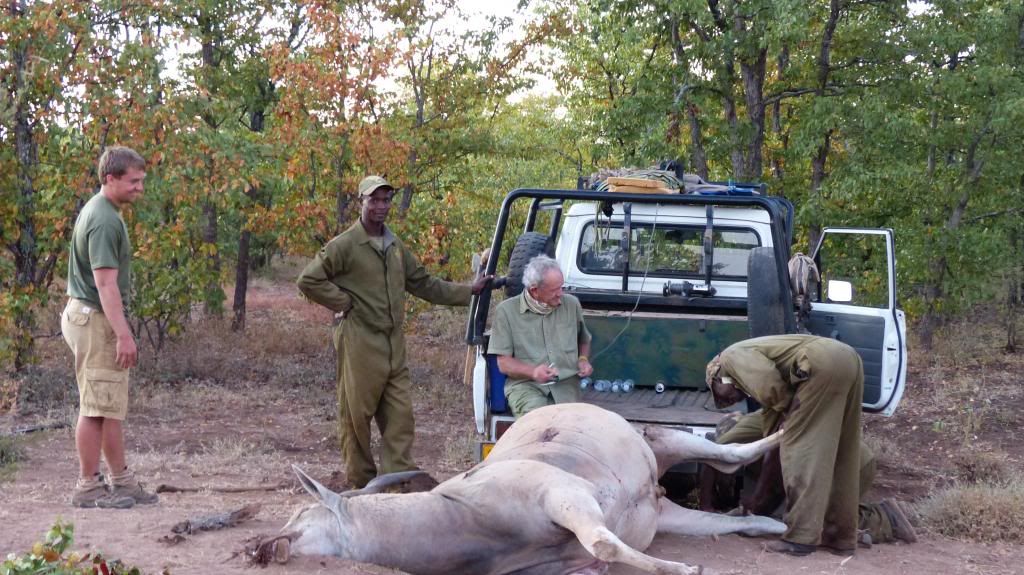 So many things could have changed the outcome of this hunt, we could have: - arrived 10 minutes before the eland drank - attempted a desperate shot and ended up with a wounded eland bull - called it quits and radioed for the truck - blundered into the bulls on what was our final approach - had to shoot the first bull multiple times thereby not allowing an opportunity at the second Skill, luck, fate...I don't know - it is just great when everything comes together! | |||
|
| one of us |
HUNT DAY #11 Instead of a lot of driving in search of kudu, Brett and I wanted to spend the day fishing and bird shooting. We went to the main BVC camp to see if there was a boat and motor that we could use to fish the bass lake in the northern part of the conservancy. Headquarters was a bee hive of activity noting that there are a lot of people who work behind the scenes in administration, personnel, anti-poaching and game management. I can’t imagine what the running costs of the BVC are, but the figure must be staggering. Everybody I encountered was friendly, including the children who stay on the premises with their parents. 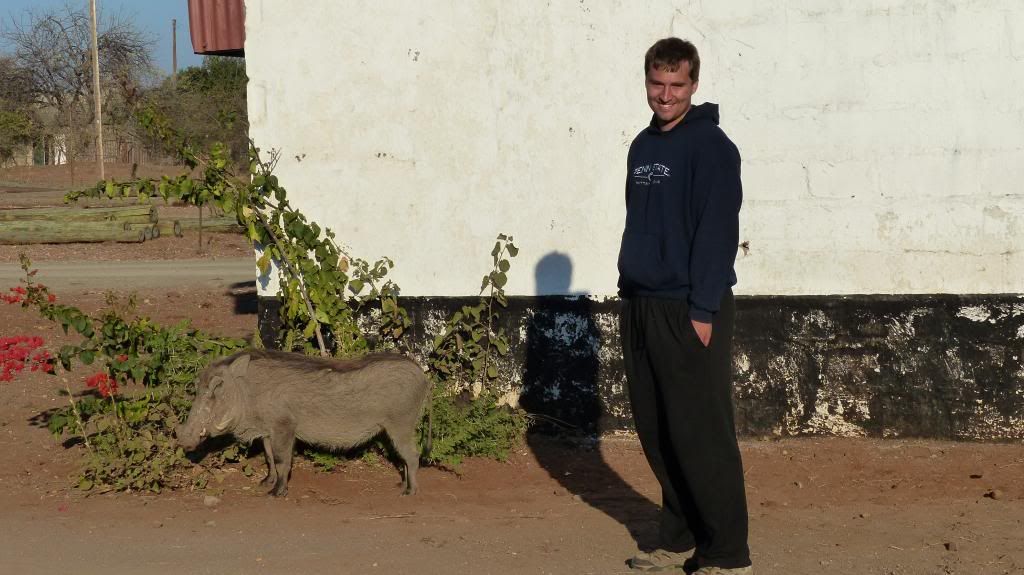 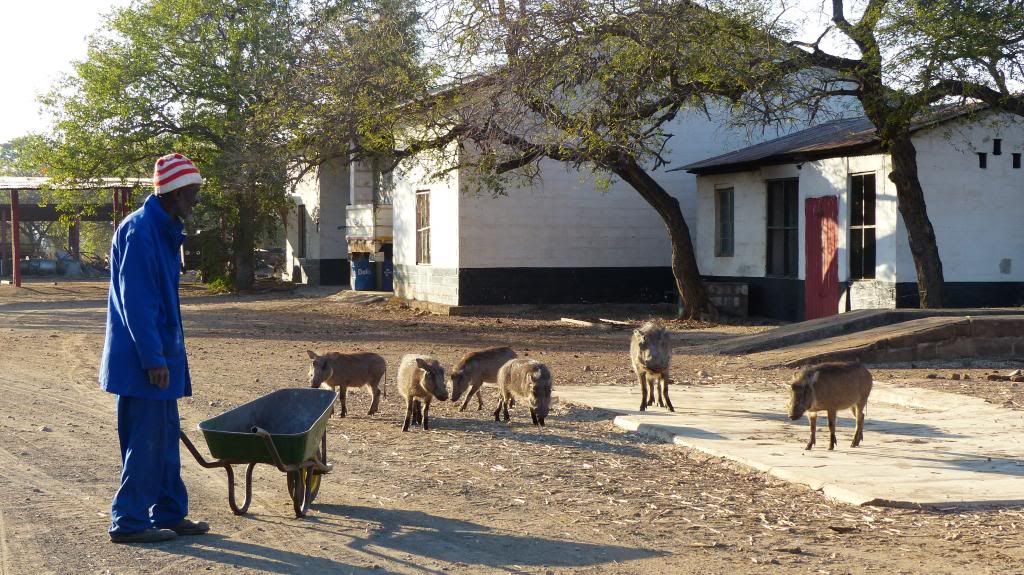 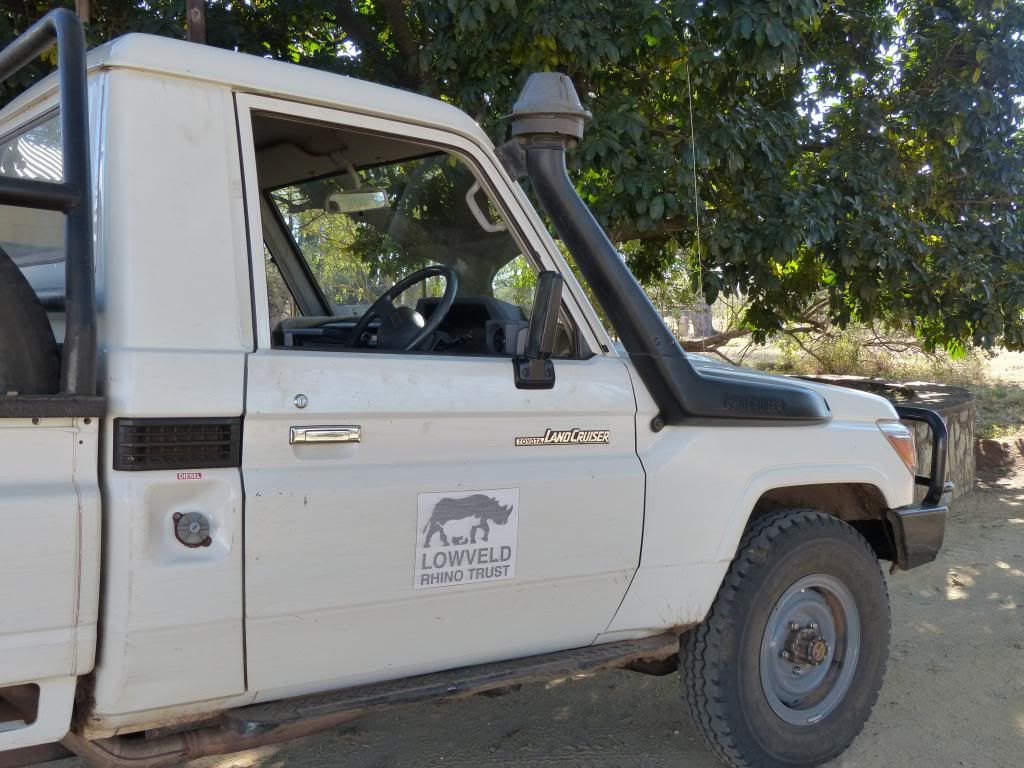 As has been stated previously in the report, the BVC is a for-profit business venture. It exists because the shareholders are able to turn a profit. As such, the replenishable resources of the BVC are used in whatever possible, and this includes resale of pick-up skulls from the bush, giraffe leg bones for carvings, and meat from culled animals. A few of the pick-ups were awesome, including a huge sable, an old worn-down eland, and a massively-bossed buffalo. 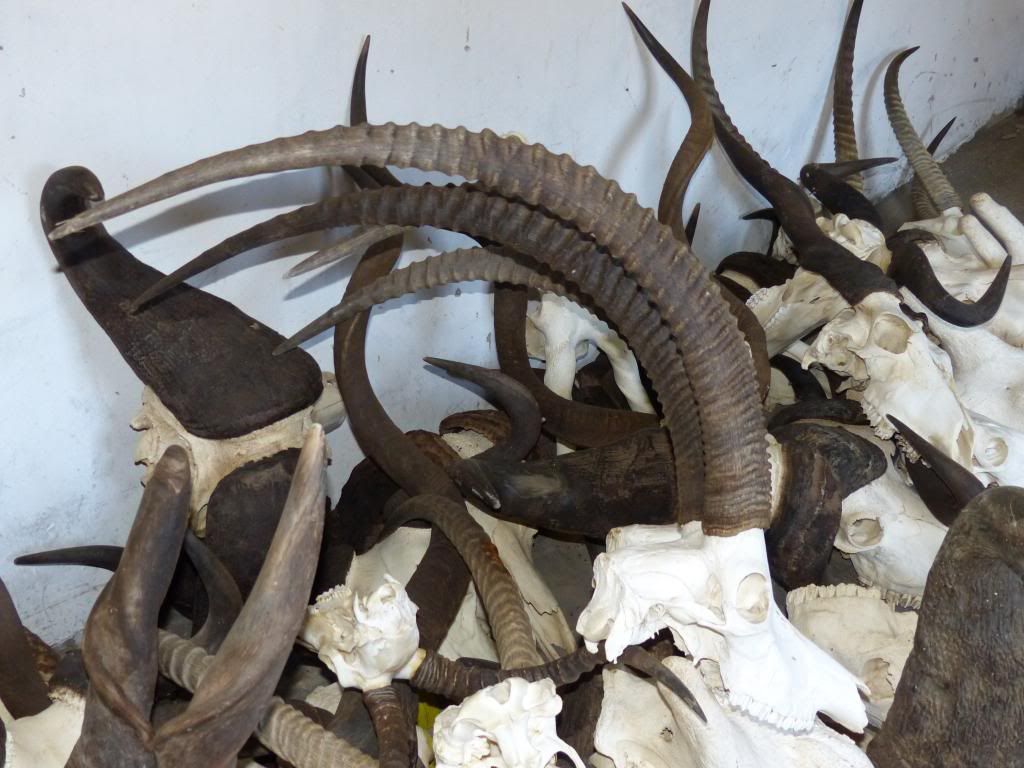 We visited the butchery, where they were processing a herd of zebra that had been captured and slaughtered. The meat would be sold to the local people, and the hides to the curio market. The scene was very reminiscent of the processing center in the Tussen die Riviere Nature Reserve in South Africa when Brett and I hunted there in 2001, except they had just culled a large number of eland. Or, the crocodile farm along Lake Kariba. 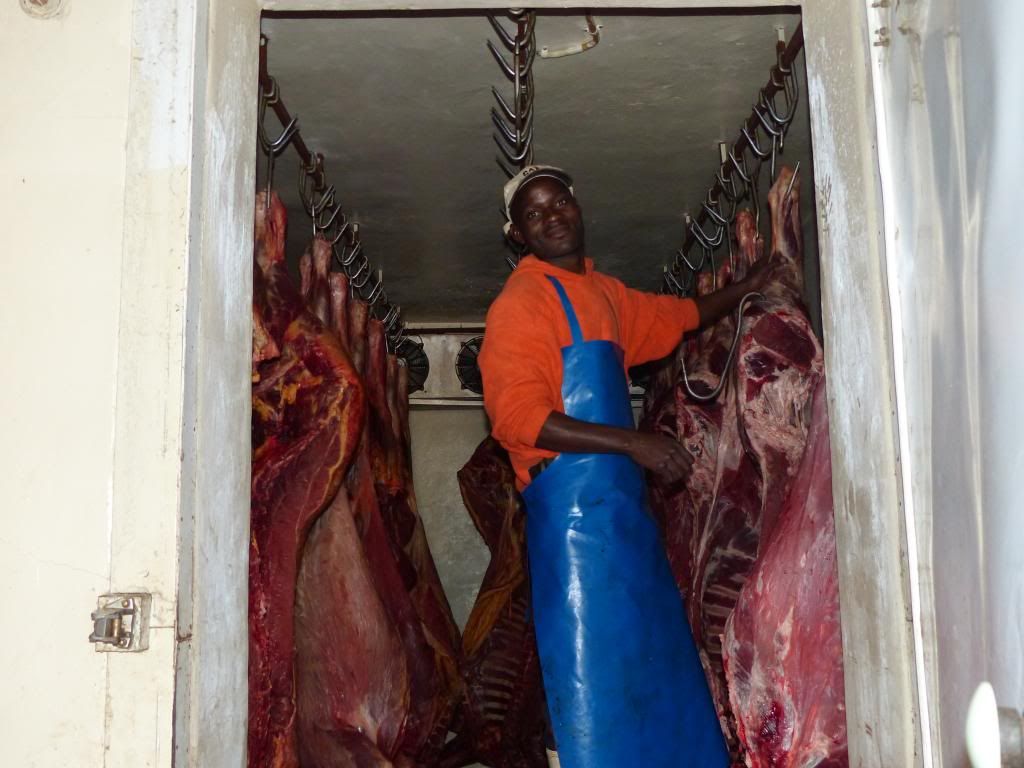 While we were waiting on the status of the boat, a helicopter landed followed shortly by the arrival of a truck full of recently captured wildebeest. The basic process, as it was told to me, is to use the helicopter to herd the animals into an enclosure setup in the bush. Once inside, the gate is closed, and they are pushed into the back of the trailer. A Ruger .22 Mag semi-automatic was used to dispatch the animals in as humane a way as possible.  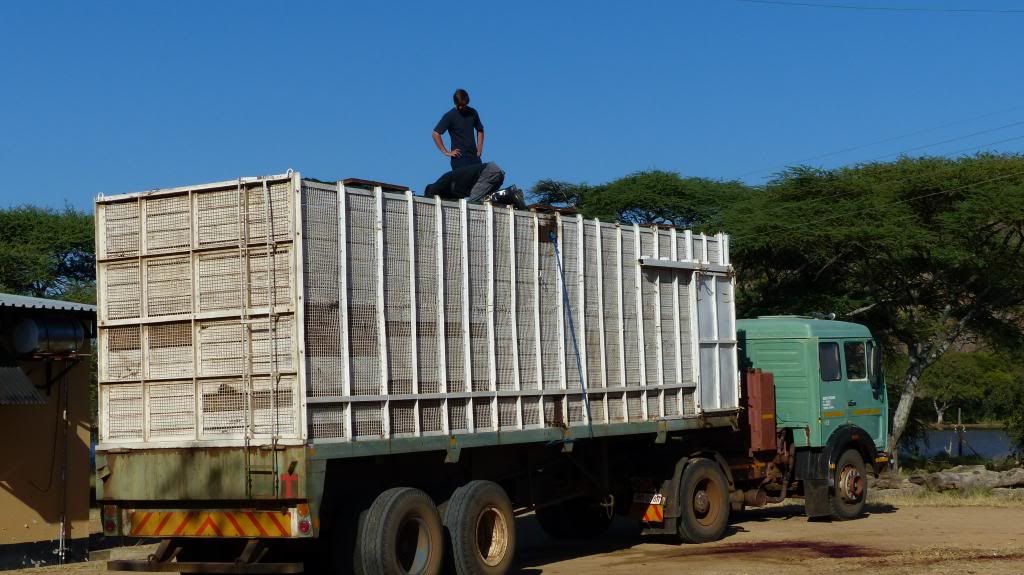 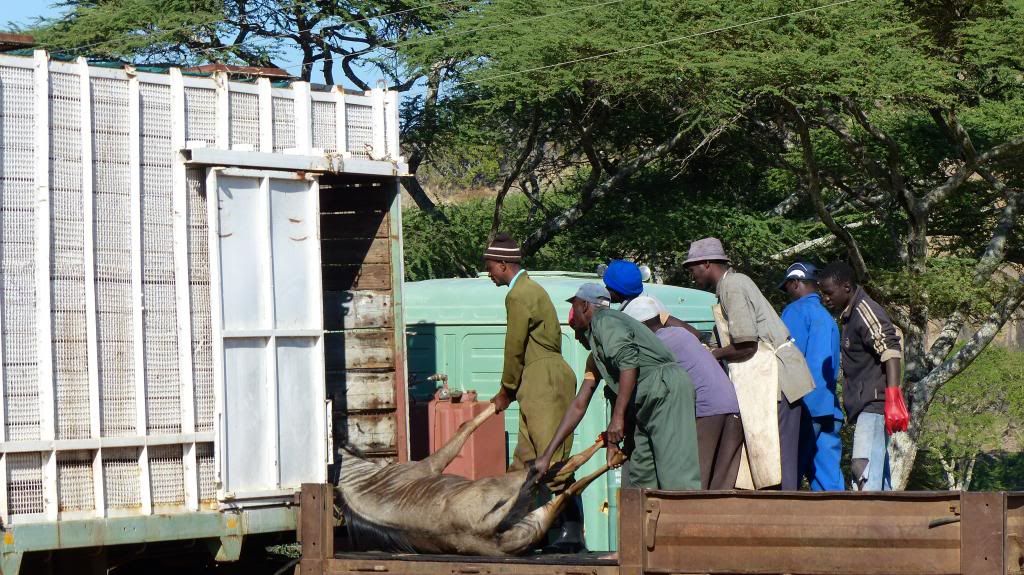 There was no boat available, so instead we decided to go to a river dam that was still holding water, and reportedly a concentrated number of brim (tilapia). Fishing was fun, and Brett and I each caught 20-25 fish. Of course we bickered over who caught the most, who had the biggest and which one of us was the better brim fisherman. Ade and the guys also had a good time, and in all honesty the best fisherman was Lovemore! 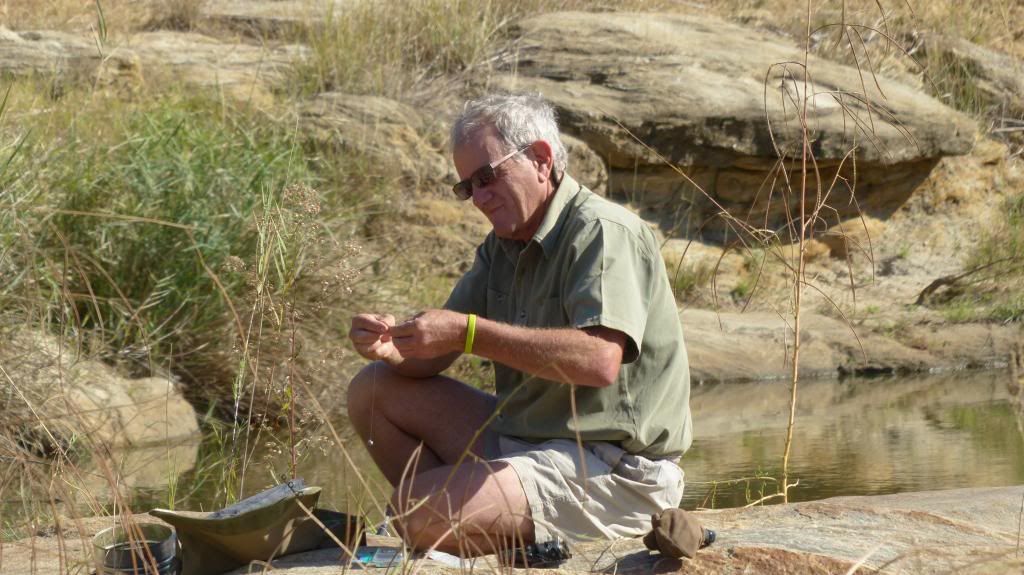 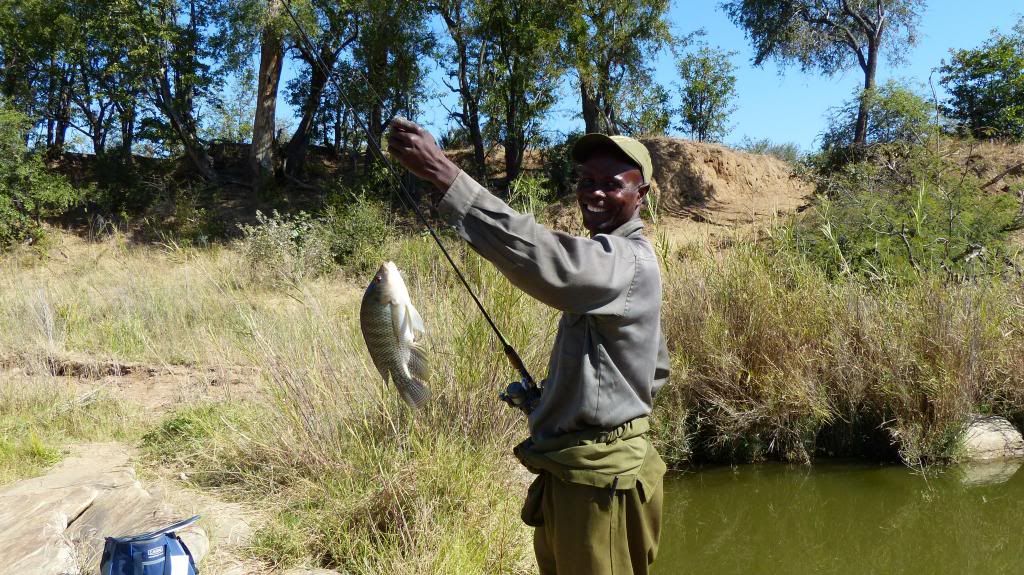  Lunch was filets from the impala that Brett shot with sadza. 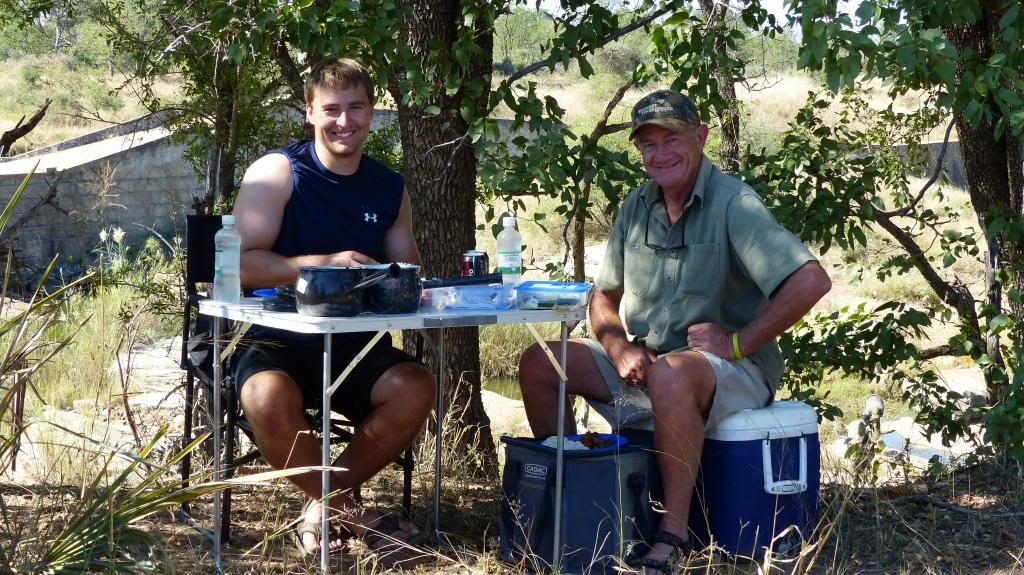 We drove back to Ngali to drop off the fish, and then went bird shooting. After a few more guinea fowl and franklin, Ade worked with Brett to shoot doves as they came into water. I have hunted duck and geese, but never did any of the high-volume wing shooting. It looked like tremendous fun, and more sporting than plugging guinea fowl off the back of the truck. Perhaps if/when there is a next time, there will be more opportunity for some proper bird shooting.  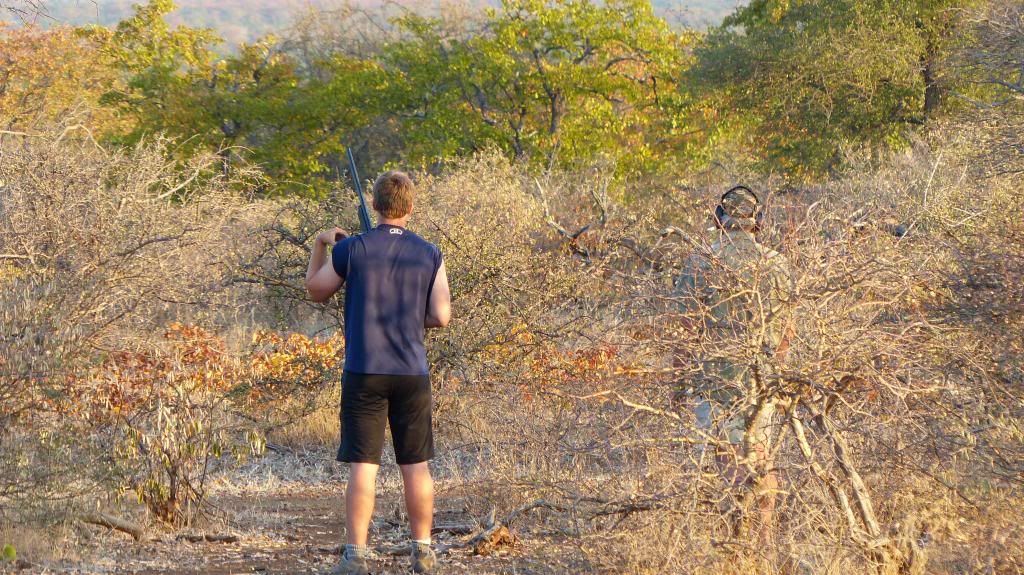 STAFF TIP SUMMARY I am providing the following for general reference, as if you are like me, you struggle with this aspect of the hunt. It is hard to determine what a “fair” tip is, and one has no control over what the last few hunters in camp tipped. On one occasion in particular the safari (in Tanzania) ended on a sour note, as despite my best efforts, I was not able to meet the staff’s expectations. I have mixed emotions about tipping at the end of the trip. On one hand, I want to personally and sincerely thank each individual for their efforts. However I stress over the amounts, worrying that I may be inadvertently shorting somebody. On some of my recent hunts, the camp staff/team was large and included an appy hunter and a camp manager, meaning that each person received a slightly smaller piece of a finite pie, leaving me to wish that I was able to do more. I am happy to report that I had no issues on this safari, and everybody seemed appreciative of the tip received. Tracker/Driver/Scout: $220/each (11 days) Skinner: $120 Chamalaya Camp Staff (8 Days) Chef: $130 Waiter: $100 Laundry/Rooms: $80 Grounds/Misc: $50 Ngali Camp Staff (6 Days) Chef: $80 Waiter: $50 Laundry/Rooms: $60 Grounds/Misc: $40 LION RESEARCH PROJECT Returning to Chamalaya, Brett and I met up with Paul Trethowan, who we would be spending the next three days with. Paul is a recent recipient of the Rhodes Scholarship post graduate award, and is pursuing his PhD at Oxford University. The independent research work being performed in the BVC is in an attempt to, among other things, better understand lion behavior and social structure, hunting strategies, and the impact of artificial water points on behavior, hunting and population densities. The high concentrations of lion in the BVC provide an excellent opportunity to perform these studies, and unlike most areas in Africa, he is able to collect a lot of data in a relatively short amount of time. The shareholders of the BVC have been instrumental in supporting his work, providing the vehicle, diesel and covering miscellaneous expenses. It is worth noting that the Dallas Safari Club has been a generous sponsor in the past. For more information about the work that Paul is doing, or if you are in position to donate a collar or whatever, you may reach him at: paul.trethowan@trinity.ox.ac.uk Paul was kind enough to allow us to tag along with him as he performed his field research. Typically Paul would identify lion that he wanted to locate first by tracking the GPS / satellite collar via his laptop, then by using RF to pinpoint their exact location. 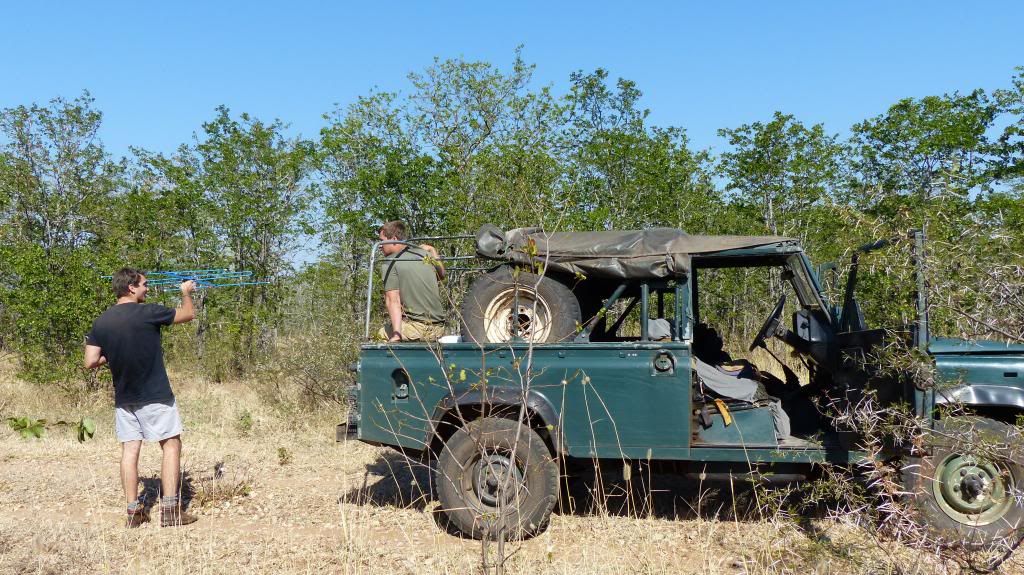 Even knowing their coordinates, they were surprisingly difficult to find. Often, they were resting in thick cover which we were unable to penetrate with the truck (Paul did say that he very quickly learned that lion react way differently to a person on the truck versus one on foot!). When lion want to hide, they are exceptional at it. Paul wanted to dart the male lion pictured below in order to obtain DNA, but was unable to draw him out of the cover. 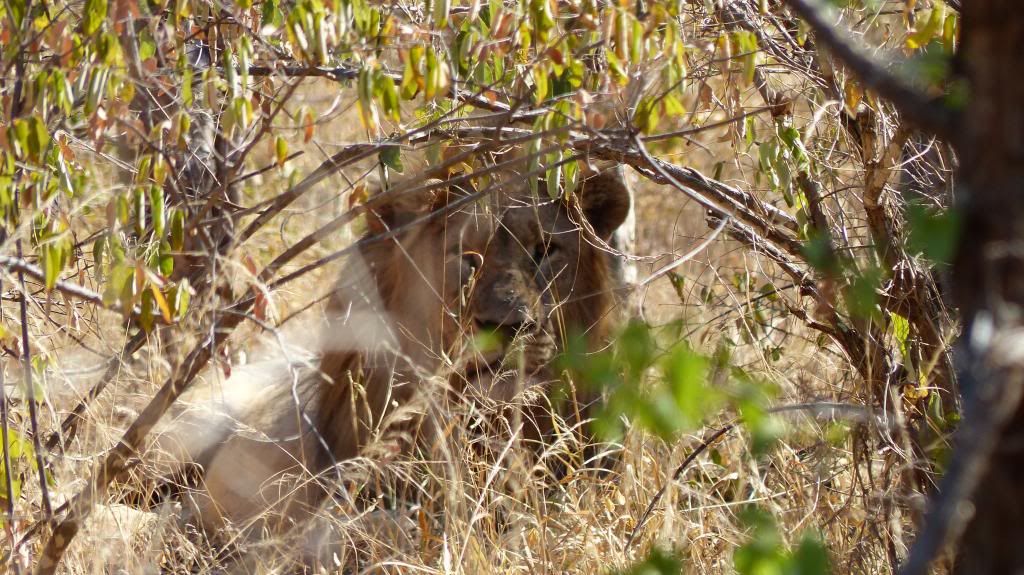 The prides with cubs were a bit easier to locate. This is a pride of seven, two mature females and five cubs. 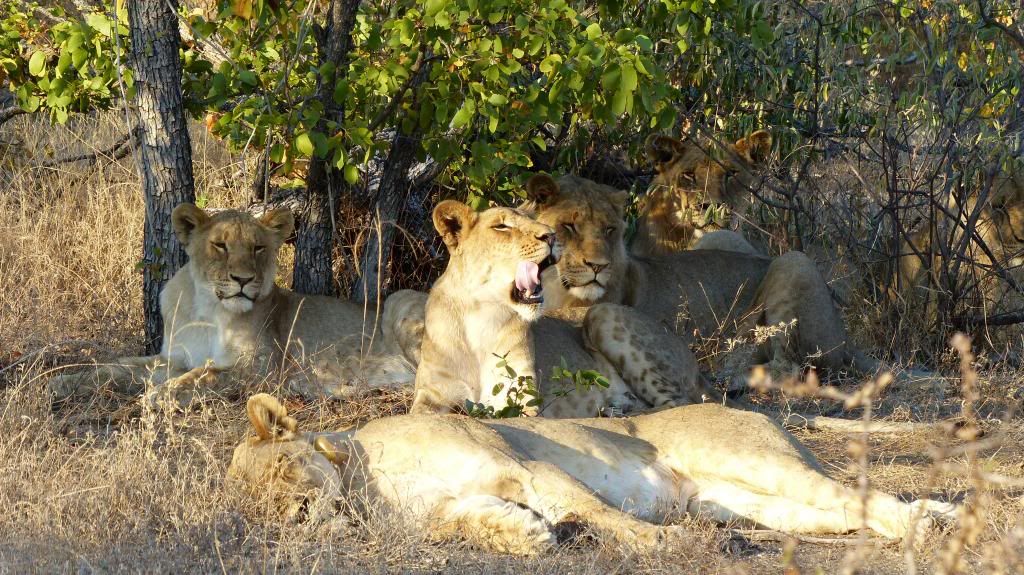 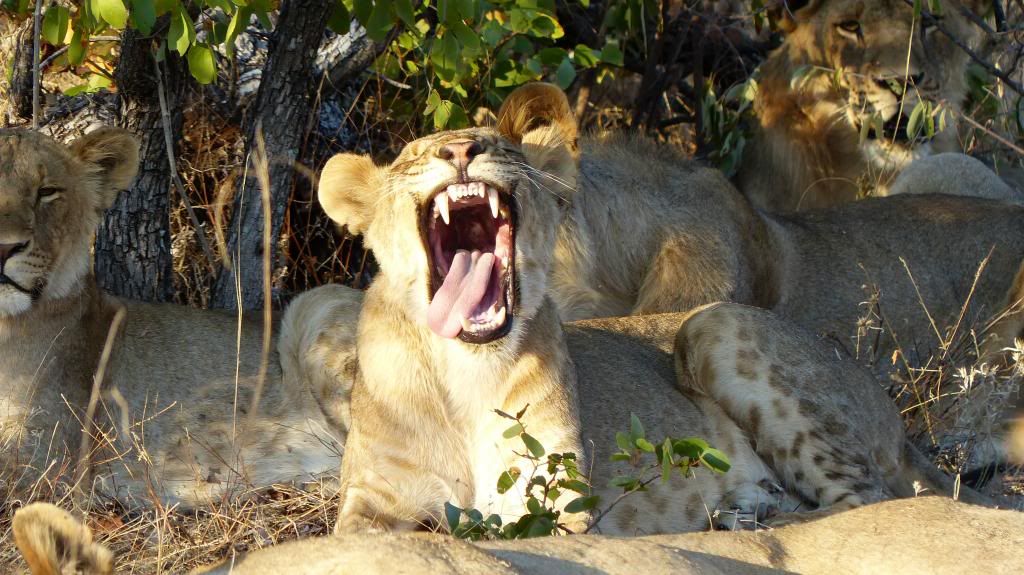  On the way back to camp, Paul attempted to get a bead on a recently collared male to see how he was doing, and if he was still traveling solo.  The next morning, windy conditions and cool weather complicated things, as the lion prefered to remain in thick cover. We located the collared male, and caught a glimpse of him before he slinked off into thicker bush. He had either made a kill the night before, or more than likely scavenged it from a pride of females, given the tracks. A nice ~54” kudu – just the type of trophy we were looking for a few days earlier! All indications were that he was doing fine. 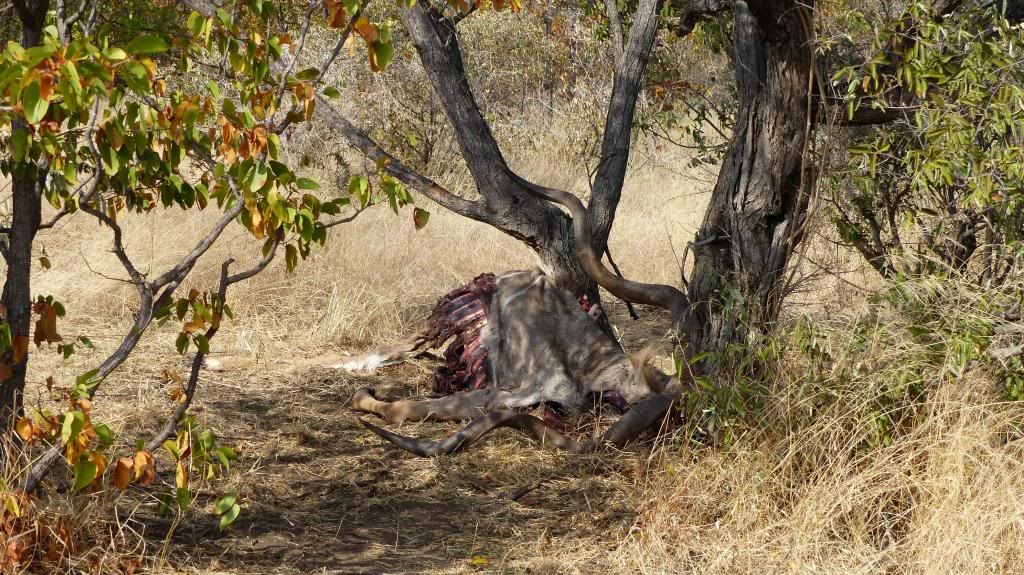 There are researchers interested in the brown hyena found in the BVC. We walked into a known den site, and hung two trail cams. Interestingly, the hyenas share their den site with a family of warthogs.  Before driving to camp for lunch, Paul attempted to dart a lioness so that he could switch the radio collar to a newer satellite collar. We found her position, but were unable to drive the Land Rover to where she was resting. Paul played an electronic game call of a squealing pig to no avail. In the afternoon, we drove to the western fence line of the conservancy where the data collected indicated that a collared lioness had stopped several times last month. Typically this indicates that a kill was made, and Paul was curious as to what the prey might have been, and if the lioness was using the fence to aid her in hunting. We located the first kill which was about 1km off the dirt track. The skull was removed and carried back to the truck for the BVC. 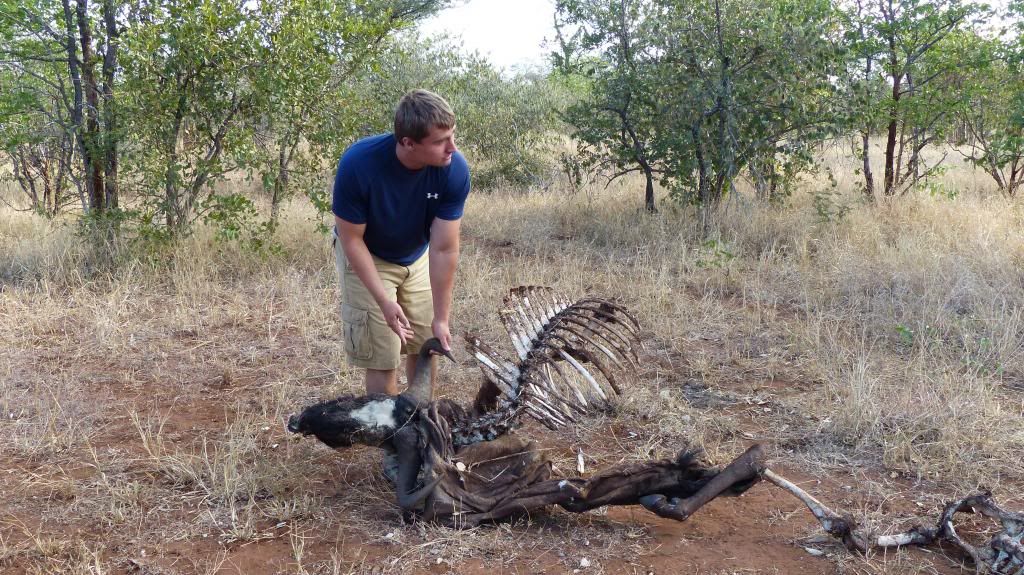 The next three sites were dry, which was odd as the data shows that approximately 80% of GPS identified pauses in movement correlate to kills. However, this female had cubs which could be why she spent time in a particular area, and/or an impala kill site could easily be missed if the bones were carried off by hyena or other scavengers. In the course of our travels, on the road we met Martin Nel, who was hunting lion with Tom from Texas. Tom is a chicken farmer, and at 6”10” is one of the most imposing figures that I have ever met. But as with most Texans, he was very friendly, and anxious to hear all about our hunt and past experiences in Africa. Of course, now that we were not hunting them, we drove by this guy: 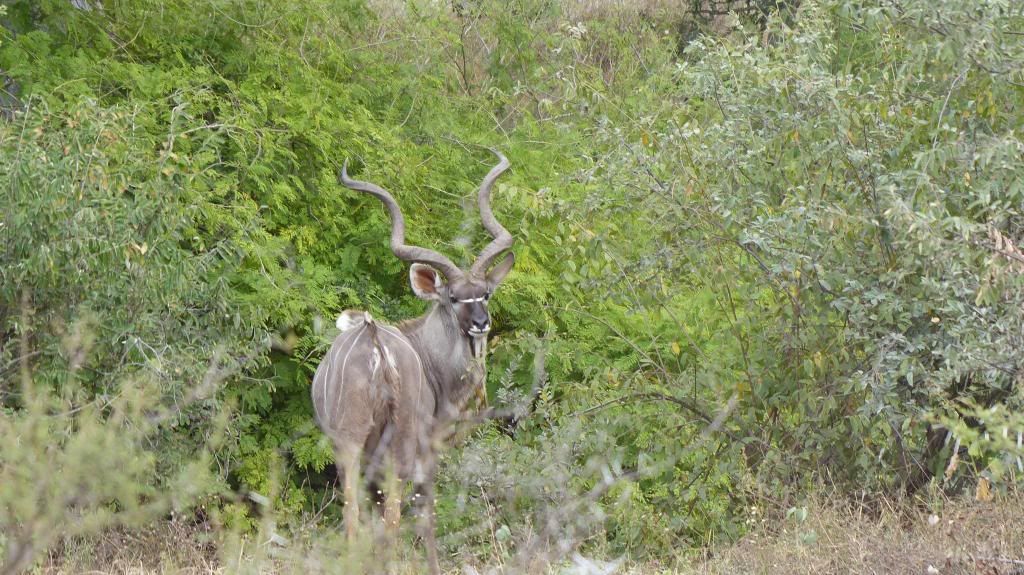 The final morning of our stay at the BVC was cool and cloudy, but the winds had stopped. I said to Brett that I had a feeling that it was going to be a great day! On the main dirt road out of Chamalaya, we came across a mature lioness, who was apparently stalking two Kori Bustards. Paul attempted to dart her, but she would not leave the thick bush in which she was hiding, and again the distressed piglet call was not effective. The primary objective of the day was to locate “Matilda”, a 5 year old lioness that had an older GPS collar that only sends bursts of data, and replace it with a new Satellite collar that allows for real-time tracking. Paul advised us that if we find her, we need to be careful, as she often travels with a very aggressive female. We struggled to pinpoint her exact location, despite narrowing down the search using the radio collar. Eventually, Paul got a bead on her, and setup the caller, this time using a distressed bird call. Positioning the truck 25 meters from the call, Paul remotely activated the device. After several minutes, she responded and approached the tree to investigate. Paul hurriedly prepared the dart and injected it into the dart gun. She was humorous to watch, very much like a house cat in her movement. Beginning to lose interest, the lioness was not giving Paul a clear shot. When she finally stood broadside, Paul fired, the dart impaling itself just in front of the rear hindquarter muscle. She flinched at the impact, growled a little bit, then casually walked off. Given the dosage amount and location of the dart, we gave her 15 minutes. She was fast asleep when we reached her. Paul is calm and methodical, and immediately set to work. He covered her eyes, and instructed us to not make any sudden loud noises. I took Paul’s .458 and stood guard in case her sister showed up. 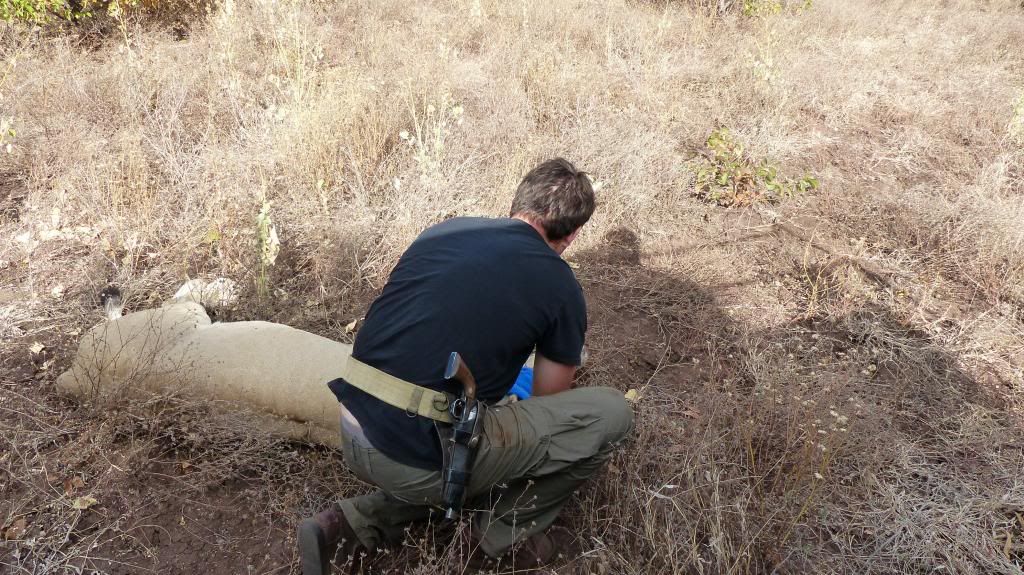 She had made a kill, a zebra foal, which was stashed under a tree. Obviously this is where she had been hiding, and although only 20 yards from the road, was impossible to see. Why the distressed bird call worked is beyond me, curiosity perhaps, or like any cat it is hard to resist an easy target even with a full stomach. 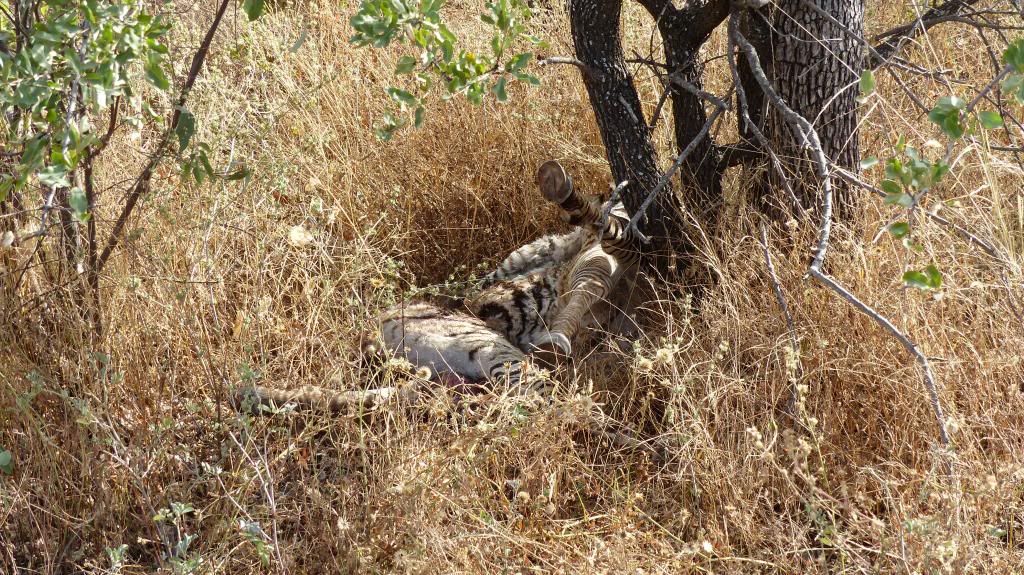 With her front paws tied, Brett removed the old collar, and installed the new one. 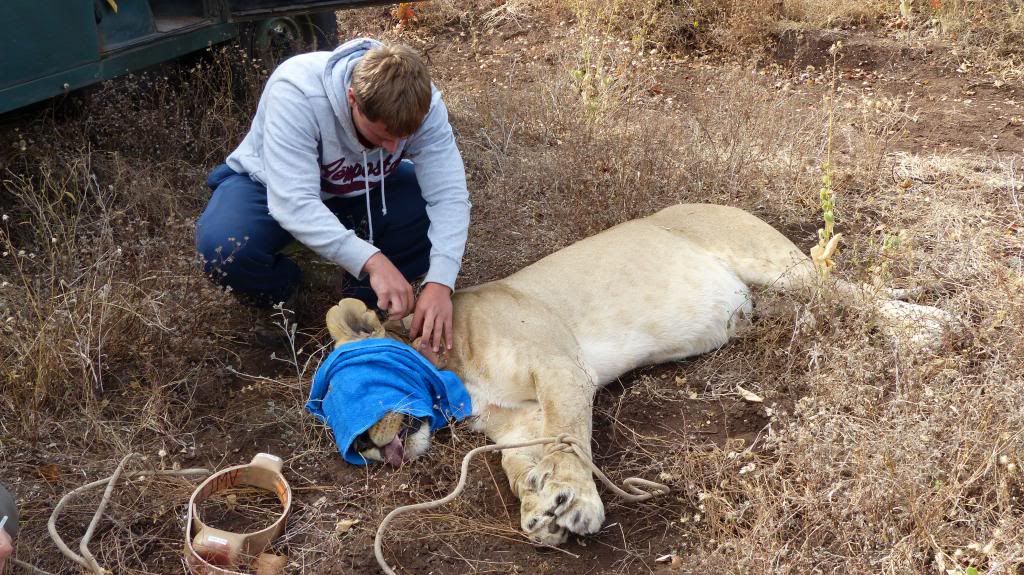 A minor incision was made to remove the needle of the dart, and the area cleaned.  Ointment was applied to her eyes to keep them moist. 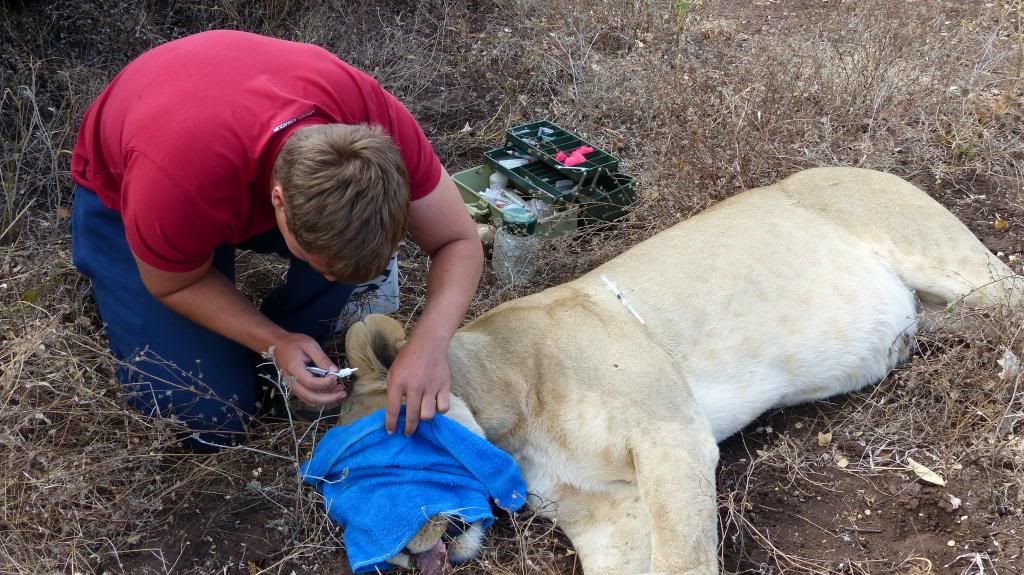 Measurements were taken, including of her top and bottom canines, neck to tail, tail, and paws. Hair samples were gathered for isotope testing. 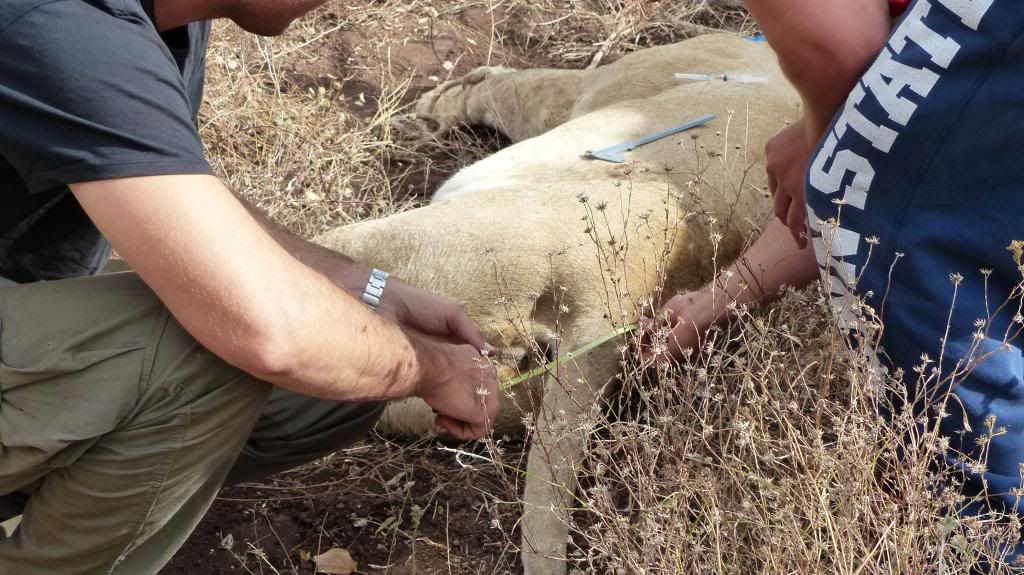 We snapped a few quick pictures, and administered the antidote.  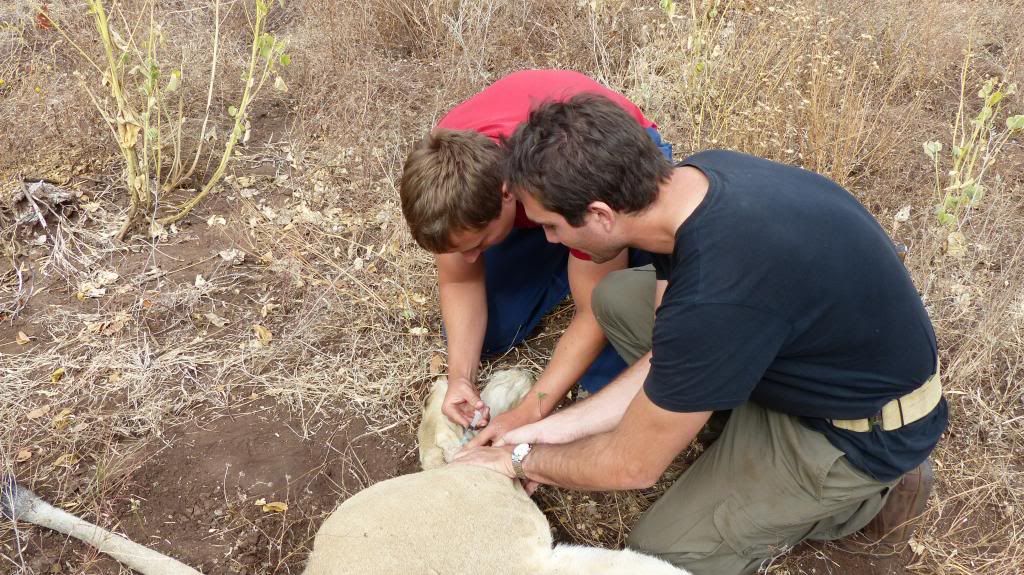 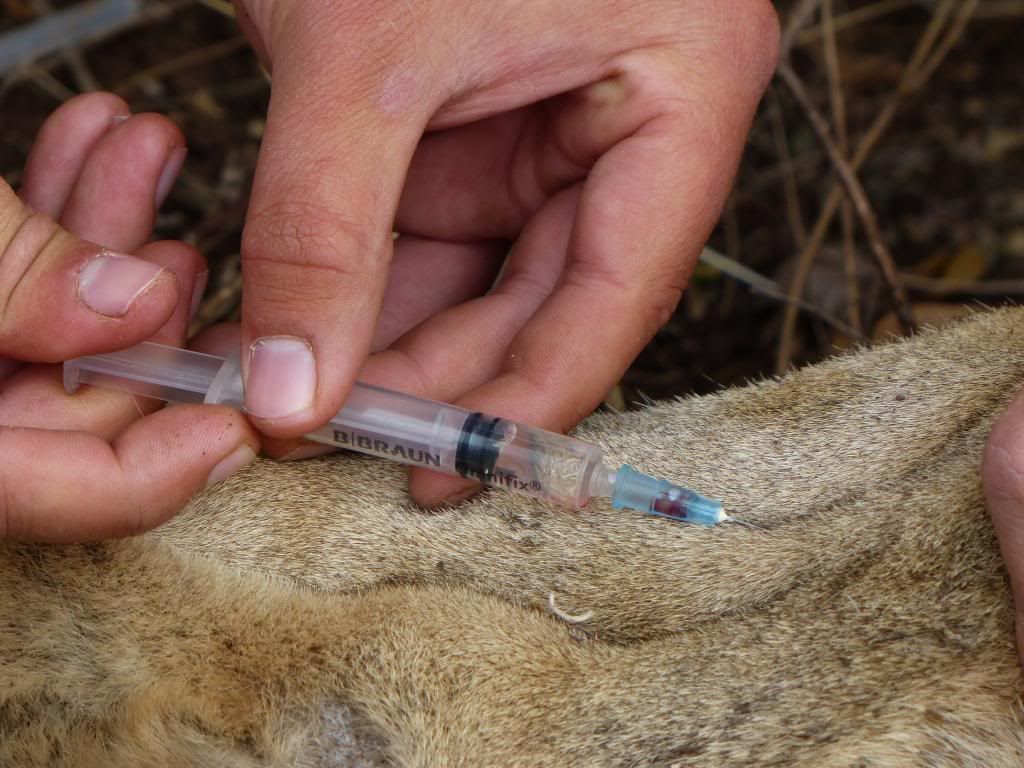 After about 15 minutes, she began to twitch. Paul said that she was likely awake, but just chilling, with the cover still over her eyes. Her breathing was monitored throughout the process. Eventually she sat up, then stood, obviously a bit groggy but seemingly no worse for the wear. We stayed by her for another 10 minutes, so that next time Paul needs to dart her, she will hopefully not be shy. 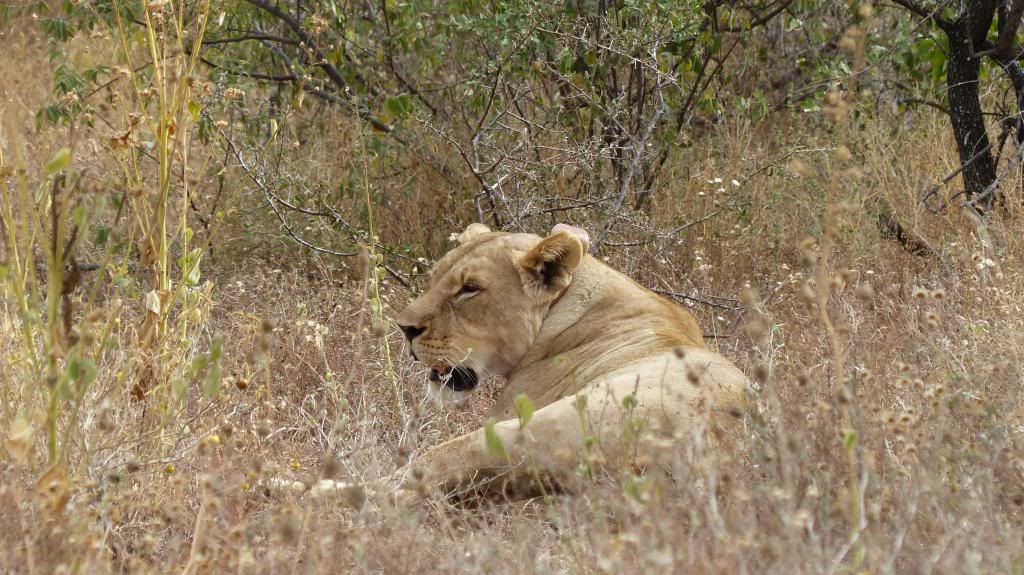 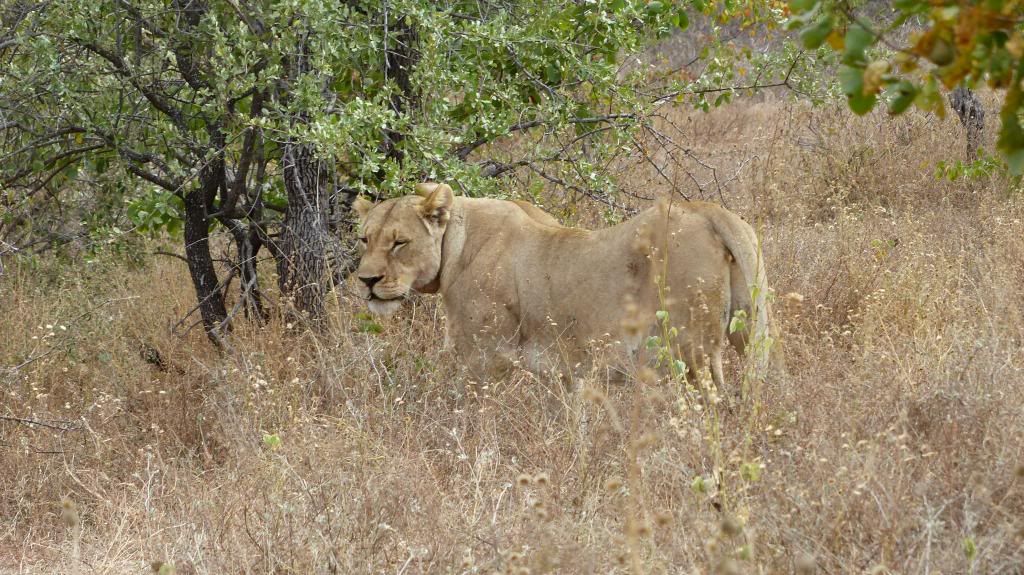 Back at Chamalaya, I did some long-range shooting, with the Panasonic. The water hole was busy, with wildebeest, warthog and zebra coming to drink. 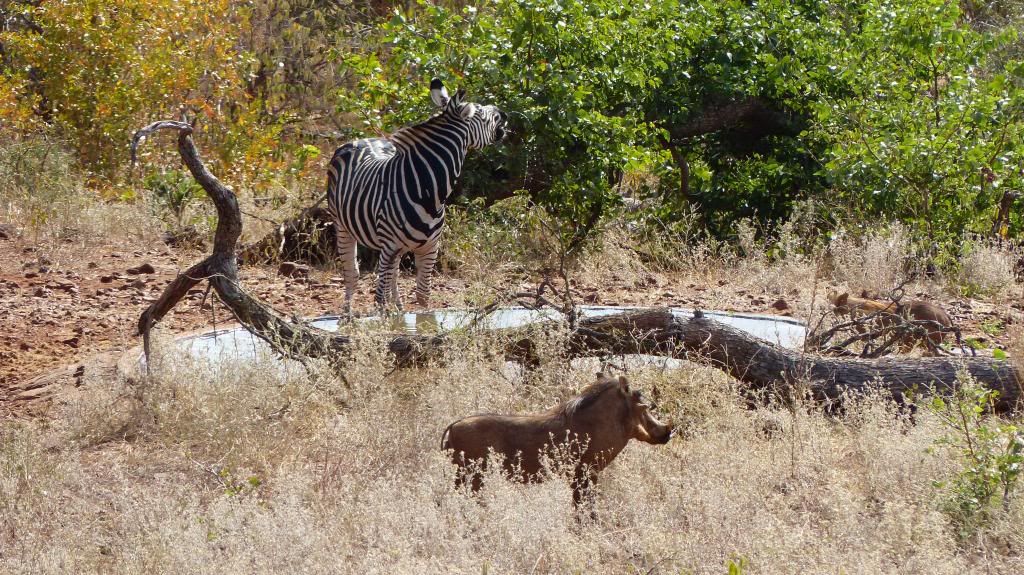 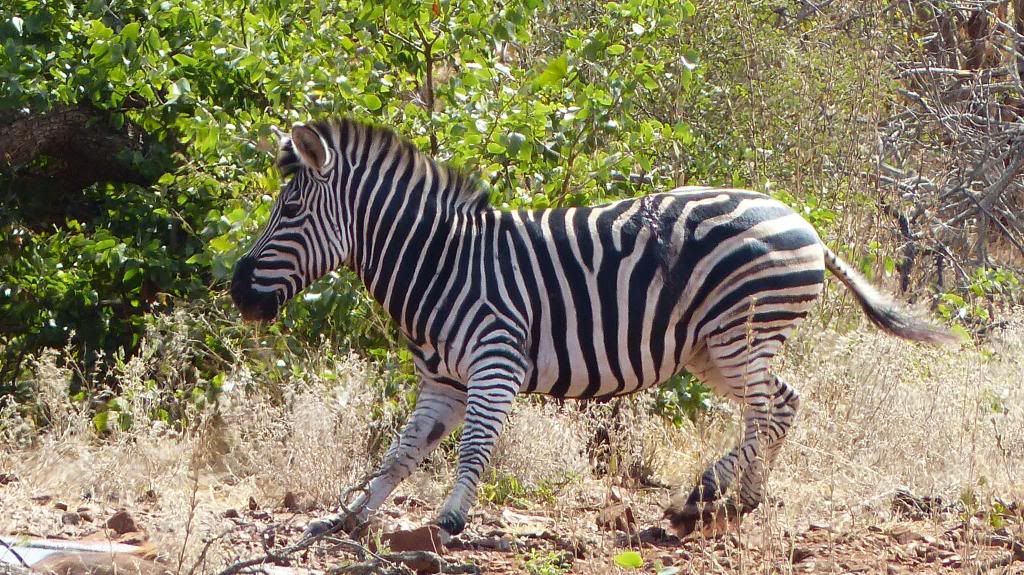 At 2pm, we headed back out to look for a big male who had not moved for four days, per the GPS data. This could mean that he had a large kill, was sick, or had died. We scoured the bush, first via the truck then on foot, and found the remains of a wildebeest, but no lion. At least we knew he was alright. 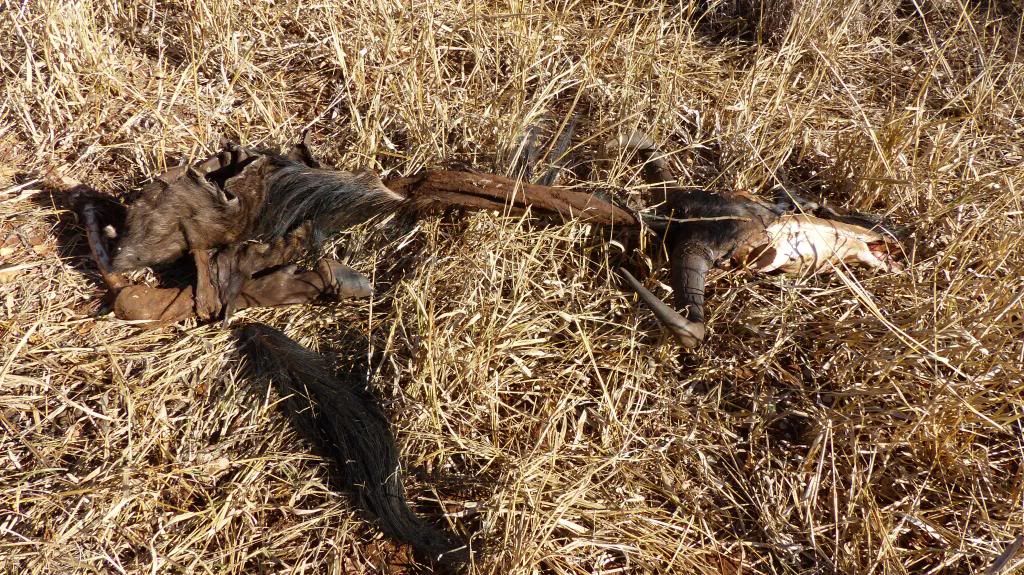 Leaving the area, Brett caught a glimpse of a wild dog quickly moving though the trees. We followed after them on foot, searching for a possible den that could be monitored. It appeared as thought they were just passing through. Six in total, they are somewhat of a rare sight in the BVC. I tried to take some pictures, but was unable to penetrate the brush with the zoom. 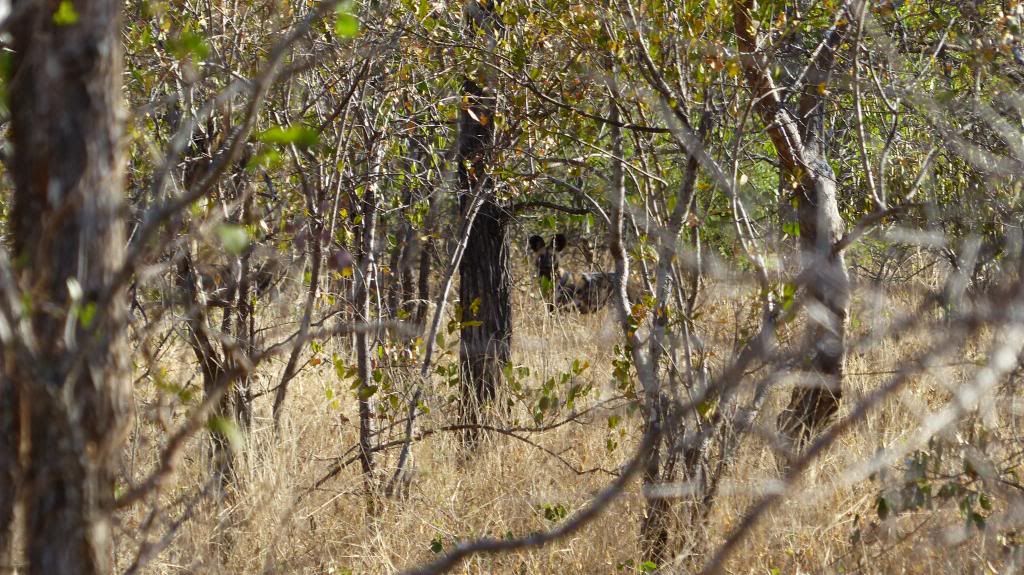 According to the Mazunga website, there are in excess of 3000 buffalo in the BVC, and the herd is growing annually by 20%. However, up to this point we had seen exactly two bulls while walking, and for just a split second. Obviously if one is hunting buffalo, the PH’s know where they are, and this is the area you will concentrate on. It is interesting though, how the game moves around the conservancy, just as it does in open concessions. 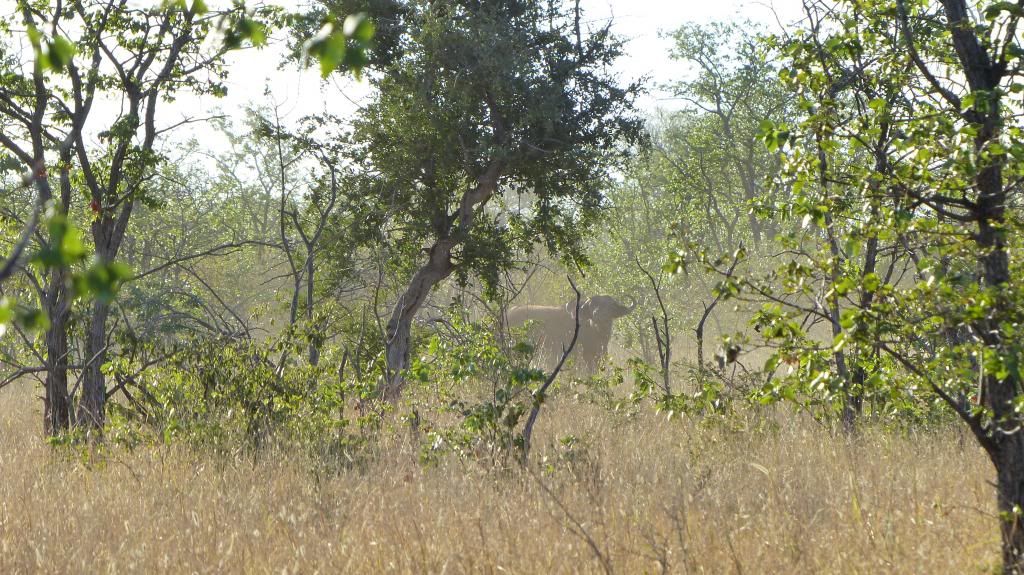 In the remaining daylight, Paul tried to locate the two big males that we had tried to dart on the first day. Once again, they were in the thick bush, and we had to leave them. I wondered how many lion we had driven – or walked by – while hunting. Paul said that there was another lion in the area, a 5-6 year old who traveled with two other males. We found them, and luckily they were in the relative open and with full stomachs, relaxed. The male sporting the collar was heavily scarred, with a poorly developed mane, which in a hunting concession is probably not a bad thing if you are a lion. 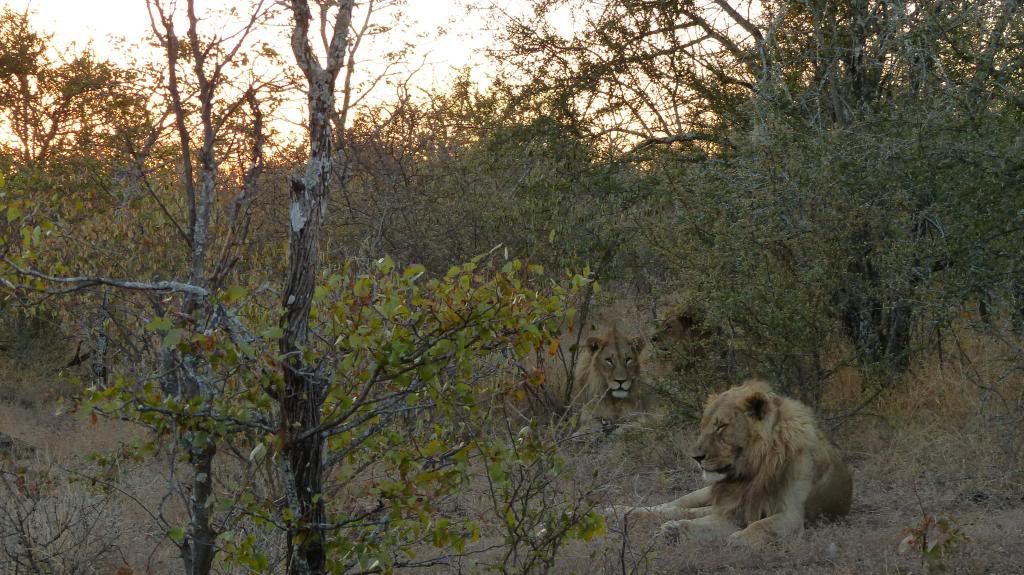 The other two males were younger, and although Paul was reluctant to provide a precise age, he estimated them to be 4.5 years old. The shyer male was developing a nice black mane, whereas the other was blonde. Despite being VERY close (15 feet...in an open Range Rover), the light was poor and most shots were into the setting sun. 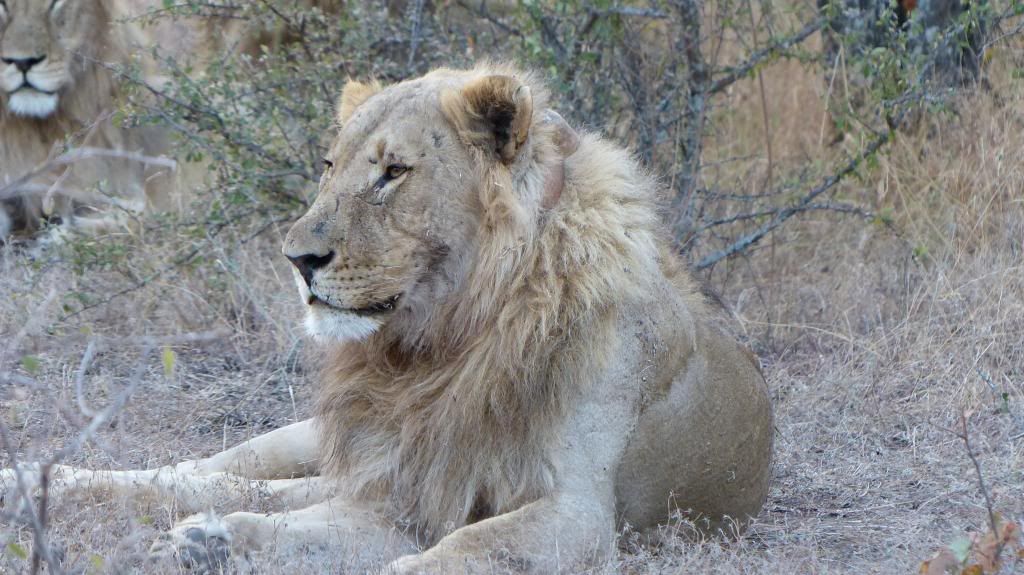 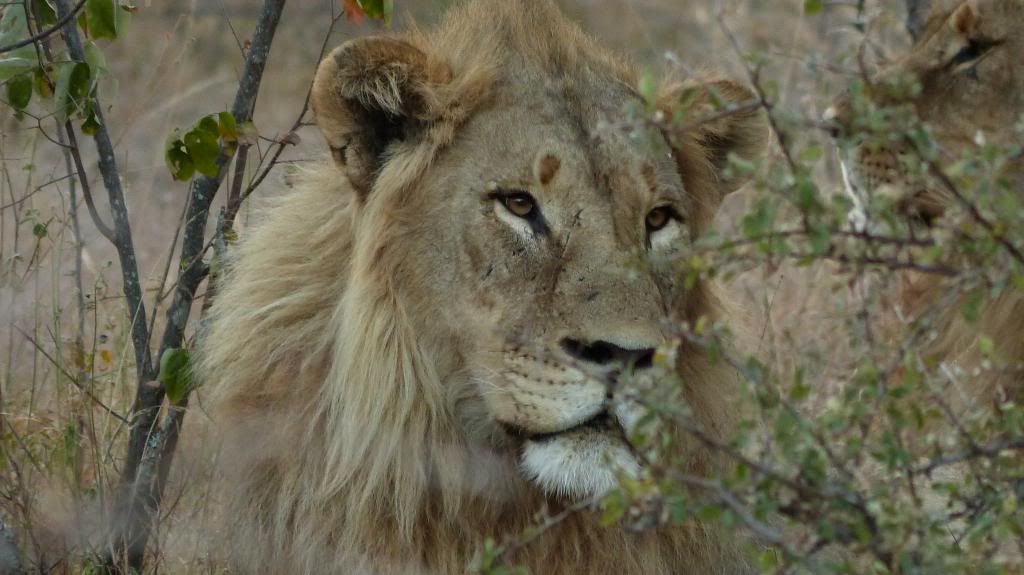 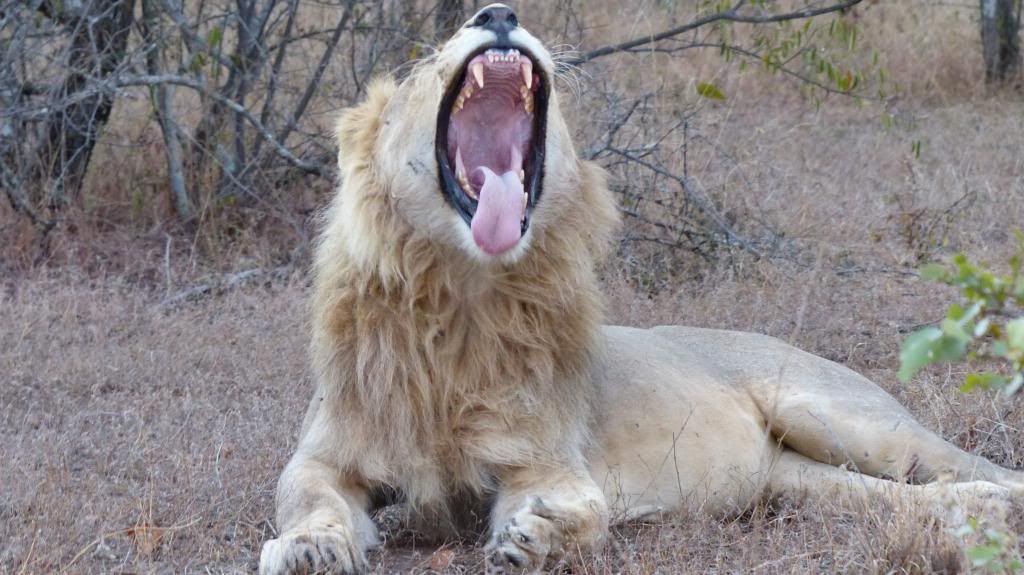 The real show started just as the sun began to set, and it is something that Brett and I will never forget. A lion’s call can carry for miles, it is how they signal their presence to other area males and communicate with members of the pride. Perhaps these lion call every night, or maybe the females were close by noting that when the wind blew a certain direction we could smell a kill nearby. Whatever the reason, once they got going it was something to behold. On both occasions the older male would start first, joined quickly by the other two. Similar to when a nitro funny car goes down the strip, you feel the sound. It is awe-inspiring and terrifying at the same time. There is not a word in the English language to describe the combination of deafening sound and guttural reverberation.  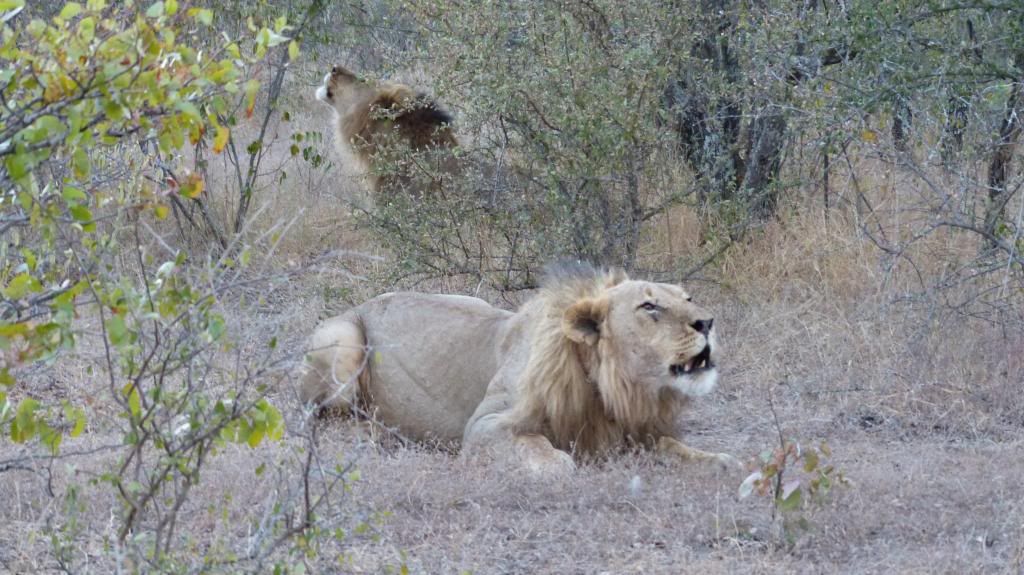  As with the grand finale at a fireworks show, I desperately tried to hold on to every moment, not wanting it to end. But, just like that, it did.  | |||
|
| one of us |
Hi guys, here's some "light reading" for the holidays! I'll be tweaking here and there as I find all my tyops. (EDIT 12/27 - DONE!!!!!) Please let me know if you have any questions, and thanks as always for taking the time to share my hunt with me. Bill | |||
|
| One of Us |
Thanks Bill. Great reading so far. Awesome pics as well. Happy Holidays to you too. Cheers Mark | |||
|
| One of Us |
Great Story Bill. But could you post some pictures?... Jeff | |||
|
| One of Us |
Again another great hunt and report. Thanks so much Bill. Looks like you and your son had a super time. The only easy day is yesterday! | |||
|
| One of Us |
Great report. Looks like your trip was very sucessful. Congrats. | |||
|
| One of Us |
Awesome Bill, thank you for taking the time to put that report together! Amazing photos, and there's no place quite like the BVC! I stayed in Dyers when I was there, but really enjoyed seeing all of their camps as well. They're all fairly nice, but all very different. Greg Brownlee Neal and Brownlee, LLC Quality Worldwide Big Game Hunts Since 1975 918/299-3580 greg@NealAndBrownlee.com www.NealAndBrownlee.com Instagram: @NealAndBrownleeLLC Hunt reports: Botswana 2010 Alaska 2011 Bezoar Ibex, Turkey 2012 Mid Asian Ibex, Kyrgyzstan 2014 | |||
|
| One of Us |
Well done Bill! Nothing like taking your son to Africa. I will set down with a cold one tonight and take this report all in and as well as the Fantastic pics. | |||
|
| One of Us |
The master is back!!!! Great report.... | |||
|
| One of Us |
wow - great report | |||
|
| One of Us |
Great Pictures!! Well done. | |||
|
| One of Us |
Fantastic Bill! | |||
|
| one of us |
Great pictures, Bill, Thanks Frank "I don't know what there is about buffalo that frightens me so.....He looks like he hates you personally. He looks like you owe him money." - Robert Ruark, Horn of the Hunter, 1953 NRA Life, SAF Life, CRPA Life, DRSS lite | |||
|
| One of Us |
Another great report from Bill C. No surprise there! Very nice narrative and pics, thanks for posting it. | |||
|
| One of Us |
Nice job Bill, I never tire of your reports. Well done!! ______________________ DRSS ______________________ Hunt Reports 2015 His & Her Leopards with Derek Littleton of Luwire Safaris - http://forums.accuratereloadin...6321043/m/2971090112 2015 Trophy Bull Elephant with CMS http://forums.accuratereloadin...6321043/m/1651069012 DIY Brooks Range Sheep Hunt 2013 - http://forums.accuratereloadin...901038191#9901038191 Zambia June/July 2012 with Andrew Baldry - Royal Kafue http://forums.accuratereloadin...6321043/m/7971064771 Zambia Sept 2010- Muchinga Safaris http://forums.accuratereloadin...6321043/m/4211096141 Namibia Sept 2010 - ARUB Safaris http://forums.accuratereloadin...6321043/m/6781076141 | |||
|
| One of Us |
SUPERB!!! Thank you | |||
|
| One of Us |
Congratulations on a great hunt with your son. As usual you have written a great report with fantastic pics. Thanks for sharing. | |||
|
| One of Us |
Wow that was one helluva experience.thank you for sharing. I love the fact that Lion research is being done on A HUNTING AREA DUE TO THE LARGE NUMBER OF LIONS IN THE AREA !! Sustainable use Dave Davenport Outfitters license HC22/2012EC Pro Hunters license PH74/2012EC www.leopardsvalley.co.za dave@leopardsvalley.co.za +27 42 24 61388 HUNT AFRICA WHILE YOU STILL CAN Follow us on FACEBOOK https://www.facebook.com/#!/leopardsvalley.safaris | |||
|
| One of Us |
Fantastic report. Thank you for taking the time to share it with us. JCHB | |||
|
| One of Us |
Glad you found the opportunity to get close to nature and do your own thing. The Eland were a bonus. ROYAL KAFUE LTD Email - kafueroyal@gmail.com Tel/Whatsapp (00260) 975315144 Instagram - kafueroyal | |||
|
| One of Us |
Proper in-depth report that and an awesome experience with your son - well done Bill. | |||
|
| one of us |
Bill, Congratulations on another great father/son adventure. Once again, a well written hunt report and some nice trophies made your report a pleasure to peruse. The double on eland had to be a special memory. Happy holidays to you and your family! On the plains of hesitation lie the bleached bones of ten thousand, who on the dawn of victory lay down their weary heads resting, and there resting, died. If you can talk with crowds and keep your virtue, Or walk with Kings - nor lose the common touch... Yours is the Earth and everything that's in it, And - which is more - you'll be a Man, my son! - Rudyard Kipling Life grows grim without senseless indulgence. | |||
|
| One of Us |
Bill, I never tire of reading the reports of your adventures,this one is no exception! Congratulations on time well spent with your Son. Matt | |||
|
| One of Us |
Bill, Great report as usual. Thanks for posting. The BVC is a special place. Doug | |||
|
| One of Us |
Great report, as usual. Thank you for taking your time / P-A | |||
|
One of Us |
Bill always a wonderful read. Mike | |||
|
| new member |
Outstanding report and pictures. Thanks for all your effort and sharing. Don | |||
|
| One of Us |
Great photos and report. | |||
|
| One of Us |
I wondered why if the hunt was in June you were just getting around to posting a report. Then I realized that you have been writing it since June. That said, I apologize for posting comments so late but I had to break for meals. All kidding aside Bill, a great report as always -- it sets the standard -- filled with wonderful pictures. Congrats on a great trip. Have a Merry Christmas. Mike | |||
|
| One of Us |
Bill, the problem is simple. Your reports are always so lacking of any detail, why is that? Awesome stuff man!!!!! | |||
|
| One of Us |
it would have taken me 2 years to type a report that long( 1 finger at a time, of course). damn well done, Bill Vote Trump- Putin’s best friend… | |||
|
| one of us |
Proof again that any safari is twice as rewarding if you take your son or daughter. The detail in your report brings the whole safari to the rest of us - almost like being there. ALLEN W. JOHNSON - DRSS Into my heart on air that kills From yon far country blows: What are those blue remembered hills, What spires, what farms are those? That is the land of lost content, I see it shining plain, The happy highways where I went And cannot come again. A. E. Housman | |||
|
| One of Us |
Bill, A privilege to have spent a little time with you guys at ASGH. I consider that stay a part of any trip to Africa! Your report details bring the trip alive again and wish like hell we were meeting you guys AGAIN this May!!! That being said, I have probably made my last trip to the BVC. After 4 trips and countless clients, I too am treated like a red headed stepchild by the manager. When I can't pick the camp or ph for myself or my friends (two years in advance) then time to move on. I'm guessing they are so fully booked that you can kick sand on your "old" clients and not worry about them. Such is life! My fondest memories at the end of the road will be the time spent with my son on the BVC and the sound of doves cooing in the distance. Can't get much better than that and I'm sure you feel the same. Best of luck to you and your son in future hunts and Merry Christmas! | |||
|
| One of Us |
Bill, Thanks again for yet another interesting report BVC seems like an amazing plac, and the prizes for a plains game hunt is actually not bad Merry Christmas! | |||
|
| one of us |
Very enjoyable reading for the Holidays, Bill. Good pix for sure. Best of the Season, Tim | |||
|
| One of Us |
Great report. Love the pics some,really good shots. That Kudu you saw when not hunting looked like a real stud. Thanks. Bruce | |||
|
| One of Us |
Wow Bill, hell of a story. Just found it last night and took two nights to read it all. Everyword enjoyed well. Then there's the many great pictures to add more pleasure. Many thanks for sharing it all with us. Regretfully I never got to make such a trip with my Dad. Though we spent many yrs hunting elk together and with others while I was growing up and a few later. Besides that, I spent my high school summers five yrs on the same ranch "playing n hunting" with the rancher learning the area well enough I was used to guide some of the out of staters that came in. Had great time and learned a whole lot from watching and listening to how it's done, or should be done in some cases. I'm sure Brett feels the same way from these yrs tagging along with you. George "Gun Control is NOT about Guns' "It's about Control!!" Join the NRA today!" LM: NRA, DAV, George L. Dwight | |||
|
| One of Us |
+1 Some great memories reading this report. | |||
|
| Powered by Social Strata | Page 1 2 |
| Please Wait. Your request is being processed... |
|
 The Accurate Reloading Forums
The Accurate Reloading Forums  THE ACCURATE RELOADING.COM FORUMS
THE ACCURATE RELOADING.COM FORUMS  Hunting
Hunting  Hunting Reports - Africa
Hunting Reports - Africa  BVC Father/Son PG Hunt + Lion Research Project
BVC Father/Son PG Hunt + Lion Research Project

Visit our on-line store for AR Memorabilia

